I tested 2025's most realistic AI voice tools — here’s what blew me away
AI voice technology has been moving fast for a while now. But recently, it feels like we‘ve shifted into a completely different gear. We’re not just talking about smoother narration or cleaner text-to-speech anymore. These tools are starting to sound like actual people, with emotions, […]
MarketingFrom third-party cookies to zero-party data: The new rules of email engagement
A few days ago, Jane was browsing for new sunglasses. Before she knew it, every site she visited was showing her relevant ads. It wasn’t magic. Just algorithms working with behavioral data. But data collection is no longer something we can do in the background. […]
MarketingHow I localized AI-generated emails for international markets without losing the human touch
Earlier this year, I was handed an AI-generated content project with a deceptively simple goal: adapt email messages for international audiences. This wasn’t my first time navigating global nuance. With an MBA in International Business and experience working on a global consulting project in Portugal, […]
Marketing



How to Choose the Right Forecasting Technique [+ Expert Insight and Data]
Forecasting can feel like a dark art — part science, part intuition, and a dash of hoping for the best. But as businesses face increasing pressure to predict everything from sales targets to inventory needs, relying on gut feelings just doesn’t cut it anymore. I’ve […]
SalesForecasting can feel like a dark art — part science, part intuition, and a dash of hoping for the best. But as businesses face increasing pressure to predict everything from sales targets to inventory needs, relying on gut feelings just doesn’t cut it anymore.
I’ve spent weeks talking to forecasting experts, sales leaders, and business owners about how they actually approach forecasting (not just how they’re supposed to). What I discovered is that while the methods may sound intimidating, the core principles are more approachable than you might think.
Whether you’re trying to avoid another inventory stockout or looking to make smarter revenue predictions, I’ll walk you through the most practical forecasting methods and help you choose the right approach for your business.
Table of Contents
- What Is a Forecasting Method?
- Best Forecasting Methods
- How to Choose the Right Forecasting Technique
What Is a Forecasting Method?
A sales forecasting method is a systematic approach to understanding future possibilities based on both historical data and human insight. In B2B, this often means combining hard numbers (like pipeline data) with qualitative inputs (like sales rep confidence levels).
All of this can help you know what to expect the next month, quarter, and even fiscal year to look like.
“Forecasting feels like having a backstage pass to the future of our market,” says Chris Bajda, Managing Partner at Groomsday. “By tapping into data from previous seasons and current trends, we’re able to predict what our customers will need and when.”
I’ll share an example to help make this concrete. Imagine I run a coffee shop. A simple forecasting technique might just look at last year’s sales and add 10% for growth. But a more sophisticated approach would consider:
- Seasonal patterns (iced drinks in summer, holiday drink specials).
- Day-of-week trends (busy weekday mornings vs. leisurely weekends).
- Local events (nearby office closures, construction projects).
- Market changes (new competitor opening nearby).
- Economic factors (inflation affecting coffee bean prices).
The impact of forecasting can be dramatic. An analysis by Dgtl Infra found that when they used integrated forecasts (combining sales data, usage metrics, and market trends), they closed 31% more revenue than those relying on pipeline data alone.
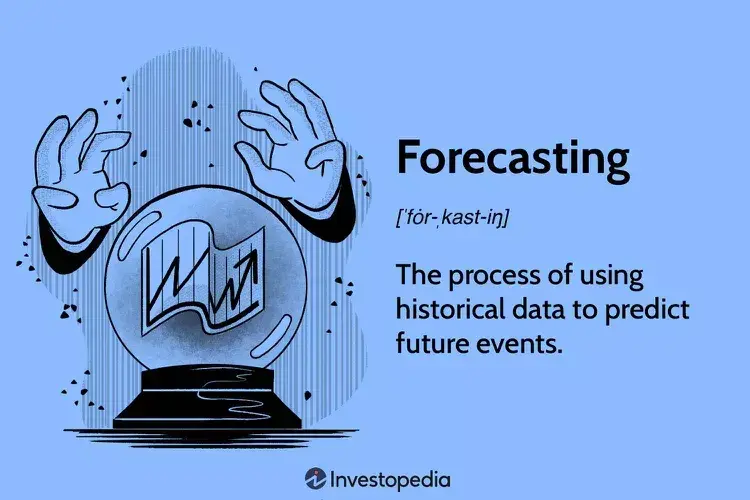
Pro tip: If you’re looking to brush up on your forecasting skills, I recommend checking out these free courses in HubSpot Academy: Forecasting and Analytics in Sales Hub and Hubspot Sales Forecasting.
Types of Forecasting Methods
Forecasting methods generally fall into two main categories: qualitative and quantitative approaches. I like to think of them as the “art” and “science” of forecasting — both valuable, but used in different situations.
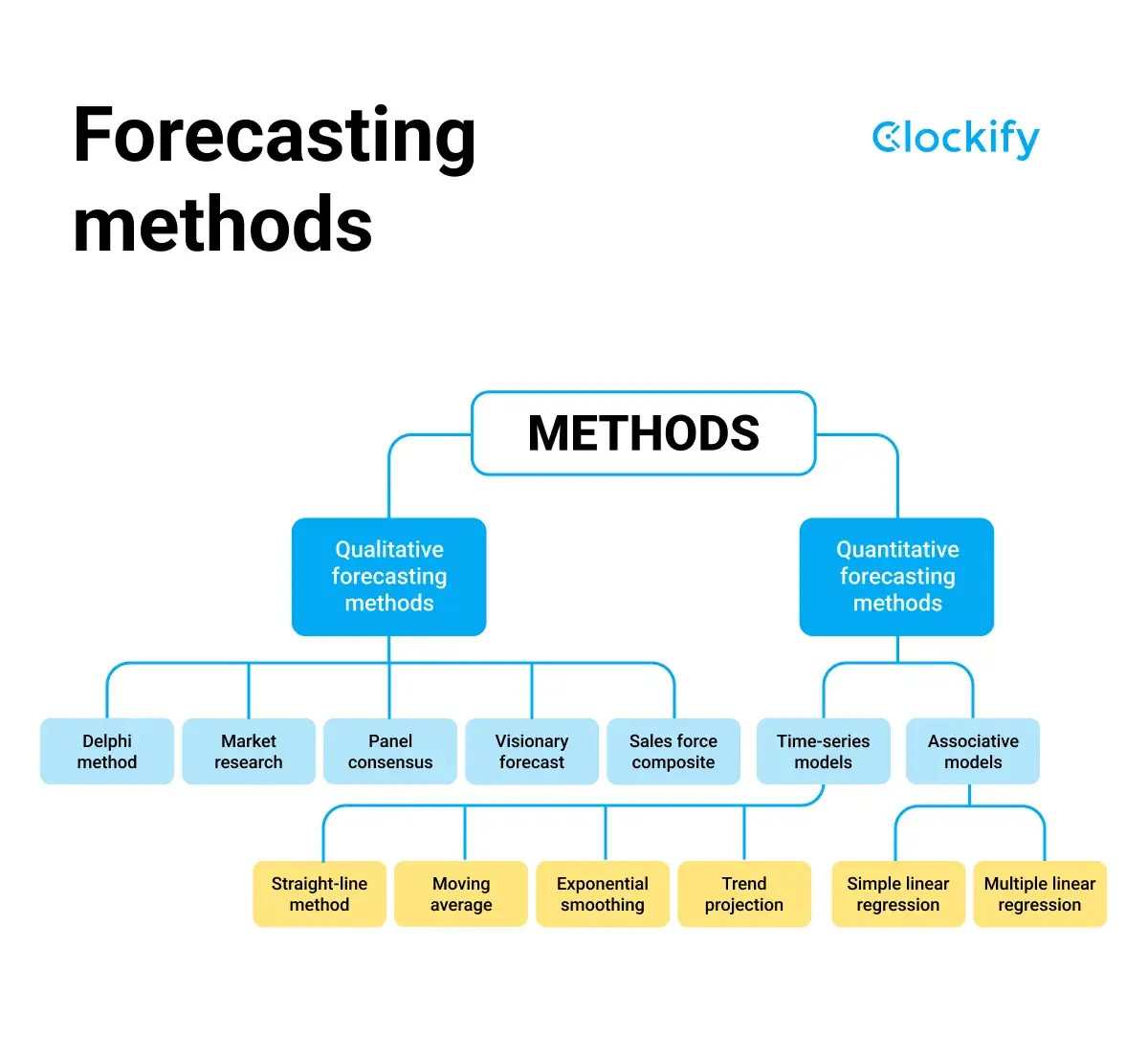
Qualitative Forecasting Methods
Qualitative forecasting methods shine when historical data is limited or when you’re venturing into new territory. They rely on expert opinions, market insights, and informed judgment rather than pure numbers.
For example, if you’re launching an innovative product with no direct competitors, you might use:
- Delphi Method (gathering expert opinions systematically).
- Market Research (customer surveys, focus groups).
- Expert Judgment (industry veteran insights).
Best for: New products, innovative industries, or sectors with limited historical data.
Quantitative Forecasting Methods
Quantitative forecasting is all about the numbers — using data-driven models to make predictions. Think of it as letting the data tell the story.
For example, a retail chain might analyze:
- Past sales data across all locations.
- Seasonal buying patterns.
- Economic indicators.
- Weather patterns.
- Customer behavior metrics.
Examples of quantitative forecasting include:
- Time Series Analysis.
- Moving Average.
- Exponential Smoothing.
- ARIMA.
- Regression Analysis.
- Machine Learning Models.
Best for: Stable, data-rich industries where historical patterns can reliably inform future predictions.
TL;DR? Many successful businesses actually combine both qualitative and quantitative methods, using data to inform decisions while still leaving room for human insight and market knowledge.
Best Forecasting Methods
In speaking with dozens of experts for this piece, one thing became clear to me: There’s no consensus on what method is “best.” The options vary widely depending on your end goals, your industry, the data you have available, and much more. It will also greatly depend on which forecasting software you choose.
That being said, here are some top forecasting methods that you may find helpful.
1. Time Series Analysis
Time series analysis is widely used for recognizing trends and seasonality in historical data; it’s a heavy hitter in the forecasting world. Many experts that I spoke with use time series as one of their methods.
Bajda from Groomsday explains, “Time series analysis is especially useful for businesses that experience seasonal peaks and valleys, like retail.” This method helps track cyclical patterns, allowing businesses to optimize inventory and marketing strategies for anticipated demand changes.
Below I explain specific types of time series analysis.
Moving Average
This is like taking your business’s temperature over time — it smooths out short-term fluctuations to show the real trend.
Here’s a simple example:
Q1 Sales: $100,000
Q2 Sales: $120,000
Q3 Sales: $110,000
Q4 Forecast = ($100,000 + $120,000 + $110,000) / 3 = $110,000
Exponential Smoothing
Exponential smoothing is like your business’s short-term memory. Just as you would remember what happened last week more clearly than last year, this method gives more weight to recent events.
Here‘s a real-world scenario: Let’s say I run a downtown lunch spot. My sales might look like this:
Monday: $2,000
Tuesday: $2,200
Wednesday: $1,800 (Unexpected rain)
Thursday: $2,300
Friday: $2,500
A simple average would say I make $2,160 per day. But exponential smoothing might predict closer to $2,400 for next Monday because it:
- Puts more emphasis on those strong Thursday/Friday numbers.
- Considers the rainy Wednesday an outlier.
- Spots the slight upward trend.
ARIMA Models
Auto Regressive Integrated Moving Average (ARIMA) is like having a master analyst who can spot complex patterns. While exponential smoothing is great for clear trends, ARIMA shines when things get messy.
Here‘s why it’s powerful. Let’s say I’m running an online fitness equipment store:
- January starts strong (New Year’s resolutions).
- Sales dip in February.
- March sees a mini-surge (spring fitness push).
- Summer is steady.
- September spikes again (back-to-routine season).
ARIMA can handle all these patterns plus:
- The lingering effects of past events (like how a viral TikTok video boosts sales for weeks).
- Multiple seasonal patterns (daily, weekly, and annual cycles).
- Irregular but predictable fluctuations.
2. Machine Learning Models
Machine learning has transformed forecasting by spotting complex patterns humans might miss. Dgtl Infra shared compelling results from combining AI with traditional methods.
Their data showed AI models identified enterprise user adoption growing 28% quarter-over-quarter, while sales team insights revealed financial services companies were integrating their API three times faster than other sectors — a critical pattern that pure data analysis missed.
They’re also the company I mentioned above that closed one-third more revenue when using an integrated forecast rather than just pipeline data alone.
Modern ML approaches include:
- Neural networks: Identifying hidden patterns in customer behavior.
- Random forests: Analyzing multiple variables like industry, company size, and usage patterns.
- Gradient boosting: Improving prediction accuracy over time by learning from past forecasts.
3. Scenario Planning
In B2B, where single deals can make or break a quarter, scenario planning is essential. This method helps you prepare for different possible futures rather than betting on a single forecast.
“If we’re promoting a video for a seasonal campaign, like Black Friday, we create multiple outcome scenarios based on varying budget allocations, engagement levels, and ad placement strategies. This way, we’re prepared to pivot as needed,” explains Spencer Romenco, Chief Growth Strategist at Growth Spurt.
Here’s an example:
Conservative Case
– Only deals with 90%+ probability.
– Minimal upsell revenue.
– Standard churn rate.
Base Case
– Deals at 70%+ probability.
– Historical upsell rates.
– Normal market conditions.
Upside Case
– Additional stretch opportunities.
– Accelerated deal velocity.
– New product adoption.
4. Sentiment Analysis
Understanding the deeper context of customer feedback can be as valuable as tracking pipeline metrics. Sentiment analysis moves beyond basic satisfaction scores to uncover meaningful patterns in customer behavior and market direction.
For example, Kratom Earth incorporates feedback from customer reviews, social media comments, and direct interactions in their forecasting process.
“We pay attention to the words customers use, the benefits or effects they mention, and even any concerns they share. If we notice a trend where people talk about increased stress or a desire for relaxation, this guides us to forecast a higher demand [for certain products],” says Loris Petro, Marketing Strategy Lead at Kratom Earth.
“This allows us to plan inventory and marketing efforts around actual customer emotions and needs, which we believe is extremely accurate.”
How to Choose the Right Forecasting Technique
To illustrate how you can go through the decision-making process, I’m going to use a fictional example. We’ll call her Hannah and she runs an online pet goods store. Her orders have grown from 100 to 1,000 a month and now she’s facing some headwinds.
“I’m struggling to predict demand. Last month, I ran out of our bestselling cat food. The month before, I had to discount excess dog toys. There has to be a better way than just guessing!”
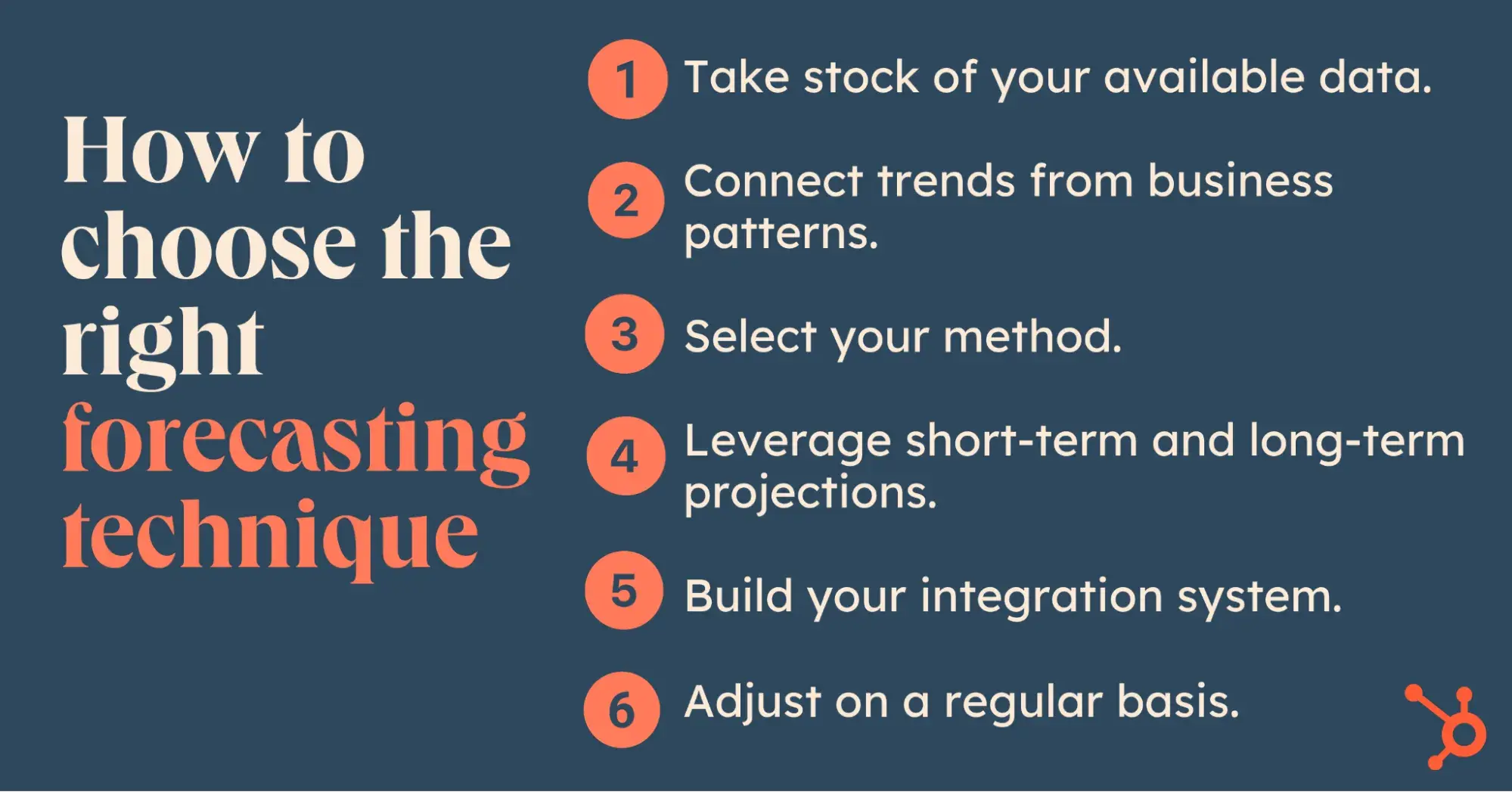
1. Take stock of your available data.
First ask yourself, what data do you have access to? Most businesses are sitting on more useful information than they realize. (P.S. This is where AI can be incredibly helpful!)
This could include:
- Shopify sales history.
- Purchase order records.
- Customer reviews.
- Email marketing metrics.
- Social media engagement.
In Hannah’s assessment of the data, she might find that cat products make 45% of her revenue, dogs make up 40%, and other pets are 15%. In her business, she also sees seasonal trends that cause her products to spike — things like pet costumes around Halloween and new pet supplies around Christmas.
Pro tip: “If you have a strong history of data, methods like time series can reveal powerful patterns,” Badja suggests. For industries experiencing rapid shifts, machine learning models that continuously update based on new data are better suited to capturing real-time changes.
2. Connect trends from business patterns.
The next step is to go one step beyond the data — find ways to connect the dots.
In Hannah’s example, she might be asking herself:
- “Why do certain products sell out while others sit on shelves?”
- “How do holidays affect different product categories?”
- “What’s causing these random spikes in certain items?”
By looking closely at the patterns over the past few months, you’ll likely spot some key trends. For instance, Hannah could discover that 90% of customers reorder every six weeks, sales spike after email promotions, and the weather doesn’t impact sales.
All of these discoveries offer helpful insight into her customer’s buying patterns and how she can better predict future sales.
3. Select your method.
Now comes the fun part — choosing your forecasting approach. Let‘s look at different methods through Hannah’s lens.
For example, if Hannah calculated the simple average across the last few months, she wouldn’t end up with any results that she could use to predict the future.
Simple Moving Average
Last 3 months sales:
- January: 800 orders
- February: 900 orders
- March: 1,000 orders
- Basic forecast: (800 + 900 + 1,000) / 3 = 900 orders
However, a multi-factor method could better account for her business’s growth rate and seasonal patterns.
Product Forecast =
(Base Average)
× (Growth Factor)
× (Seasonal Factor)
× (Marketing Impact)
Example for Premium Cat Food:
Base Average: 302 units
Growth Factor: 1.15
Seasonal Factor: 1.0 (non-seasonal)
Marketing Factor: 1.2 (email campaign planned)
June Forecast = 302 × 1.15 × 1.0 × 1.2 = 416 units
Pro tip: Make sure you are factoring in both qualitative and quantitative data.
4. Leverage short-term and long-term projections.
Start by mapping out sales projections for your specific business. Take a piece of paper and draw three columns: this month, this quarter, and this year.
For instance, if you run a software company, your immediate concern might be customer churn rate, while your quarterly view focuses on new feature launches, and your annual picture considers market expansion. A retail business might track daily inventory in the short term, seasonal trends quarterly, and store expansion annually.
Pro tip: “Don’t forecast based on past success,” says Stephen Do, Founder of UpPromote. You must consider uncertainty. Marketing changes constantly — new competitors, customer behavior, and affiliate marketing trends can disrupt your models.”
5. Build your integration system.
As I mentioned earlier, you’re likely sitting on a ton of valuable data — let’s put it to use.
To maximize forecasting accuracy, you can pair a CRM like HubSpot with an AI-driven platform, recommends Jeremy Schiff, CEO of Salesbot.io.
“While typical forecasting methods often focus solely on funnel performance, Salesbot.io leverages data across platforms like HubSpot to gain a comprehensive view of the entire sales pipeline — from lead generation to MQL, SQL, opportunity, and closed-won,” Schiff says.
“By aggregating insights from HubSpot, we can pinpoint which channels are working best at each stage of the sales journey, enabling smarter investment decisions and optimized resource allocation. This approach allows us to forecast not only future deal closures but also channel-specific effectiveness, helping us maximize impact across the sales process.”
6. Adjust on a regular basis.
This is where most forecasting efforts succeed or fail. You need a regular rhythm of reviews, but they should fit naturally into your existing workflow.
Forecasts aren’t one-size-fits-all. As Michael Benoit from ContractorBond says, “We review our forecasts every quarter to ensure they’re still relevant.” Regularly updating forecasts with current data helps businesses stay agile and maintain alignment with real-time conditions.
Pro tip: “When forecasting, especially with a team, you have to strike a balance between being too conservative and too ambitious,” Lexie Smith, Founder and CEO at Growth Mode, recommends. “Setting goals too conservatively may mean hitting targets sooner, but if they’re too achievable, it risks undershooting potential and can leave you vulnerable to unexpected shortfalls. On the flip side, overly ambitious targets can be unrealistic, leading to slow adjustments and missed opportunities for recalibration if early performance indicates underperformance.”
Improve Your Financial Health With Forecasting
After spending weeks learning from experts and business leaders about forecasting, here‘s what I’ve learned: Don’t get caught up in making things more complicated than they need to be. Your forecasting should actually solve real problems in your business.
Running a retail store and constantly running out of stock? Start by tracking your inventory patterns. Sales team missing their targets? Focus on those pipeline metrics.
One thing that really stuck with me was that buyers rarely follow a perfect, linear path. Your forecasting needs to roll with the punches when your assumptions turn out wrong.
Sure, we‘ve got more powerful forecasting tools than ever before, from basic spreadsheets to fancy AI systems. But at its heart, good forecasting isn’t rocket science: get reliable data, find patterns that actually mean something, make smart predictions, and learn from what really happens.
My best advice? Start with whatever matters most to your business right now. You can always build from there.
![]()
AI for Entrepreneurs: 5 Ways AI is Transforming Business
Like most people, my first real experience with AI was when ChatGPT was launched in 2022. At first, I was simply amazed by the wealth of knowledge it could provide. However, I soon realized that the true power of AI for entrepreneurs wasn’t in accessing […]
SalesLike most people, my first real experience with AI was when ChatGPT was launched in 2022. At first, I was simply amazed by the wealth of knowledge it could provide. However, I soon realized that the true power of AI for entrepreneurs wasn’t in accessing information but in how its capabilities could be applied across multiple use cases. The potential wasn’t just exciting — it felt limitless.
Over the last few years, I’ve watched AI live up to that potential, and its impact on business is undeniable. Nearly 70% of CEOs predict that AI will drive competition, reshape business models, and require new skills from the workforce.
In this post, I’ll dive into how AI is changing the game for entrepreneurs and why it’s no longer just a nice-to-have but a must-have tool for staying competitive.
Table of Contents
AI and Entrepreneurship
It’s hard to overstate how much AI has reshaped the entrepreneurship landscape.
When I think about the barriers that once made starting a business so challenging — limited resources, lack of specialized skills, or the sheer scale of effort needed — it’s clear that AI has changed the rules of the game.
For instance, generative AI and other technologies now have the potential to automate work activities that currently absorb 60 to 70 percent of employees’ time. What used to require large teams, deep pockets, or years of expertise can now often be achieved with the right AI tools and a willingness to learn.
I’ve seen this firsthand in my work. I’m always working on new ideas, so I’m constantly stepping into areas where I don’t have much expertise. AI has been my go-to in those moments. Whether it’s troubleshooting code for a small project, refining my thoughts while writing blog posts, or building strategies and challenging my thinking when exploring new business opportunities, AI has allowed me to bridge gaps I wouldn’t have been able to overcome otherwise.
What really excites me about AI, though, is its flexibility. It’s not one-size-fits-all. Depending on how you approach it, AI can be your silent partner in the background or take on a central role, driving innovation and strategy.
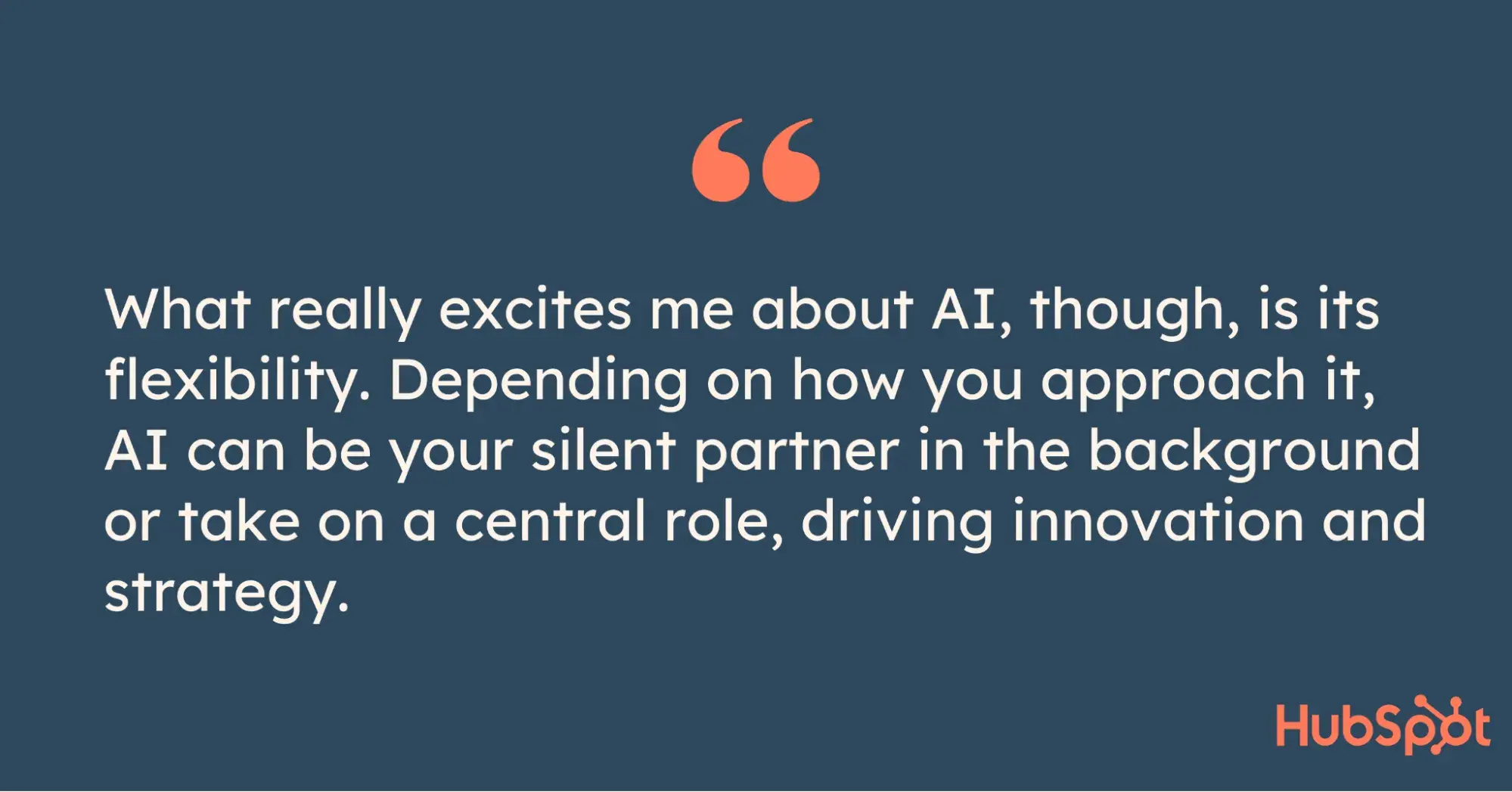
Whether you’re just starting with an idea, refining a product, scaling operations, or exploring new markets, AI can provide significant value at every stage.
McKinsey’s recent research shows that about 75% of the value generative AI delivers is concentrated in four key areas: customer operations, marketing and sales, software engineering, and R&D — some of the most critical aspects of building and running a successful business.
This likely explains why a 2023 study by Gartner found that generative artificial intelligence (GenAI) was the number one type of AI solution deployed in organizations.
Another Gartner survey also revealed that 79% of corporate strategists believe technologies such as AI, analytics, and automation will be critical to their success over the next two years.
This rapid adoption and increasing reliance on AI is a clear sign of AI’s growing importance in building and running modern businesses.
It also raises some important concerns.
As AI becomes more embedded in entrepreneurship, aren’t entrepreneurs at risk of over-relying on it? And exactly when does reliance turn into over-reliance?
Well, while I think it’s clear AI is an incredible enabler, it’s important to remember that it’s still a tool: it can’t replace the creativity, empathy, and strategic thinking that make entrepreneurs successful. This is why finding the sweet spot and understanding how to leverage AI for specific use cases is quickly becoming one of the most critical skills for the modern-day entrepreneur.
How Entrepreneurs Are Using AI
AI is actively reshaping how businesses operate.
In this section, I’ll dive into five practical ways entrepreneurs use AI in their businesses. I’ll also share real-world examples and AI tools that highlight how powerful AI can be when integrated into your business.
1. To Add Insight to Data Analysis and Interpretation
In today’s digital landscape, data is everywhere — CRMs, email platforms, analytics tools, etc. While gathering this data is important, I’ve found that the secret sauce is in analysis and interpretation.
This is where AI comes in.
AI-powered business intelligence tools bring a level of sophistication to data analysis that was once unimaginable. Unlike traditional business intelligence, these tools don’t just collect data—they can now understand, contextualize, and apply insights.
One of my favorite applications is through predictive analysis.
As renowned computer scientist Andrew Ng explains, “AI systems are good at spotting patterns when given access to the right data.” By processing current and historical data, AI can identify trends and forecast future outcomes.
For example, Domo.ai, a data analysis solution, offers a chat platform where users can ask questions, and their AI analyzes the data to provide contextual, personalized predictions — all in natural language. These predictions can range from projected product demand to forecasts of returning customers.
Features like these are crucial for accurate decision-making because missteps in these areas could lead to severe consequences like customer churn and wasted resources.
2. To Streamline (and Democratize) Software Development
Just a few years ago, if you didn’t know how to code or didn’t have the budget to hire a developer, your ideas often remained just that — ideas. The world of software development seemed closed off to anyone without technical skills or resources.
But now, AI has completely flipped the script. It’s broken down those barriers, enabling entrepreneurs — regardless of their technical background — to bring their ideas to life.
AI tools like ChatGPT and Github Copilot allow anyone to generate fully functional code from scratch by simply feeding in prompts.
This has been a game-changer for non-technical creators like myself. GitHub CEO Thomas Dohmke calls it, “the most profound breakthrough in technology since the genesis of software development itself.”
But even for technical founders and developers, AI is a valuable tool for streamlining development. For instance, tools like Workik automate code migration between different technologies, while BrowserStack uses AI to make automated testing more efficient.
Ultimately, whether you’re a non-technical entrepreneur or an experienced developer, AI opens up new possibilities for building software products.
3. To Transform Their Approach to Marketing
After nearly six years in marketing, I’ve witnessed the industry undergo countless shifts. But nothing has been as monumental — or potentially disruptive — as AI. It’s fundamentally changed how we approach marketing, from creation to delivery and even optimization.
One area where AI really shines is content creation. Tools like Claude and Copy.ai help generate blog posts, social media copy, product descriptions, and more at a speed and quality that once required entire teams.
Similarly, AI tools like MidJourney have transformed how we create media assets. As someone without a design background, being able to generate high-quality images and graphics with just a few prompts has completely changed the scope of what I can create and how I approach my work.
But AI’s impact doesn’t stop at creation — it’s reshaping marketing strategy, delivery, and optimization. Tools that pull insights from customer behavior, market trends, and historical data help craft more data-driven and targeted marketing plans. I also often find myself using generative AI to brainstorm and stress-test my ideas.
Finally, once campaigns are live, AI can work behind the scenes to optimize performance. Many marketing tools now have built-in AI features that analyze data in real time, adjusting elements like email subject lines, ad spend, and content distribution to ensure campaigns run as efficiently as possible.
Interestingly, Jessica Apotheker, Boston Consulting Group’s global CMO, believes the future of AI in marketing should increasingly focus on these data-driven applications rather than creative functions.
As she explains, “We need to reskill and reorganize to embed people who can build and use predictive AI tools at the core of decision-making in marketing. This means developing teams of marketing data scientists and engineers who create solutions to analyze performance.”
4. To Assist and Refine Sales Processes
According to former Outreach.io CEO Manny Medina, “In the future, there will be no sales representative or manager that doesn’t have an AI supporting their work.”
This rings especially true when you consider the sheer volume of data points that come into play when closing deals, especially at scale.
Salespeople have to juggle personalization, relevance, and timing, all of which can be the deciding factors between a “yes” and a “no.” And this makes sales one of the industries where AI can have the most significant impact.
How AI tools are changing the sales world
Take HubSpot’s AI, Breeze, for example.
Breeze’s “guided selling” feature helps reps close deals faster by automatically identifying and prioritizing the best leads. It even suggests “next steps” for leads at various pipeline stages, allowing salespeople to focus on the most promising opportunities and reduce time spent on less qualified leads.
Beyond Breeze, several other AI tools enhance and streamline the sales process in unique ways. Conversica uses language models to create personalized outreach messages and engage in conversations with leads. Asgard helps identify companies most likely to purchase your products, while Gong analyzes sales calls to develop personalized coaching plans for reps, helping them improve performance.
With so many AI-powered tools, your sales teams can leverage technology to enhance their processes and redefine what’s possible in sales performance.
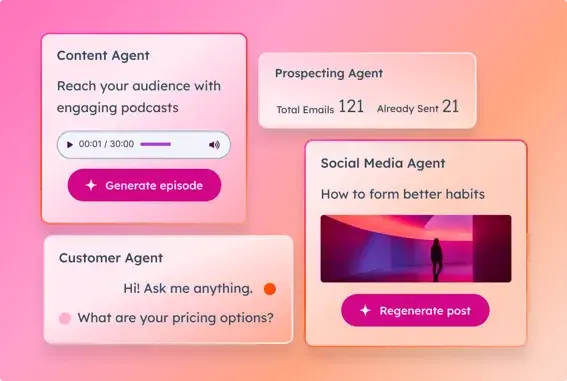
5. To Boost Efficiency and Satisfaction in Customer Support
According to a recent HubSpot study, 85% of service leaders believe AI will completely transform the customer’s experience with their company.
I agree with this sentiment because the last decade alone has introduced numerous AI-powered customer support channels, tools, and strategies. Today, there are countless use cases for AI in customer support.
Chatbots and virtual assistants, powered by natural language processing (NLP) technologies, allow companies to provide 24/7 on-demand customer support. AI tools can also pull relevant data from past interactions, purchase history, and customer preferences to create personalized experiences during these support interactions.
But AI can even go beyond direct customer interactions to help improve the efficiency of support teams.
For example, AI can support customer service reps by providing contextually relevant data during complex customer queries. It can also help build and maintain knowledge bases using real-time customer queries and corresponding solutions.
The possible applications are endless. Agata Rogińska, support team leader at Text, predicts that as AI in customer support progresses, “human agents and AI will complement each other in a way that AI will cover some repetitive tasks and boost efficiency. It will support human agents with additional data, which will help them to focus on more complex issues, building relationships and handling sensitive, emotional scenarios.”
A New Era for Entrepreneurship
There’s never been a better time to be an entrepreneur. AI removes so many obstacles and levels the playing field, allowing you, as an entrepreneur, to innovate and compete. Using AI, you can move faster, make smarter decisions, and focus on what really matters: building a great product.
![]()
How AI Is Transforming Cash Flow Forecasting: A Guide for Business Owners
As a business owner I know there’s one thing that can make or break my business: cash flow. If you start a brick and mortar store with employees you may be aware of how crucial it is to know when cash is going in and […]
SalesAs a business owner I know there’s one thing that can make or break my business: cash flow. If you start a brick and mortar store with employees you may be aware of how crucial it is to know when cash is going in and out — but maybe less so if you run an online business or are a consultant.
At the end of the day I’m a writer — not a numbers person — so the more I can outsource the financial side of my business, the better off we all are. One particular use case I’ve found interesting is how businesses (like me!) can use AI to improve the accuracy and ease of cash flow forecasting.
Given that 80% of small businesses go under due to cash flow problems, getting this right is crucial. And better cash flow = getting to continue doing the work that I love.
To learn more about the tech’s potential, I spoke to several experts across various industries (from finance to ecommerce) to see how they are integrating AI into their forecasting methods and what tips you can learn from their experience.
Table of Contents
- Why Use AI for Cash Flow Forecasting?
- How AI Changes Cash Flow Forecasting: The Old Way vs. The New Way
- How AI Can Improve Cash Flow Forecasting
- Implementation Guide: Tips for Using AI in Cash Flow Forecasting
- Tools for AI Cash Flow Forecasting
Why Use AI for Cash Flow Forecasting?
You probably already know that AI can save you time and money running your business — but how exactly can it help you better forecast your cash flow?
To answer this, I should first explain what cash flow forecasting is and some common challenges you might face using traditional methods.
- Cash flow forecasting: The process of estimating future cash inflows and outflows to predict your business’s financial position over time. This includes things like revenue streams, payroll costs, and day-to-day operational spending.
- Why it matters: This helps businesses make informed decisions about investments, expenses, and growth opportunities while ensuring they maintain adequate cash reserves.
How AI Changes Cash Flow Forecasting: The Old Way vs. The New Way
Back in time before AI, cash flow forecasting meant gathering data from different systems, updating spreadsheets, and making educated guesses about when customers might pay. It’s manual, time-consuming, and often inaccurate.
Manual forecasting suffered from siloed data, outdated information, calculation errors, and missed seasonal patterns. Teams wasted hours on basic analysis that was outdated before it was complete.
Now, imagine having a system that automatically pulls data from all your sources, learns your customers‘ payment patterns, and alerts you to potential cash shortages before they happen. That’s what AI brings to the table.
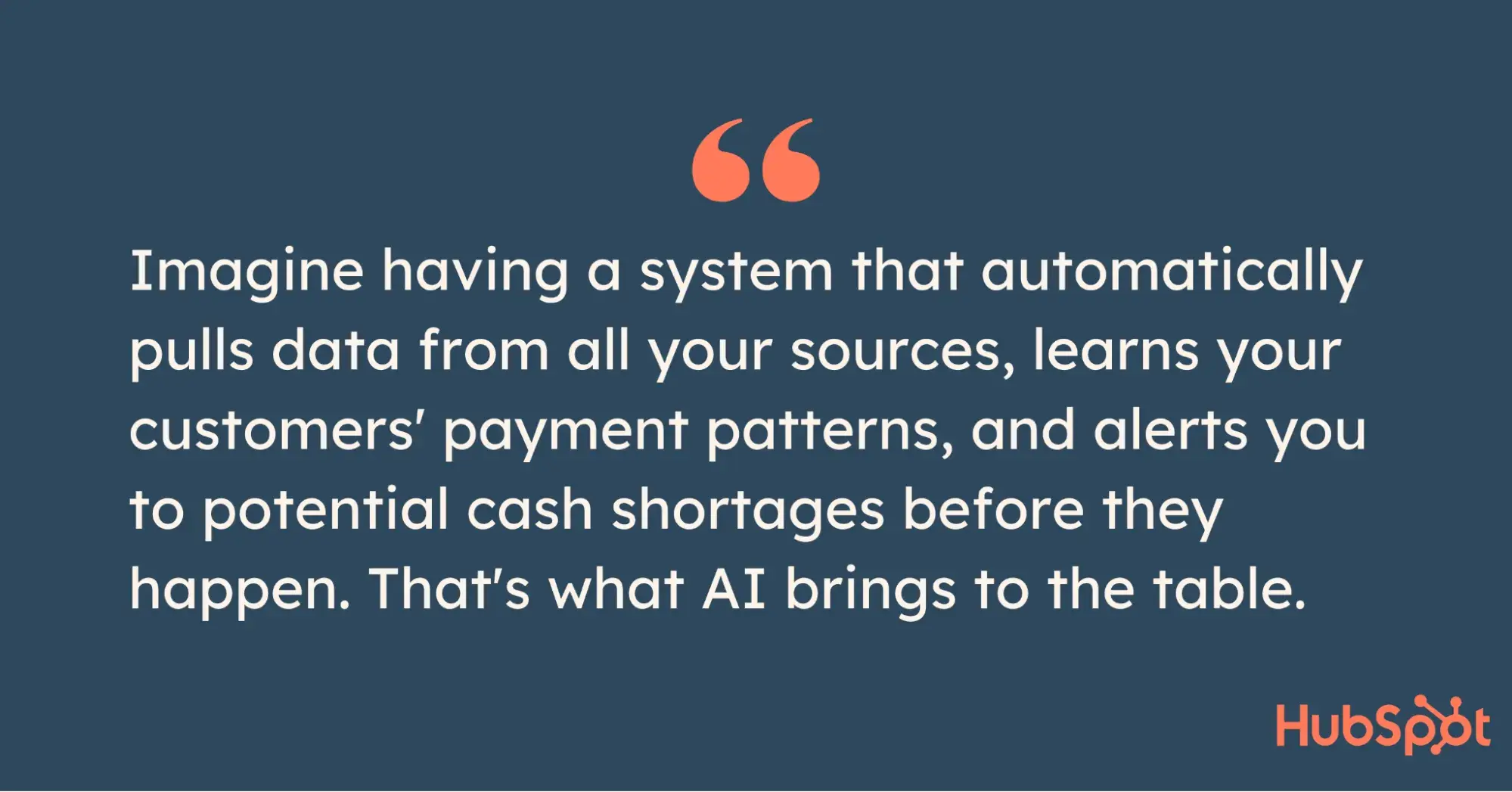
While traditional forecasting might tell you to expect $100,000 in payments next month based on historical averages, AI can tell you things like:
- Company A always pays early when they order more than $50,000.
- Company B typically pays late during summer months.
- Your retail sales are likely to spike between 10 AM and 2 PM two days after Social Security payments hit. (Yes, that’s a real data point a source shared with me!)
P.S. If you’re looking to brush up on your forecasting skills, I recommend checking out these free courses in HubSpot Academy: Forecasting and Analytics in Sales Hub and Hubspot Sales Forecasting.
How AI Can Improve Cash Flow Forecasting
AI improves the accuracy and speed of cash flow forecasting.
Traditional cash flow forecasting can be tedious and error-prone, but AI is solving this problem.
“AI reduces the time spent collecting and entering data, and it can create more accurate forecasts by taking into account unexpected events and current economic conditions, which can be difficult to capture through traditional forecasting,” explains Jim Pendergast, General Manager of altLINE.
AI excels at identifying complex patterns that humans might miss.
The power of AI lies in its ability to uncover hidden patterns in financial data that might escape human eyes. (And why spend your time poring over detailed spreadsheets if you don’t have to?)
Alex Schlesinger, Founder and CEO of Active Mutual, a final expense insurance business, shares a compelling example. His team noticed that many of their senior clients would receive their Social Security payments on the third Wednesday of each month. “In the past, we’d roughly estimate that ‘yeah business might pick up around then.’
“Our model picked up that not only do sales increase two days after Social Security payments, but specifically, they spike between 10 AM and 2 PM on those days,” Schlesinger explained.
“That kind of accuracy means we can plan everything better — from marketing budgets to commission payouts,” Schlesinger added. “Plus it’s way cheaper than it used to be.”
AI integrates multiple data sources for comprehensive forecasting.
Modern businesses generate vast amounts of data across various systems and departments. AI’s ability to synthesize these diverse data streams sets it apart in cash flow forecasting.
Craig J. Lewis, Founder and CEO of Gig Wage, emphasizes that “AI has introduced predictive algorithms that significantly enhance both the speed and accuracy of cash flow forecasting by processing large datasets in real-time.”
Here are some data sources that can be integrated by AI:
- Sales and revenue data.
- Accounts receivable aging.
- Supplier payment terms.
- Inventory levels.
- Market trends.
- Economic indicators.
- Weather patterns (for seasonal businesses).
- Social media sentiment.
- Competitor activities.
Roy Benesh, CTO of eSIMple, contrasts this with traditional methods: “When we use traditional forecasting, it depends on past data and people’s judgments collected over time, but AI pulls in different data from many sources like supply chain changes and market trends that provide optimized answers now.”
Benesh shared with me examples of what that looks like for two different industries. Take manufacturing as an example. With AI, you can pull in real-time data from supply chains, inventory, and revenue streams to get a clearer financial picture. Retail companies, who rely on maintaining an accurate level of inventory, can also rely on this real-time data to keep updated predictions.
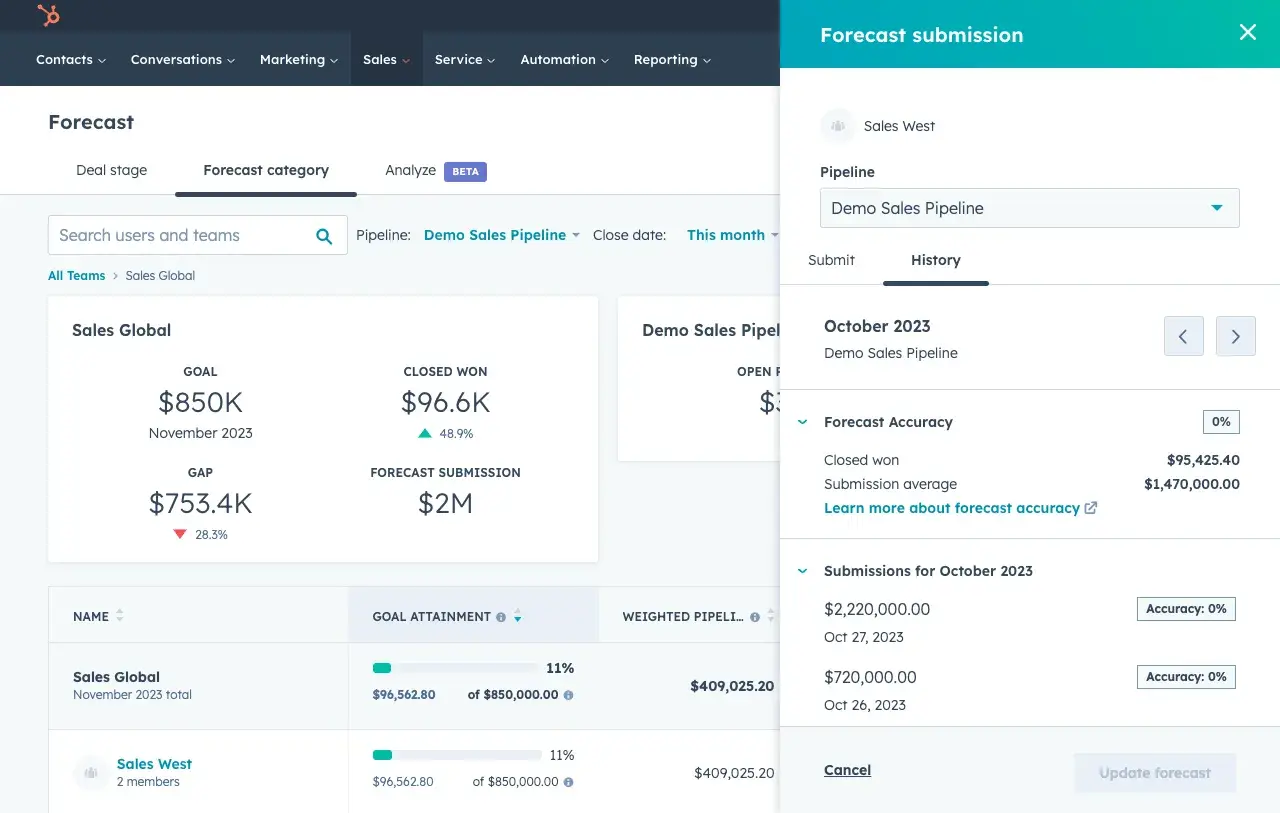
Check out HubSpot’s Forecasting Software.
Implementation Guide: Tips for Using AI in Cash Flow Forecasting
Testing out AI doesn’t have to be overwhelming. I‘ve talked with several business owners who’ve successfully made the transition, and they all share a common approach: start small, stay focused, and build gradually.
1. Start with small pilot projects before scaling.
Don’t try to revolutionize your entire financial system overnight. Pick one area — maybe customer payment predictions — and start there.
Lewis from Gig Wage recommends you “pinpoint the areas where you think optimization is needed and work with AI in those areas to see how you like the results.”
Begin with one specific project ➡️set clear success metrics.
Maybe you want to reduce the time spent on forecasting by 50% or improve accuracy by 25%. Having these concrete goals will help you measure progress and build confidence in the system.
2. Maintain human oversight and expertise alongside AI tools.
AI shouldn’t be something you solely depend on. As Benesh explained to me, “Human oversight and frequent checks against actual cash flow data are still key to staying accurate.”
“There’s a myth that this approach ‘just works’ on its own, but it needs regular attention, especially in unpredictable markets,” he added.
Lewis echoes this advice, “If the present looks like the past, then AI will do a strong job in minimizing forecasting errors. This is broadly useful because during these periods AI will outperform humans. If there is a significant deviation from the data on which the model is trained, the model will mismanage cash. I think it’s important to know what a computer is good at and what humans are good at so that you mitigate risk to the highest extent possible.”
3. Blend with traditional methods.
“Traditional methods, though slower, allow seasoned analysts to apply judgment and context that algorithms alone may miss — there is still somewhat of a tradeoff,” adds Lewis.
I like thinking of it like having both a GPS and a local guide. The GPS (AI) provides precise, data-driven directions, but the local guide (human expertise) knows about the road construction that started yesterday. You need both for the best results.
4. Start small — and focus on quality over quantity.
Lewis’s last bit of advice? “Be incremental. Pinpoint the areas where you think optimization is needed and work with AI in those areas to see how you like the results. This simplifies the transition and allows people to adapt to the new tools. AI is fundamentally a tool that helps with optimization. I think it would be much harder to implement from the get-go.”
Tools for AI Cash Flow Forecasting
1. HighRadius
What is it? HighRadius offers a cash flow forecasting software that’s powered by AI and has a 95% forecast accuracy rate. This tool is designed to optimize liquidity management by leveraging AI to provide deep insights into cash inflows and outflows.
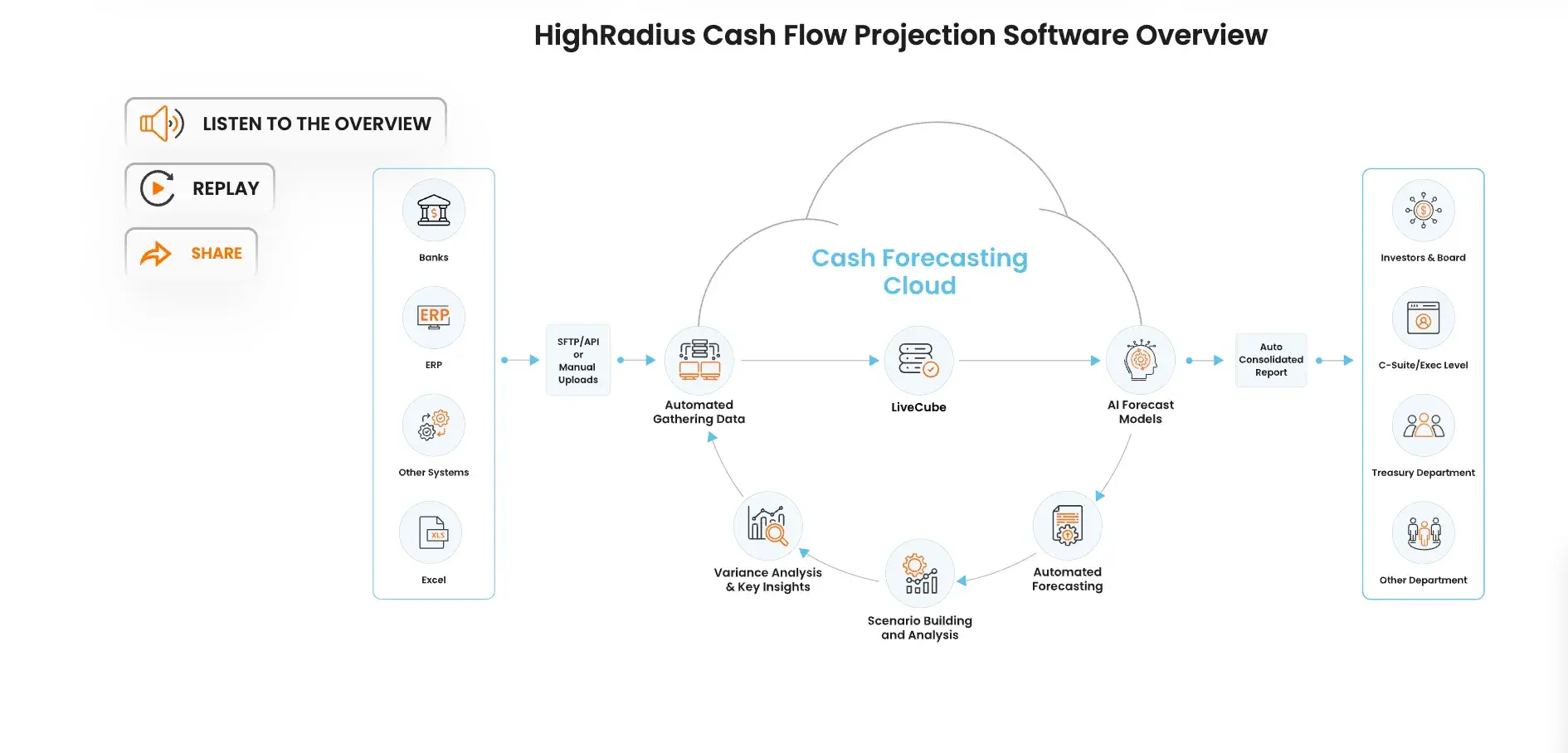
Key Features
- Automated data gathering that consolidates cash flow data from multiple sources, reducing the need for manual data entry.
- Predictive insights that use machine learning to analyze historical data and create highly accurate cash flow predictions.
- Scenario modeling that allows businesses to simulate different cash flow scenarios to prepare for possible market fluctuations.
Best for: Mid-sized to large enterprises with complex cash flow needs, looking for high accuracy in their cash flow predictions and real-time updates.
2. Oracle Cloud EPM
What is it? Oracle Cloud Enterprise Performance Management (EPM) Platform is a suite of cloud-based financial software tools that helps businesses manage their planning, budgeting, forecasting, and reporting processes. It integrates with other Oracle financial tools, making it a great option for managing your overall financial performance.
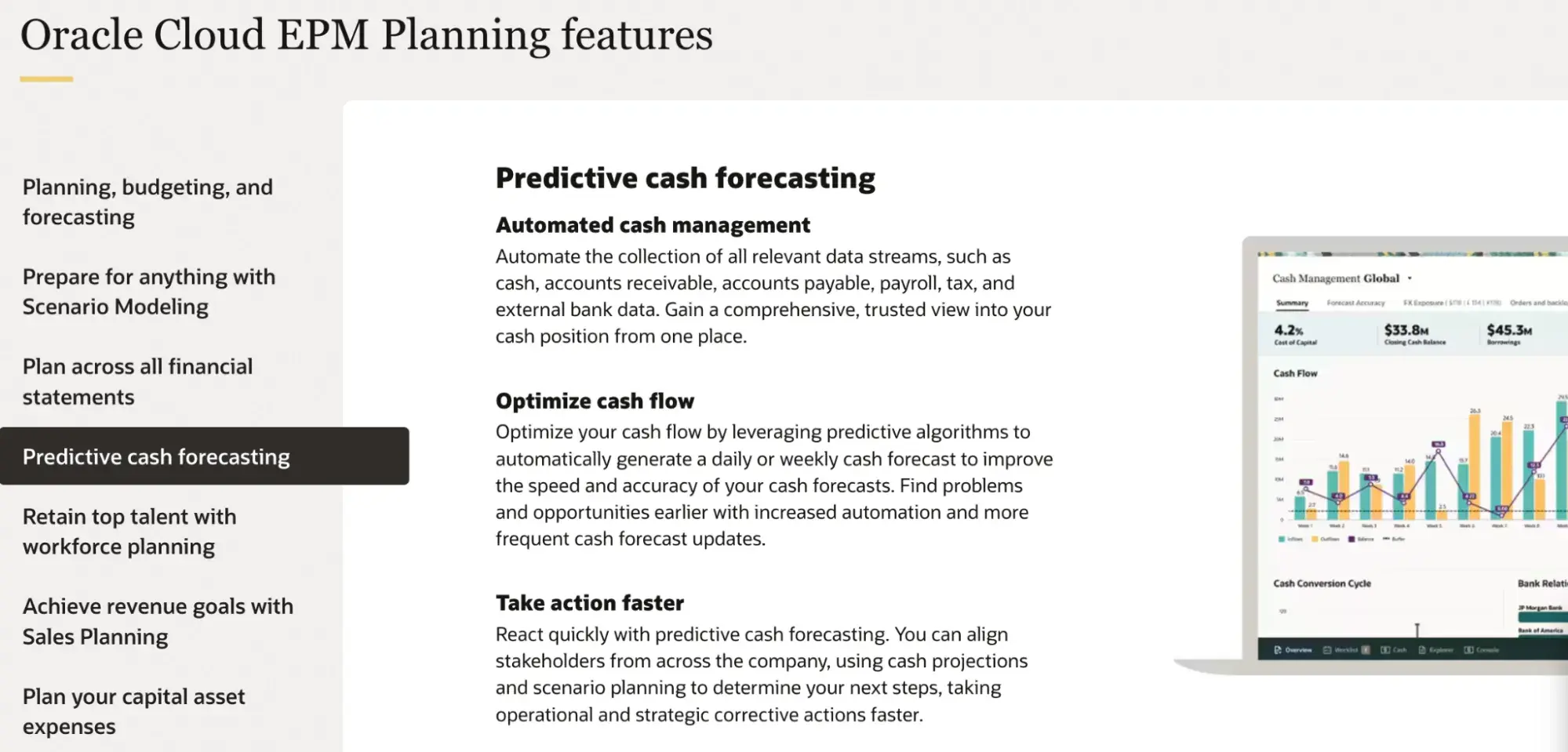
Key Features
- AI and machine learning integration that enhances forecasting by incorporating trends, seasonal patterns, and anomalies into cash flow predictions.
- Comprehensive financial planning that enables businesses to manage budgets, planning, and forecasts in one unified platform.
- Real-time data integration that pulls data from various departments for a unified view of cash flow and financial health.
Best for: Large enterprises that already use Oracle products.
3. Kyriba
What is it? Kyriba is a cloud-based cash management platform focused on improving cash visibility and liquidity management. Its AI cash flow forecasting feature helps businesses predict and control their cash flow needs.
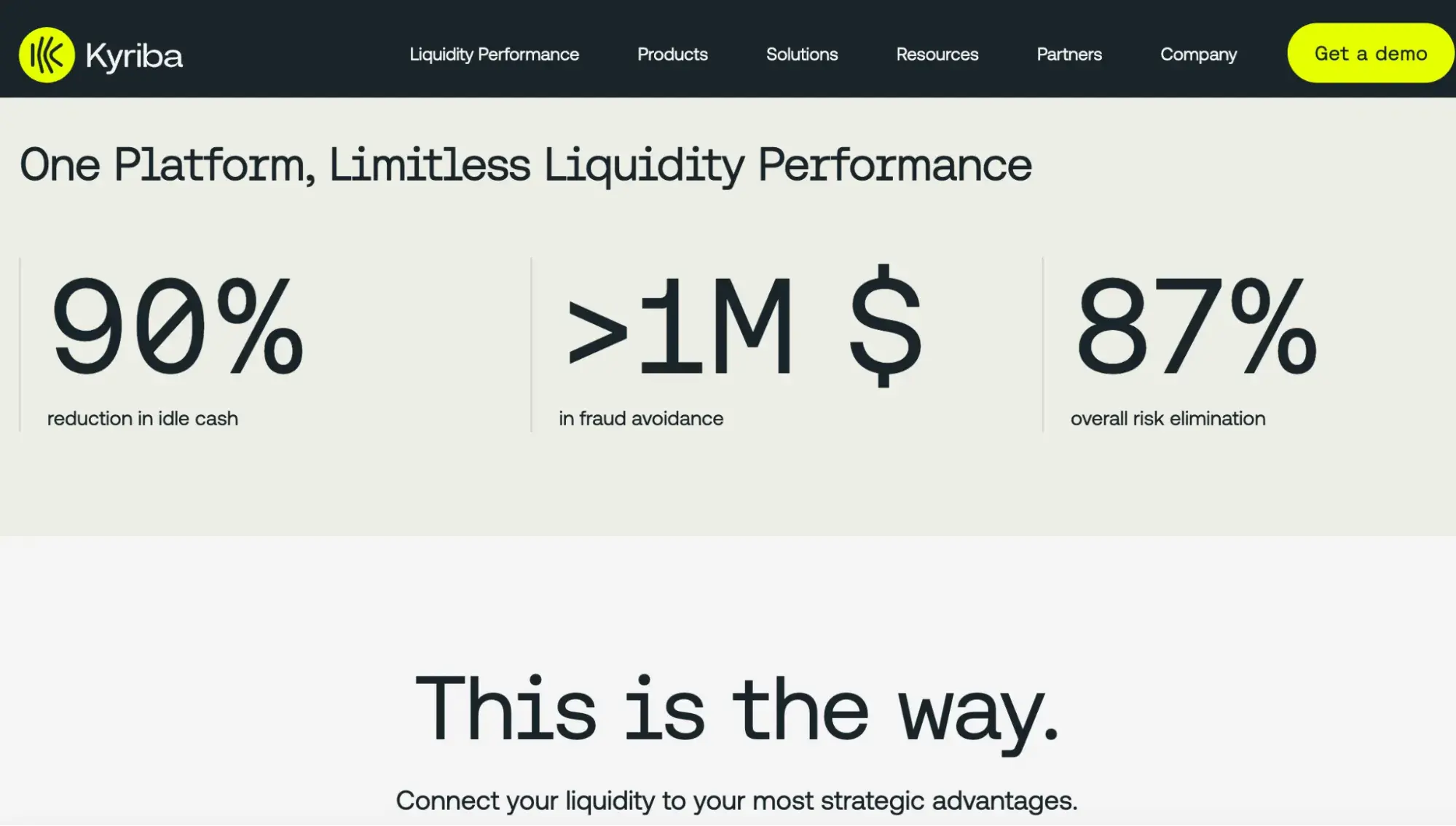
Key Features
- Real-time cash flow tracking that provides a detailed, real-time view of cash positions across multiple accounts and currencies.
- AI-driven scenario analysis that allows companies to simulate different financial scenarios to assess potential impacts on liquidity.
- Multi-currency support. I think this is ideal for global businesses with cash flow needs across different currencies.
Best for: Multinational corporations or businesses with high-volume cash flow activity across multiple currencies and accounts.
4. Planful
What is it? Planful is a financial planning and analysis platform that incorporates AI-based anomaly detection and predictive forecasting to aid cash flow forecasting. I found that the platform is quite easy to use and that it integrates well with other financial tools.
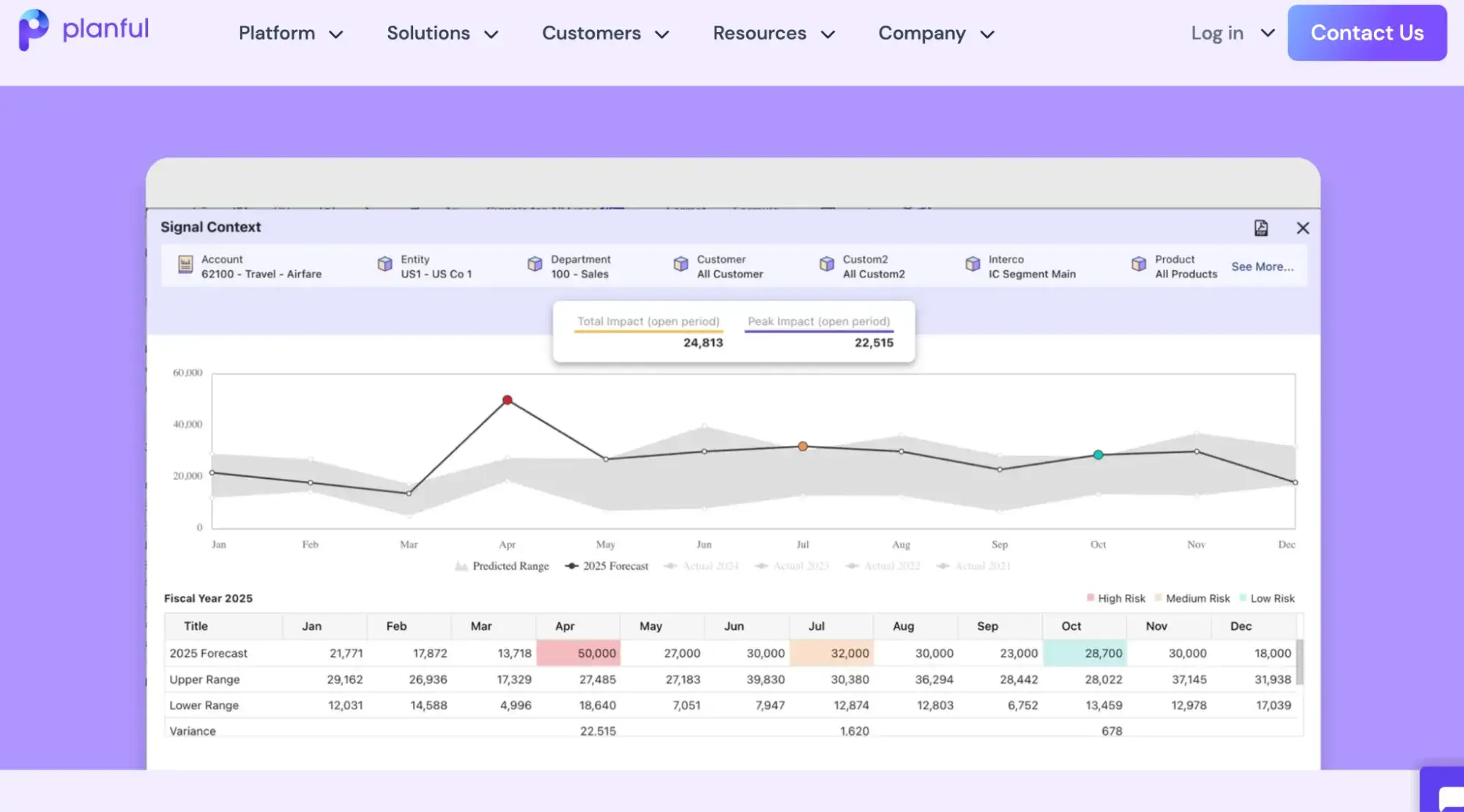
Key Features
- Anomaly detection that identifies unexpected changes in cash flow data, helping companies address discrepancies early.
- Predictive forecasting that uses AI to analyze past cash flow patterns and forecast future cash needs.
- Collaboration tools that facilitate cross-department collaboration for more accurate cash flow planning.
Best for: Planful is ideal for small to mid-sized businesses that require a flexible, user-friendly platform for financial planning, especially if you’re looking for collaboration features.
Use AI to Increase Your Cash and Focus on Your Business
I had a harder time finding AI cash flow tools that were designed for smaller businesses. But given the complexities of cash flow (and more $$) for enterprise businesses, it makes sense. I’m sure that financial companies will still continue to experiment with ways they can integrate AI into their offerings.
But I’ve walked away with some helpful ideas about how I can incorporate AI into my cash flow forecasting process — and I’d like to run an experiment looking at the past 12 months and see if ChatGPT can find any trends that might be helpful for me as I’m planning the upcoming year.
If you’re interested in testing some tools, remember the expert advice I shared: start small, maintain human oversight, and focus on one specific area where AI can help your cash flow forecasting.
After all, better cash flow predictions mean more time doing what you love and less time worrying about whether you can make payroll next month. (A win-win!)
![]()
Decoding Buying Signals in Sales [+ Examples & What I Learned]
I’ll never forget one of my first big sales meetings. I walked out feeling defeated, convinced I’d blown it. The prospect had bombarded me with tough questions and objections, and the whole time I thought they were poking holes in my pitch because they weren’t […]
SalesI’ll never forget one of my first big sales meetings. I walked out feeling defeated, convinced I’d blown it. The prospect had bombarded me with tough questions and objections, and the whole time I thought they were poking holes in my pitch because they weren’t interested. Later on, a mentor would point out that those “grilling” questions were actually a buying signal in disguise. That prospect was deeply engaged, trying to gather justification to buy.
In this article, I’ll share what buying signals in sales really are, the different types of signals you should watch for, how to identify them in real time, and how to respond when you spot one. I’ll even throw in examples (including a few I learned the hard way) so you can recognize these cues in your own sales conversations.
By the end, you’ll be able to more effectively read your prospects and ensure you’re addressing the things that matter most to them — and hopefully, close more deals along the way.
Table of Contents
- How to Identify Buying Signals
- What are buying signals in sales?
- Types of Buying Signals
- How to Respond to Buying Signals
- Examples of Buying Signals
- How Buying Signals Made Me a Better Salesperson
What are buying signals in sales?
Buying signals are behaviors or statements that indicate a prospect is considering a purchase. Regardless of what sales methodology (or combination of methodologies) you adhere to, buying signals help salespeople understand where a buyer is in the decision process, what matters most in a purchase, and when the seller should take action.
According to data from Lantern, effective use of buying signals can create 10-20% more sales opportunities and reduce a company’s customer acquisition cost (CAC) by up to 30%. Why the stark improvements? Buying signals help you differentiate between casual interest and true intent, ensuring you spend time on the highest-quality deals with the best chance of closing.
Types of Buying Signals
Buying signals come in a few different flavors. Here are some common types, each of which signals prospect interest from a slightly different angle. Under each type, I’ll give a quick “pro tip” or explain what scenario it’s best for, so you know how to leverage that signal in your sales efforts.
Verbal Buying Signals
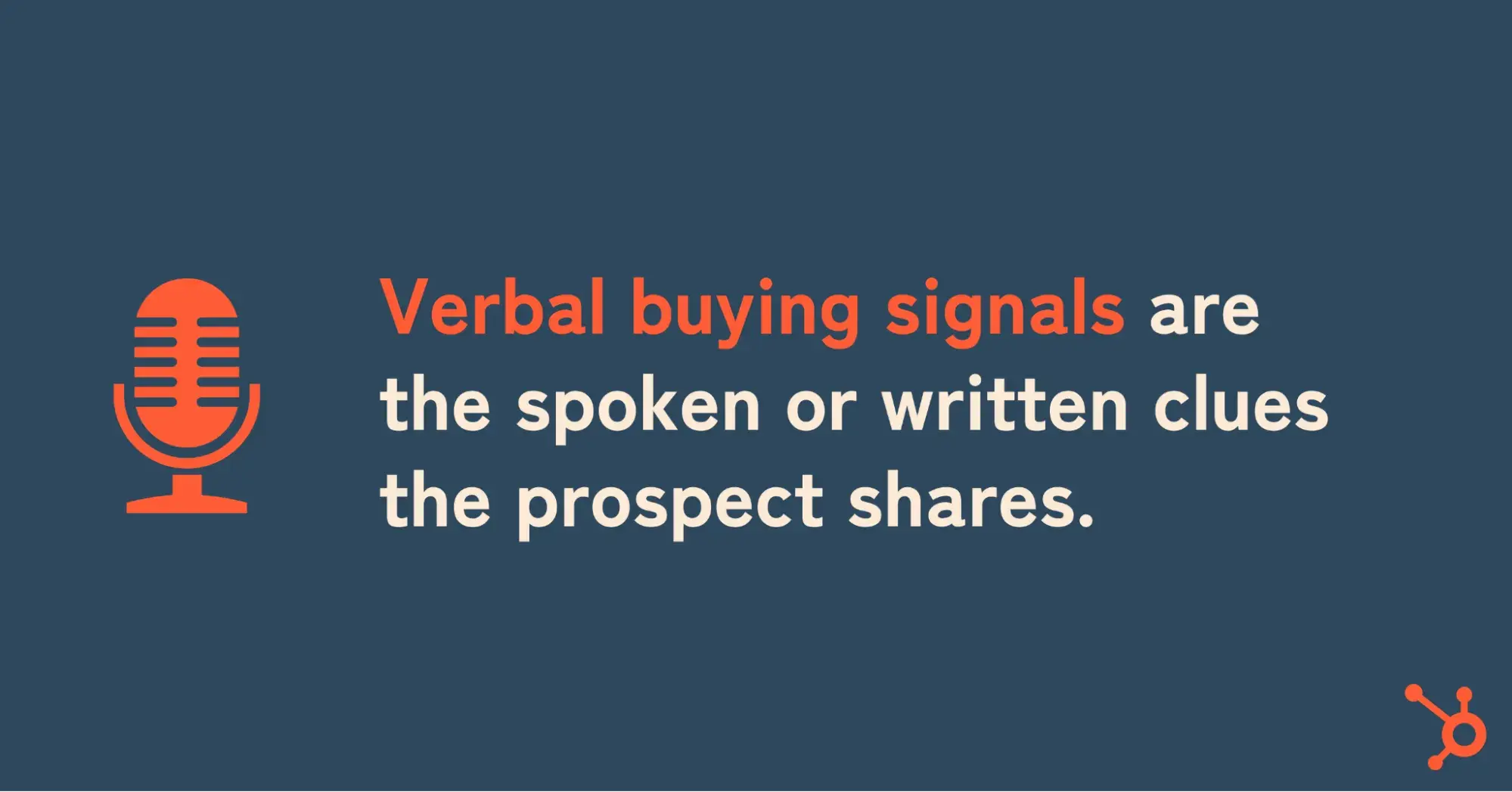
Verbal buying signals are the spoken or written clues the prospect shares. These are often the easiest to catch — after all, you can literally hear or read them — but they can sometimes be hidden in plain sight. In my early days, I would often be too busy thinking about the next point in my presentation and miss cues from the prospect. Don’t let that happen to you! Here are a few examples of verbal signals:
- Questions about the product or service. If your prospect starts asking detailed questions (“How does your solution handle X?” or “Can it integrate with our current system?”), they’re picturing themselves as a user. They’re essentially saying “Convince me this works for me.” That’s a buying signal. In general, the more thoughtful the questions, the more engaged they are.
- Discussions of budget or pricing. When a prospect brings up money or budget without being prompted, it’s a huge signal. It means they’re seriously considering how to make this purchase work. They might ask, “What would the pricing look like for a team of 20?” or “Is there a discount if we sign a two-year contract?” That indicates they’re envisioning the deal. On the contrary, a prospect who clearly avoids any mention of price will need to be brought around to the idea.
- Questions about next steps or implementation. This signal is like a golden ticket. If a prospect asks something like, “What would the next steps be if we decided to move forward?” or “How soon could we get started after signing?” they’re essentially probing the path to closing. Similarly, asking about implementation details (“How long does onboarding take?”) shows they’re picturing the post-sale scenario. That’s a strong buying signal because they’re mentally moving beyond if they buy to how they’ll operate after they buy.
- Expressing dissatisfaction with a current vendor. This one doesn’t slip past most salespeople. Prospects that complain about their current service provider are generally begging to be put out of their misery. Even if it seems small or unimpactful, focus on the pain point they’re bringing up and emphasize how your organization can help them avoid it.
Pro tip: Practice active listening. It sounds obvious, but it’s easy to slip up and find yourself planning for the next part of your pitch. Slow down and truly listen to what’s being said. I guarantee your prospect would rather you listen closely, even if it means you’ll need a short pause to collect your thoughts before responding to what they’ve said.
Non-Verbal Buying Signals
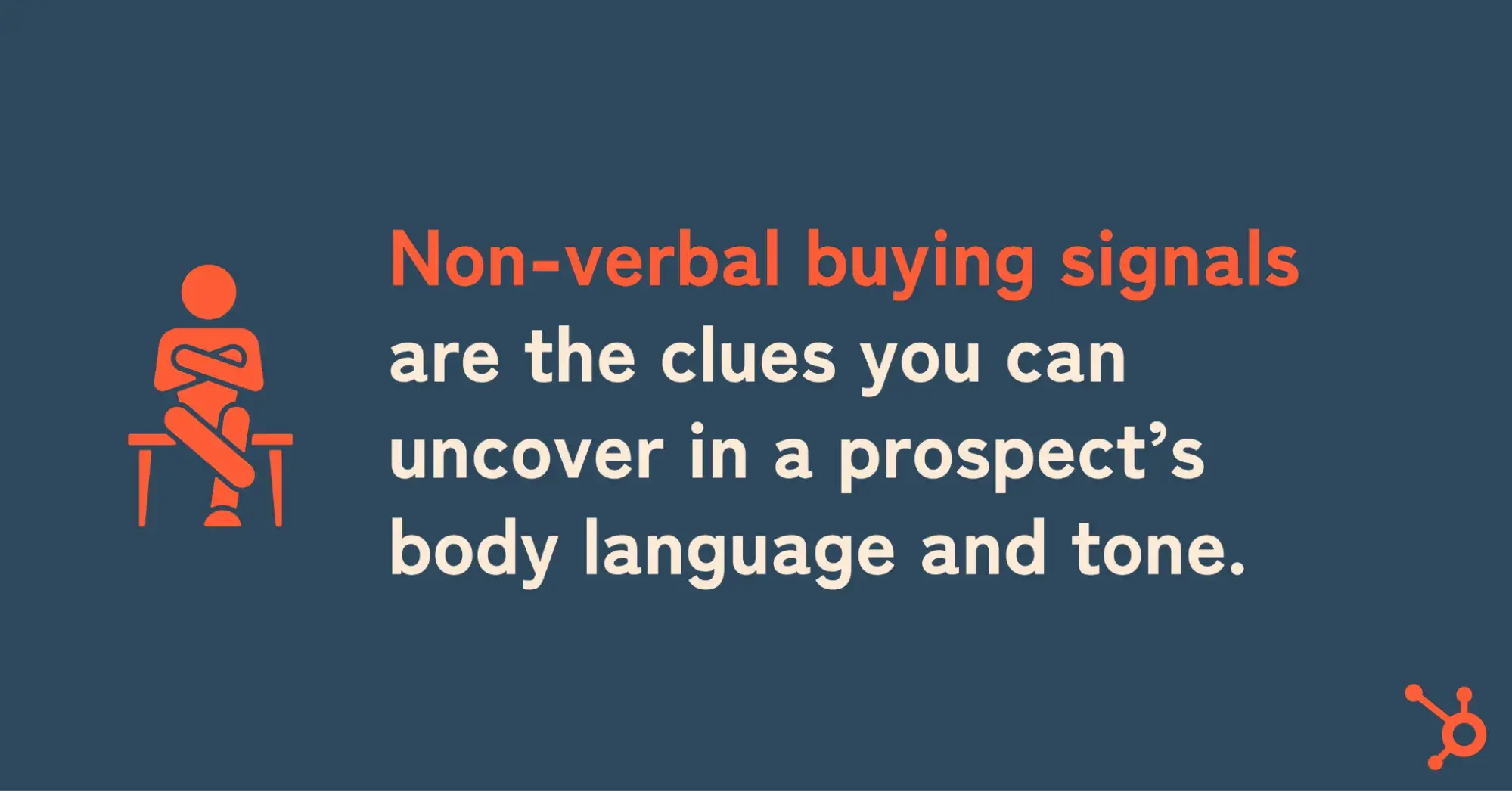
Have you ever sent an email that you thought couldn’t be any clearer only to have the recipient completely miss the point? People make mistakes, of course, but it’s also true that human beings communicate a lot without words — and sometimes more than we mean to. In sales, especially in face-to-face meetings or video calls, pay close attention to these signals.
- Body language. Think eye contact, nodding, leaning forward, smiling, or even the classic “slow-and-thoughtful-head-nod.” I once had a prospect in a demo who barely said a word (which freaked me out), but I noticed they kept leaning in to look closer at my screen share and nodding slightly whenever a feature seemed to resonate. That was a buying signal; they were engaged. Sure enough, they moved forward after the demo.
On the flip side, beware of closed-off body language. If the prospect is looking at their watch or phone or maybe responding to Slack messages during the demo, you might as well take a leap to re-engage them — because you’re either losing them fast or they’re already gone.
- Tone of voice and enthusiasm. If you’re on a call and can’t see the person, listen for tone. Excitement is hard to hide. Even a simple “uh-huh” or “mmm” in an affirming tone as you speak can indicate agreement and interest. Conversely, monotone “Okay… got it” responses might mean they’re not sold yet, and complete silence is usually a bad sign, too.
Pro tip: You’ll need to give prospects space to talk in order to pick up on tonal cues. Of course, you’re doing that anyway, right?
Digital Buying Signals
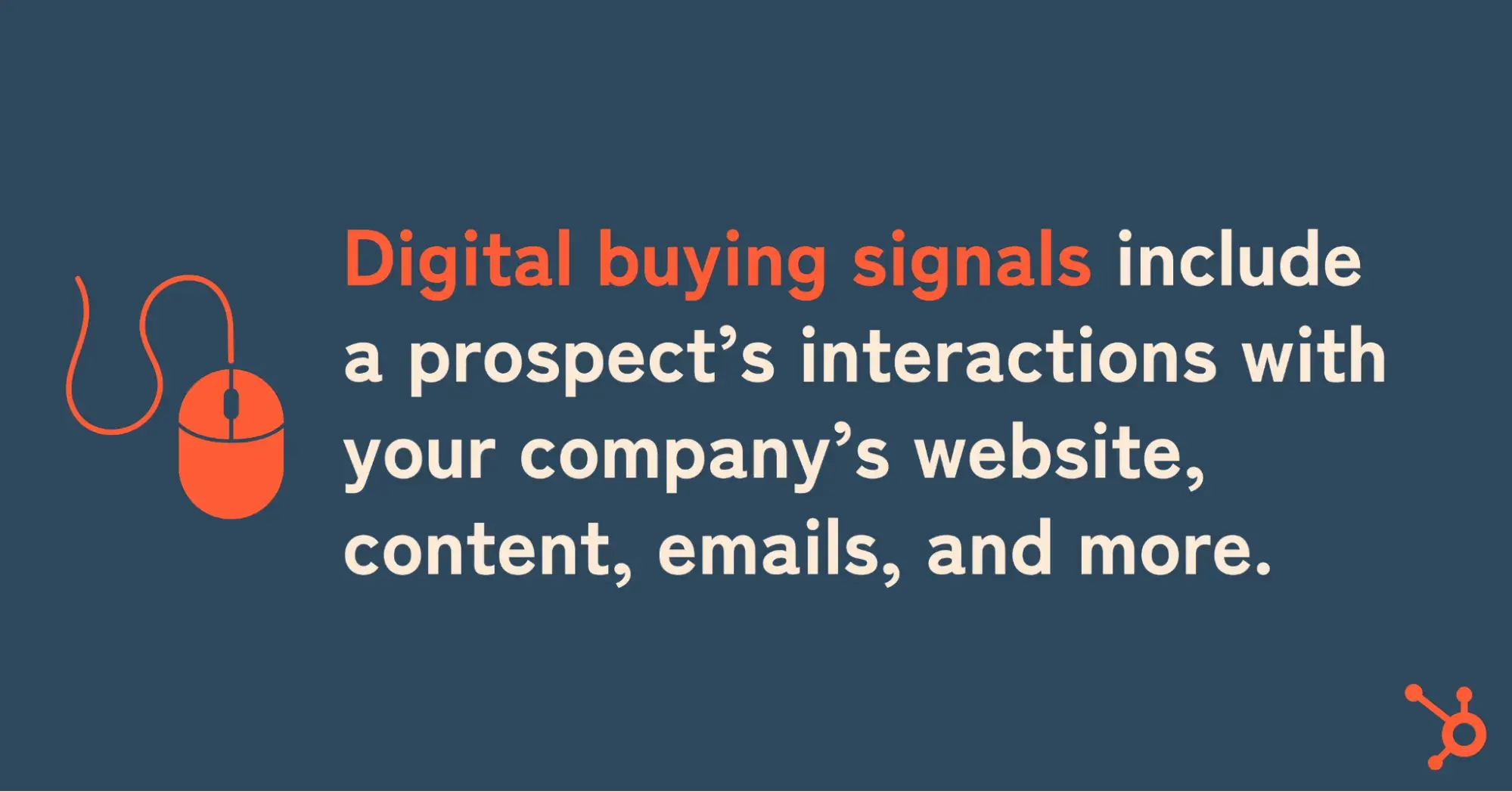
Buying signals aren’t just happening during conversations. They’re also happening online, often before a prospect ever talks to you or in the days or weeks between your live conversations. I like to call these digital buying signals, and they include a prospect’s interactions with your company’s website, content, emails, and more. Here are some common digital signals that someone is interested:
- Email engagement. Ever get a notification that a prospect opened your email or clicked a link you sent? If a prospect consistently opens your emails quickly or multiple times throughout the day, that’s a signal. I like to reach out and suggest a quick phone call — it’s less intrusive than a virtual meeting, and they can get a lot of their questions answered in just five minutes.
- Website activity. If you see that a lead has visited your pricing page, features page, or looked at case studies, take that as a solid buying signal. They’re doing their homework on you and essentially moving through stages of the funnel on their own. Reach out and see if you can help them with anything, and recommend content (if you have it) that they might be interested in.
- Free trial or demo sign-ups. If your company offers a free trial or a freemium version and a prospect signs up for it, that’s an obvious one — they’re interested enough to take your product for a test drive. Similarly, signing up for a live demo or webinar you’re hosting indicates active interest. They’re essentially raising their hand and requesting more information.
- Social media and community engagement. This signal is a bit softer, but still noteworthy in my book. If a prospect starts following your company on social media or they like or comment on your posts, there’s certainly some indication of curiosity and intent. These signals might not be as strong as an actual inquiry, but they paint an overall picture of an interested lead — particularly when combined with other signals.
Pro tip: Digital signals happen behind the scenes, but they’re important enough to be brought to your attention. I generally loathe browser notifications (we have enough notifications in our lives), but I have one exception — any time a prospect clicks a link in my email, I have HubSpot alert me. It’s a much stronger signal than a mere email open, and worth interrupting my concentration just a little to know about it.
Situational Buying Signals (Trigger Events)
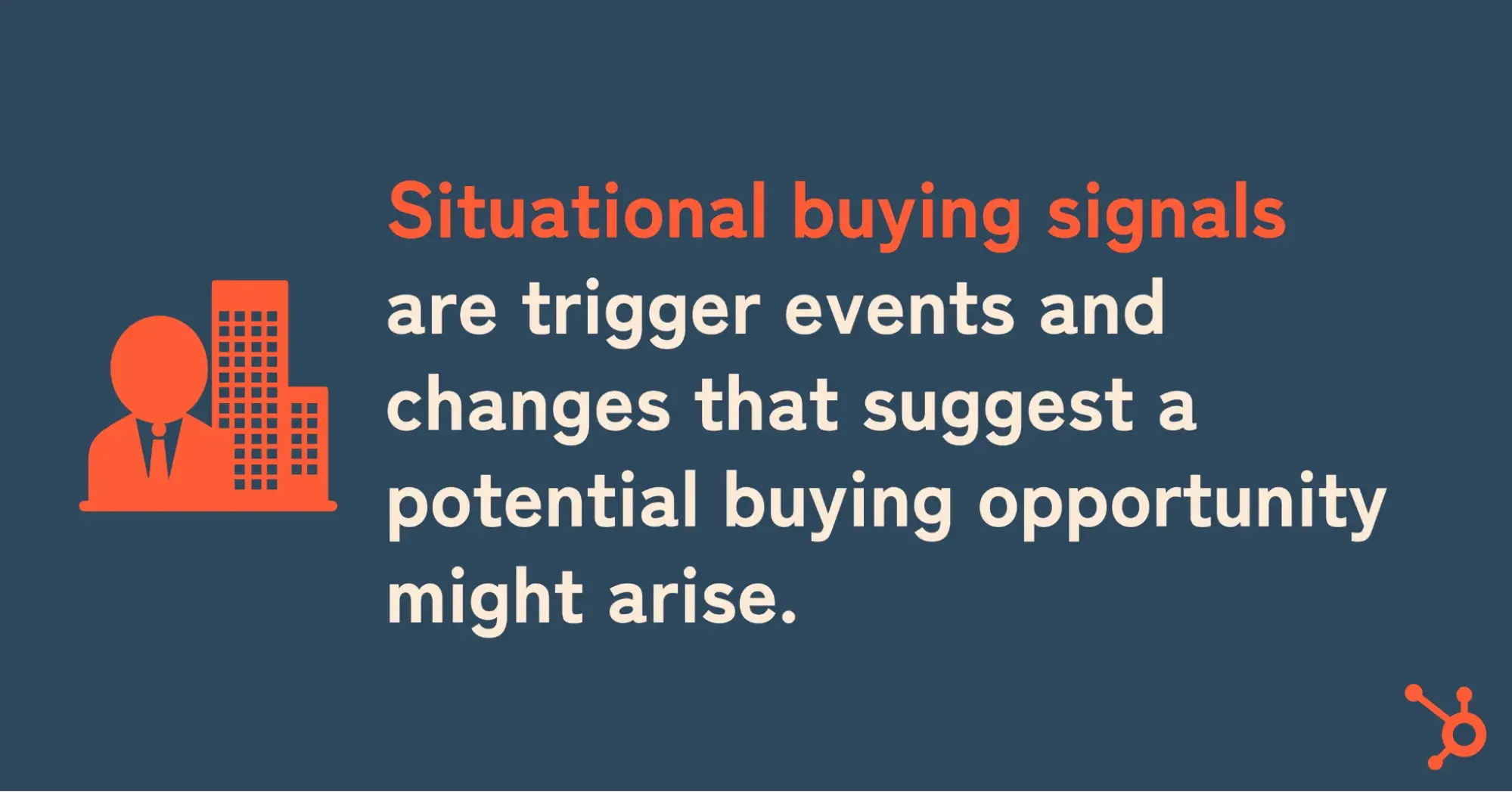
The last type of buying signal I’ll cover isn’t about the prospect’s behavior toward you, but rather external events or situational changes that signal a potential buying opportunity might arise. These are often called trigger events in sales. Savvy salespeople watch for these because they can open a window to reach out or advance a conversation that may have stalled out in the past. Here are a few examples:
- Company changes. If your prospect’s company announces a new round of funding, a merger, an expansion, or a new executive hire (like a new CTO or CMO), that’s a possible buying signal. New leadership often means new priorities and new budget allocations, and fresh funding means resources to invest in solutions.
- Public mentions of pain or goals. Sometimes companies will publicly hint at needs. For example, if a CEO says in an interview, “Customer experience is our top focus this year,” and you sell a customer success platform, that’s a signal. Or if a prospect posts on social media complaining about a problem that your product solves, it could be a great time to gently reach out with some insight.
- Industry or market changes. New regulations, market trends, or even competitor moves can trigger buying behavior. If a new law requires your prospect’s industry to report something and your solution helps with that reporting, their sudden compliance need is a buying signal. Or if one of their major competitors just implemented a solution similar to yours and is seeing success, your prospect might be feeling pressure to keep up even if they haven’t directly engaged with you yet.
Pro tip: Situational signals definitely require you to have a pulse on the prospect’s world beyond what you might be picking up in your direct interactions. Set up Google Alerts, follow their company on LinkedIn, use sales intelligence tools — whatever helps you catch wind of these trigger events. A little bit of research and news tracking goes a long way.
Now that we’ve covered the gamut of buying signal types, let’s talk about how to actually identify these signals in practice. It’s one thing to know the theory; it’s another to consistently spot the signals in the wild.
Identifying buying signals is a skill that you can develop with practice. Early in my career, I honestly didn’t know what I was looking for — it was like trying to tune a radio without knowing the station frequency. Over time, I picked up some habits that made catching signals easier.
Here’s how you can hone your senses to spot those crucial cues.
1. Be an active listener (and observer).
In my opinion, listening more than you talk is the most important part of any sales interaction. When the prospect is speaking, really hear them — not just the words, but the intent behind the words. Do they sound excited? Concerned? Confused? Those emotional tones might tell you something, but don’t assume your inference is correct. Paraphrase and confirm your interpretation: “It sounds like you’re really interested in that integration to increase your team’s efficiency, did I get that right?”
Also, observe the prospect’s demeanor. If you’re face-to-face, things like nodding or smiling while they say “That could be useful for us” amplify the signal. If you’re on a call, listen for subtle verbal cues like a change in tone or the pace of the conversation. Essentially, keep your antenna up for any change in the prospect’s engagement level.
2. Ask open-ended questions.
One of the best ways to draw out buying signals is to ask questions that encourage the prospect to talk. Questions like “What are your thoughts so far on what we’ve shown?” or “How does this compare to what you’re doing today?” invite them to reveal their feelings and intentions.
Their answers can be a treasure trove of signals. If they respond with enthusiasm and start explaining how they’d implement your solution, you’ve got a positive signal. If they hesitate or bring up a concern, that’s useful too — it might be an objection you need to address.
3. Leverage your CRM and sales tools.
I touched on this in the digital signals section, but use technology to help you. Set up notifications for key prospect activities like email opens, link clicks, and content downloads. If your sales process doesn’t already have it, I would strongly recommend incorporating a lead scoring system that assigns a value to these activities and more, helping you prioritize the most engaged prospects. Did a potential buyer just visit your pricing page? Reach out asap.
4. Educate yourself and your team on common signals.
Make buying signals a part of your sales training and team conversations. If you’re new, ask veteran reps what signals they look for that indicate a deal will close. It might be their language, when they start using phrases like “when we implement” — or it might be when they invite a technical lead to the next call. The more familiar you are with the most important signals, the more they’ll pop out at you in real life. I keep a list in my notebook of top buying signals as a reminder before I go into a meeting, because it mentally primes me to watch for them.
In short, identifying buying signals comes down to being attentive, curious, and prepared. When you make a habit of actively listening and observing, asking good questions, and using the tools at your disposal to bring signals to the forefront, you gain valuable insights that help you close deals, provided you respond to them correctly.
How to Respond to Buying Signals
So you’ve spotted a buying signal. Now what? The whole point of recognizing these cues is to respond in a way that moves the sale forward and supports the buyer’s journey.
Handled well, your response to a signal can propel a deal to a rapid close. Handled poorly, you could set things back or even squander a deal entirely.
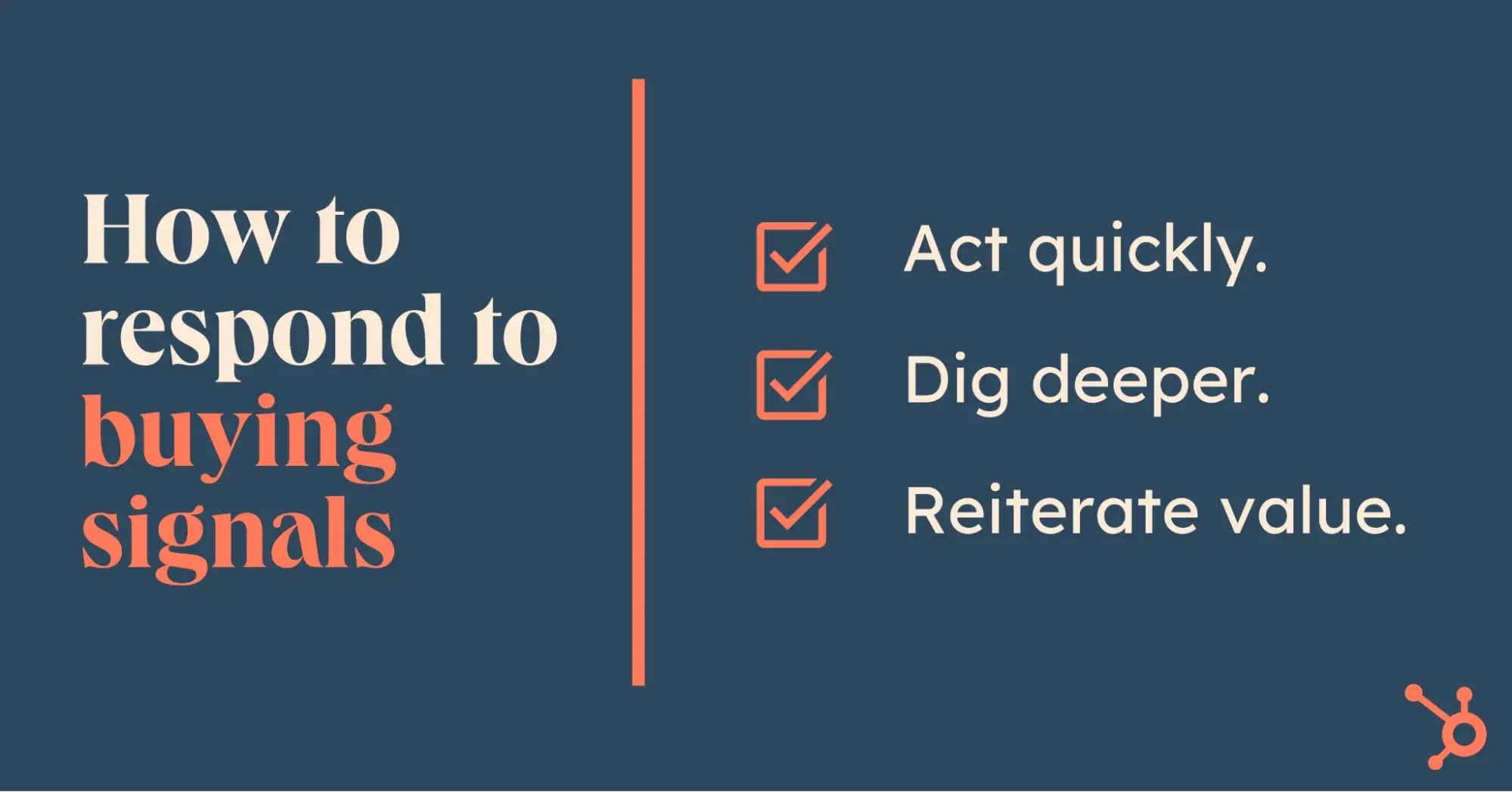
1. Act quickly.
Timing is everything, and you should jump on signals when you see them. For example, say a prospect has posted about an issue they’re having on social media. That means they’re likely in the awareness phase, and they’ll soon be gathering information on possible solutions. Wait too long and you’ll be compared against the entire market of possible solutions, or worse, they will have made a decision without even considering you as an option.
2. Dig deeper.
Some signals are opportunities to learn more about a prospect’s needs. For example, whenever I was asked if my company’s software integrated with another vendor, I’d take advantage of that glimpse into the prospect’s broader tech stack and use it to infer what high-level problems they were hoping to solve. Do they want better results? Increased efficiency? More agility? Use the clues you’re given and ask for more information.
3. Reiterate value.
Buying signals often reveal a prospect’s top priorities. For example, when asked how quickly they could complete onboarding and implementation, I’d safely assume they were looking to move fast. Knowing this, I would reiterate that yes, they could get onboarded quickly, and also explain that I would accelerate things where possible.
For example, marking their contract redlines with high priority for the legal team might shave an additional 3-5 days off the implementation timeline. Show prospects you know what they value, and that you’ll make it a top priority as well.
Examples of Buying Signals
So what are real buying signals I’ve come across out in the wild? This list is far from exhaustive, but here are several of what I would consider the “Greatest Hits.”
- Asking about pricing. A soft signal, but it shows they’re envisioning the purchase.
- Inquiries about contract details. If they’re digging into the contract, they’ve probably narrowed their search down to your solution and a few others.
- Bringing in other stakeholders. One of my favorite signals to see — no one wants to waste the time of someone else on their team, so you’re in a good spot when they include other decision-makers.
- Expressing pain your product solves. If they’re venting about their current situation, they’re inviting you to show them how your solution will change it.
- Requesting references. They’re looking for validation.
- High degree of responsiveness. Your solution is a priority for them.
- Direct comparisons to competitors. They consider you viable, but want to make the right choice. Highlight your strengths for their specific needs.
- Engaging with content. Another soft signal — they might still be gathering information, but if they’re leaning on your content for insights, your solution will probably be a consideration at least.
Remember, a single in isolation certainly doesn’t guarantee a sale — but I’ve had the best results closing deals when I see several of these buying signals throughout the sales process and respond to them.
How Buying Signals Made Me a Better Salesperson
Looking back on my sales journey, I see that learning to spot and respond to buying signals has been critical. You can never truly separate sales from numbers (more at-bats means more opportunities), but you also can’t ignore the fact that not all opportunities are created equal. A strong grasp of buying signals taught me to invest my time into the deals that offered the most value and the best chance of closing.
Using buying signals isn’t about some high-pressure tactic or sleazy manipulation. It’s about being in sync with the buyer and understanding what they need and value out of a solution. When they’re enthusiastic about something, you’re sharing that excitement and helping them move toward their end goal. When they’re hesitant, you’re slowing down to address an important need.
It’s a dance, not a shove, and it’s one I recommend that you learn to master.
![]()
9 sales email templates to inspire urgency in your prospects
Most salespeople face the same persistent challenge: Their prospects lack urgency. There are a number of strategies — both successful and unsuccessful — reps use to overcome this inertia. Often, they end up offering huge discounts with expiration dates. While this technique might result in […]
SalesMost salespeople face the same persistent challenge: Their prospects lack urgency. There are a number of strategies — both successful and unsuccessful — reps use to overcome this inertia. Often, they end up offering huge discounts with expiration dates.
While this technique might result in an initial sale, I advise against it because the company‘s margins and the rep’s commission bonus both take a hit. Once other potential customers learn the business‘s salespeople are willing to discount heavily, it’s difficult to sell at full price. The solution?
Create authentic urgency using an effective urgent email template.
I’m sharing my nine best sales email templates that encourage your prospects to buy sooner rather than later without resorting to discounting or manipulative tactics. Let’s dive in!
Table of Contents
- 9 Urgent Email Subject Lines & Templates
- Tips for Expressing Urgency in Emails
- Urgent Reminder Emails — My Final Thoughts
There are many different emails in your sales arsenal, like the professional reminder email, email notifying of an overdue payment/unpaid invoice, etc. Today, we’re going to focus on the most critical part of the lead cycle: getting a lead to buy.
I recommend developing your own personalized email templates (using data like open and click rate) within the free HubSpot Email Builder. Send emails, see which perform best, and then turn those into new templates with just a few clicks. Instead of copying and pasting the email templates over from this article, they’re stored directly in your HubSpot email template library.
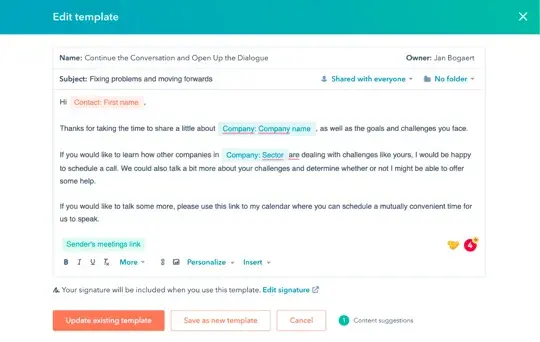
Now, let’s dive into those urgent email templates.
Template 1: “What your competitor is missing”
Subject line: What [prospect’s competitor] is missing
Hi [prospect name],
I recently got off the phone with someone in [relevant department] at [company in prospect’s space]. [Company] is doing some really interesting things around [business area prospect is interested in].
Would you like to hear how I think [prospect’s company] could apply some of those takeaways?
Best,
[Your name]
Why I think it works: Mentioning the buyer‘s competitor will immediately spark their fear of falling behind. They’ll be eager to learn how they can update their strategy — meaning you‘ll get a response asking when you’re available.
Better yet, include a link to your calendar so they can schedule a meeting right then and there. While you may be eager to hit send before setting up your calendar scheduling link, I know you’ll be relieved by the ease of scheduling calls this way.
This message is also compelling because it establishes your knowledge of the space. You show you‘re not only familiar with the competition, but have valuable information about their game plan as well. Of course, never invent a conversation that didn’t happen. Lying is no way to make a sale.
Template 2: “How does your company compare?”
Subject line: [Prospect’s company] compared to average?
Hey [prospect name],
I‘m impressed by your [campaign for X, recent company announcement about Y, work in Z area]. I’d expect your results to be above the [industry, vertical, market] average.
Would you be interested in discovering exactly where you stand compared to your peers?
Best,
[Your name]
Why I think it works: With your inside view into companies with similar products, missions, locations, audiences, and so on, you’re ideally positioned to extend this offer — and few are more enticing.
It’s win-win-win: If your prospect is hitting it out of the park, she‘ll want to see just how heartily she’s beating the other companies in her space.
If she‘s doing good but not great, the buyer will want to learn her current margin so she can increase it. And if she’s failing, she’ll be curious to know if everyone else is struggling even more than she is.
I like the benchmarking approach because it uses curiosity to generate a response, and it leads with your value.
Template 3: “Thoughts about your issue with X”
Subject line: Thoughts on [likely challenge]
Hi [prospect name],
Lately, I‘ve spent some time thinking about [challenge prospect is likely facing]. It’s a big issue for companies like yours — after all, [reason why this pain point is significant].
I don’t have a full-fledged solution yet. However, I do have a couple of ideas that could make a difference. Do you want to hear them?
Best,
[Your name]
Why I think it works: Leading with a relevant pain point tells your prospect that you’re knowledgeable — and just as importantly, empathetic and helpful.
By admitting you don‘t have the perfect answer, you’ll seem genuine rather than salesy. The buyer will feel compelled to reply and learn what you’ve come up with.
Template 4: “Taking X step”
Subject line: Taking [X step] at [prospect’s company]
Hey [prospect name],
I saw you haven‘t [updated X strategy, changed over to Y system, added Z policy]. While I don’t want to ring any unnecessary alarm bells, I think you‘re risking your company’s [long-term growth in A, health in specific area B, plans for C].
Here‘s the first thing I’d do: [Actionable suggestion or high-level tip]. If you’d like to hear the next steps, let me know.
Best,
[Your name]
Why I think it works: Bring your prospect‘s inaction front and center. Once you’ve reminded them they still haven’t made any progress, they typically want to correct that as soon as possible.
To make sure the buyer follows up with you — rather than coming up with their own plan — I recommend that you give them a solid tip. They’ll quickly see you as a source of guidance.
Template 5: “Biggest takeaway from our call today”
Subject line: Biggest takeaway from our call today
Hi [prospect name],
I‘ve included a recap of what we discussed today. One of the most significant insights from our conversation: You’re currently [losing X per month, missing out on Y per week, at a huge risk for X]. The sooner [prospect’s company] [solves this challenge, takes this opportunity], the better.
Main items covered:
- [Item #1]
- [Item #2]
- [Item #3]
I’m looking forward to speaking again on [date and time]. Do you have any questions I can answer in the meantime?
Best,
[Your name]
Why I think it works: This email reinforces the urgency you (hopefully) instilled during the call. Its straightforward, neutral tone conveys confidence and tells your prospect you’re not wasting any time or words.
Start with a polite greeting, keep the tone professional, and make it clear that this email requires prompt attention. They‘ll start taking the matter seriously, if they haven’t already.
Template 6: “Timeline for accomplishing Y by [date]”
Subject line: Timeline for [doing X] by [date]
Hi [prospect name],
Glad we got the chance to discuss [topic] today. [Important event] you mentioned is just X [days, weeks, months] away — if you want to have a strategy for [achieving Y] by then, you’ll need to follow this timeline:
- [Action step #1] by [date]
- [Action step #2] by [date]
- [Action step #3] by [date]
Are you available on [date and time] to talk about [action step #1]?
Thanks,
[Your name]
Why I think it works: Remind your prospect time is of the essence. To hit their goals, they can’t let this deal slip to the bottom of their to-do list.
I’ve found that providing a sample timeline is effective for two reasons. First, it’s a major value-add: Rather than figuring out what they need to do and when, the buyer can follow your plan.
Second, it structures the sales conversation. Your prospect will know what to expect from each stage, which makes them feel more secure.
Template 7: “Few more suggestions for accomplishing your goal”
Subject line: Few more suggestions for [solving X]
Hey [prospect name],
Now that I‘ve had some time to think about our last conversation on [date], I’ve come up with a few more suggestions for [solving X pain point, meeting Y objective, exploring Z opportunity]. You’ll be excited to hear these.
Do you have some time in the next week?
Here’s a link to my calendar so you can book a time that works: [Link].
Cheers,
[Your name]
Why I think it works: This follow-up email template — which isn’t for the faint of heart — lets you take back control of the sales conversation.
First, the offer gives your prospect a great reason to reply. Who doesn’t want free, no-strings-attached ideas for hitting their goals or improving their business?
Telling the buyer they‘ll be “excited to hear” these ideas also shows a lot of confidence, as does linking to your calendar rather than asking if they’re available on a certain date and time. Typically, this self-assurance makes you seem more credible.
Template 8: “How [customer] got Z results”
Subject line: How [customer] achieved [X results]
Hi [prospect name],
[Prospect‘s job title] at [rep’s company] is always busy doing [X, Y, and Z] — so I assume you’ve got a full plate as well.
But spending some time upfront to put in place a solution for [pain point] will pay off exponentially. [Customer], for example, [saved X hours per week, trimmed Y from their budget, made Z more per month] after using [product].
Are you free on [date and time] to pick up where we left off?
Thanks,
[Your name]
Why I think it works: Guilt-tripping the buyer for their unresponsiveness doesn‘t work — they’ll either feel annoyed or ashamed, neither of which prompts them to reply.
So, use a different approach. Show that you‘re not taking it personally that they haven’t gotten back to you: Based on your relationship with their counterpart at your company, you know they’re slammed.
Then, remind your prospect that they really can’t afford to wait. I’ve found that this one-two punch of empathy and urgency convinces buyers to answer every time.
Template 9: “[Name], you’re a special case”
Subject line: [Prospect‘s name], you’re a special case
Hi [prospect name],
Normally, I stop following up with people if they haven‘t gotten back to me after [X weeks]. I figure they’re not interested, and I don‘t want to waste anyone’s time.
However, my conscience won‘t let me give up so easily with you. Based on our conversations on [date and time] and [date and time], I’m confident you could [solve X pain point, capitalize on Y opportunity] — which will allow you to [get that promotion to X role, increase your team’s output by Y amount, outperform your competitors in Z area].
So before I walk away: Are you sure you’re not interested in [solving X, capitalizing on Y]?
Best,
[Your name]
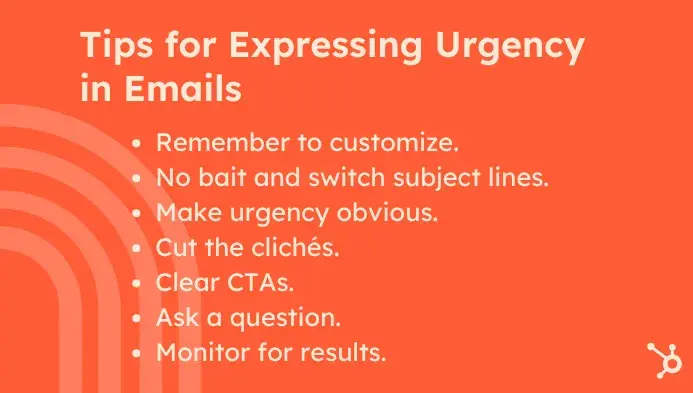
Remember to customize.
Yes, it sounds so obvious it doesn’t even need to be said. But then why do I have emails addressed to “Dear [insert name]” sitting in my inbox right now? Even when writing an urgent request, no one should be in a rushed or careless state.
Personalization matters: 82% of sales professionals surveyed in our Sales Trends Report said that connecting with people and building relationships is the most important part of selling.
All of my email templates shared above use brackets — search your email for them using Ctrl + [ or Command + [ to ensure you’ve removed all of the placeholders before hitting send.
Or, use email software with built-in customization, like the free HubSpot Email Builder. You can quickly customize emails with all the details leads expect, like:
- First name, company name, etc.
- Relevant documents.
- Your meeting links.
Plus much, much more using our built-in AI feature. See it in action here:
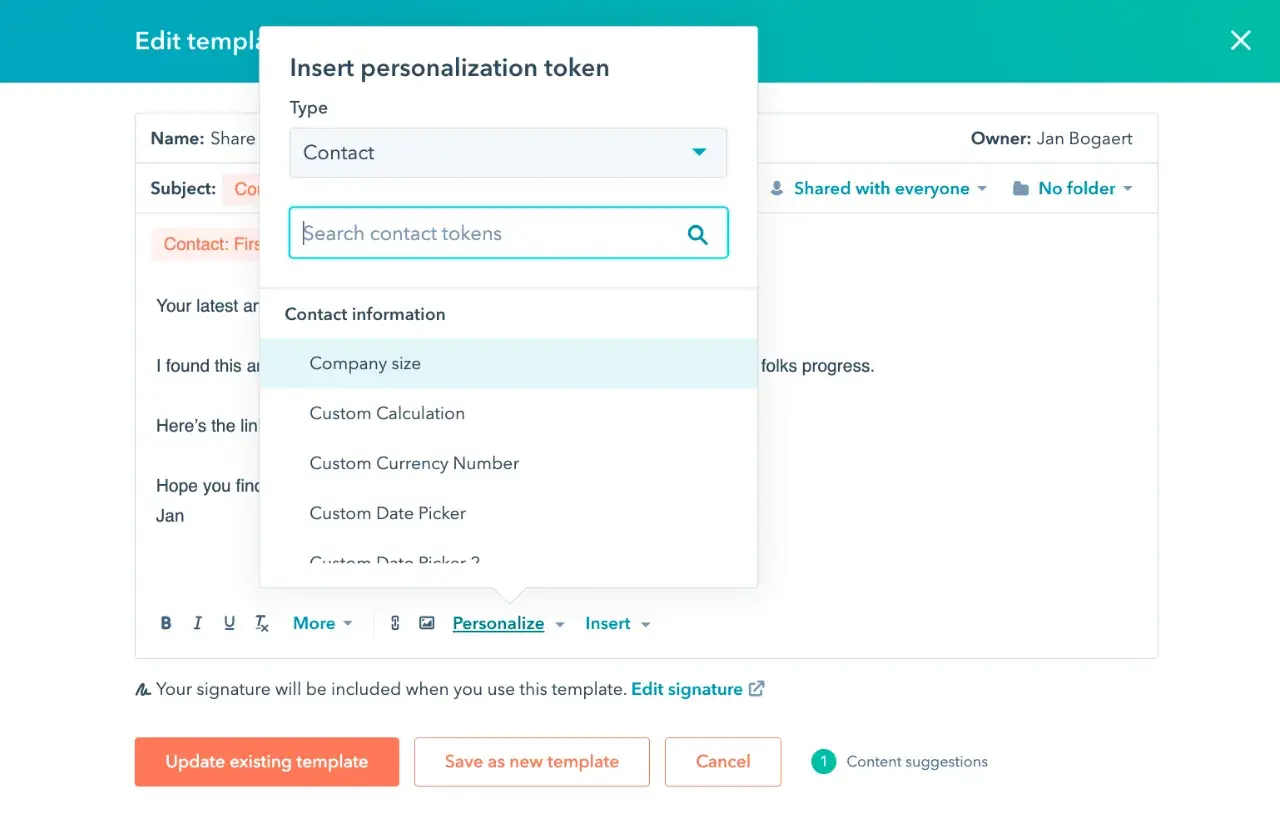
Saving time with AI: 81% of sales professionals surveyed in our Sales Trends Report said that AI can help them spend less time on manual tasks, saving up to two hours a day.
This works in both automated email sequences and one-on-one emails. I love how this feature makes it so easy to add more depth to emails. It moves beyond using first names and gives readers the feeling that you really remember them.
Urgency example: You‘re sending a live demo reminder. The name, time, date, time zone, link, etc. must be customized correctly or the upcoming event will be missed, and you’ll lose your chance to sell live to your prospect at the end of the demo.
No bait and switch subject lines.
No one wants to get an email that says “Found your wallet! — Just kidding, but while I have you here…” This is a real example!
Sure, tricks can yield high open rates. It might even trigger an immediate response! But it will rarely be a positive response. A clear subject line wins every time.
Urgency example: Instead of a goofy subject line, let readers know about a time-sensitive matter like a discount code, invitation, or opportunity that’s expiring. Inspire FOMO (the fear of missing out) instead of an eye roll.
Make urgency obvious.
Most people skim their inboxes looking for whatever requires immediate attention. If you want readers to respond immediately, then a sense of urgency is required in your subject line and email body. Clear and concise language will yield the best response.
Urgency example: Mention any scarcity factors, such as limited call spots or expiring deals, to get the reader’s attention and inspire a prompt response.
Cut the clichés.
Raise your hand if your eyes glaze over these overused email phrases:
- Look forward to hearing from you.
- Make time in your busy schedule.
- Hope this email finds you well.
- Kind regards/best regards.
- Just a gentle reminder.
- Earliest convenience.
- Quick reminder.
“Hope this email finds you well” is so overused that it was turned into a viral meme during the pandemic:
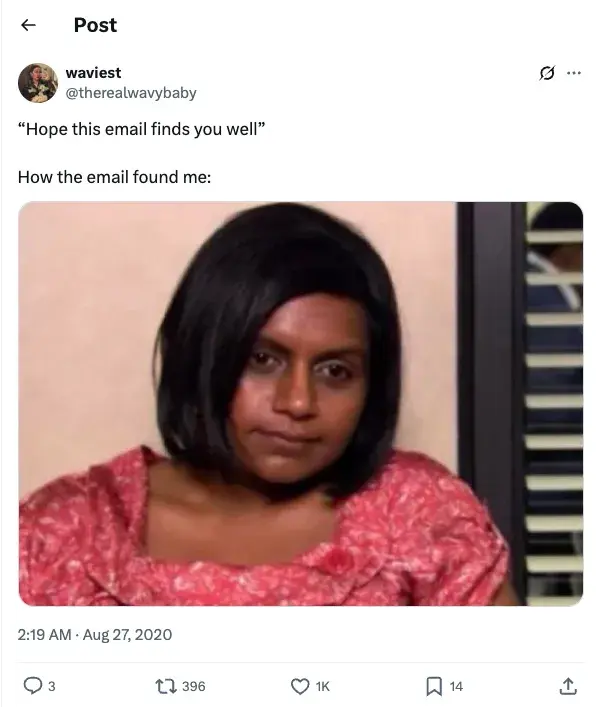
Now, there‘s nothing wrong or unprofessional about these well-wishes — they’re just overused (to the point that you probably have all of these clichés sitting in your inbox right now).
Urgent follow-up emails need to get the reader’s attention. Thoughtful email copy will help achieve that more than overused filler.
Urgency example: Swap out filler like “looking forward to hearing from you” with a time-sensitive push like “reminder that link expires in 48 hours.”
Clear CTAs.
A reader shouldn’t have to wonder how to take action on your email. Proposition readers with one clear call to action per email.
Again, try touching the reader‘s FOMO when writing your CTAs. What will they miss out on if they don’t act? Consequences are important in urgent emails.
If you want your email to be addressed promptly, consider touching on one of these fears:
- Trend/seasonal relevance will pass.
- Event registration closing.
- Discount code expiring.
- Price increasing.
- Spots filling up.
Urgency example: You‘re running a time-sensitive promotion. If your CTA doesn’t reflect that, viewers miss out and don’t buy from you.
Ask a question.
Sometimes, leads take longer to convert. You might not make a sale with this email sequence, but you can still develop the relationship if you keep the conversation going. Add a question to every email template to achieve this.
If you forget to include a question inside the free HubSpot Email Builder, you’ll get reminder messages like this thanks to the “content suggestions” feature:

Monitor for results.
Like all sales efforts, monitoring and optimization are key. You can do this manually by gathering data from multiple tools and tracking in a spreadsheet, or you can use email tools with built-in analytics like the free HubSpot Email Builder.
At a glance, you can see open rates and clicks for your email templates:
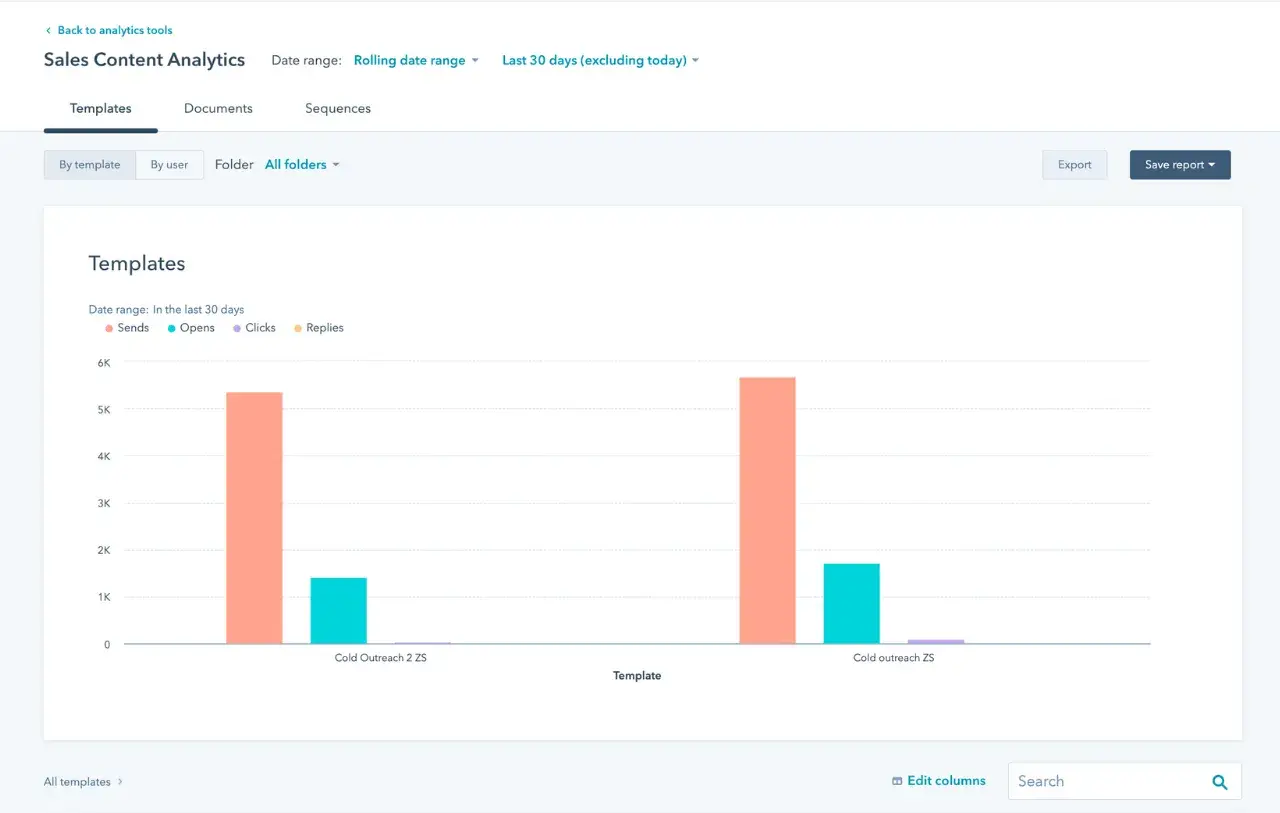
Then, rather than recreating the most successful emails manually, you can turn them into email templates:
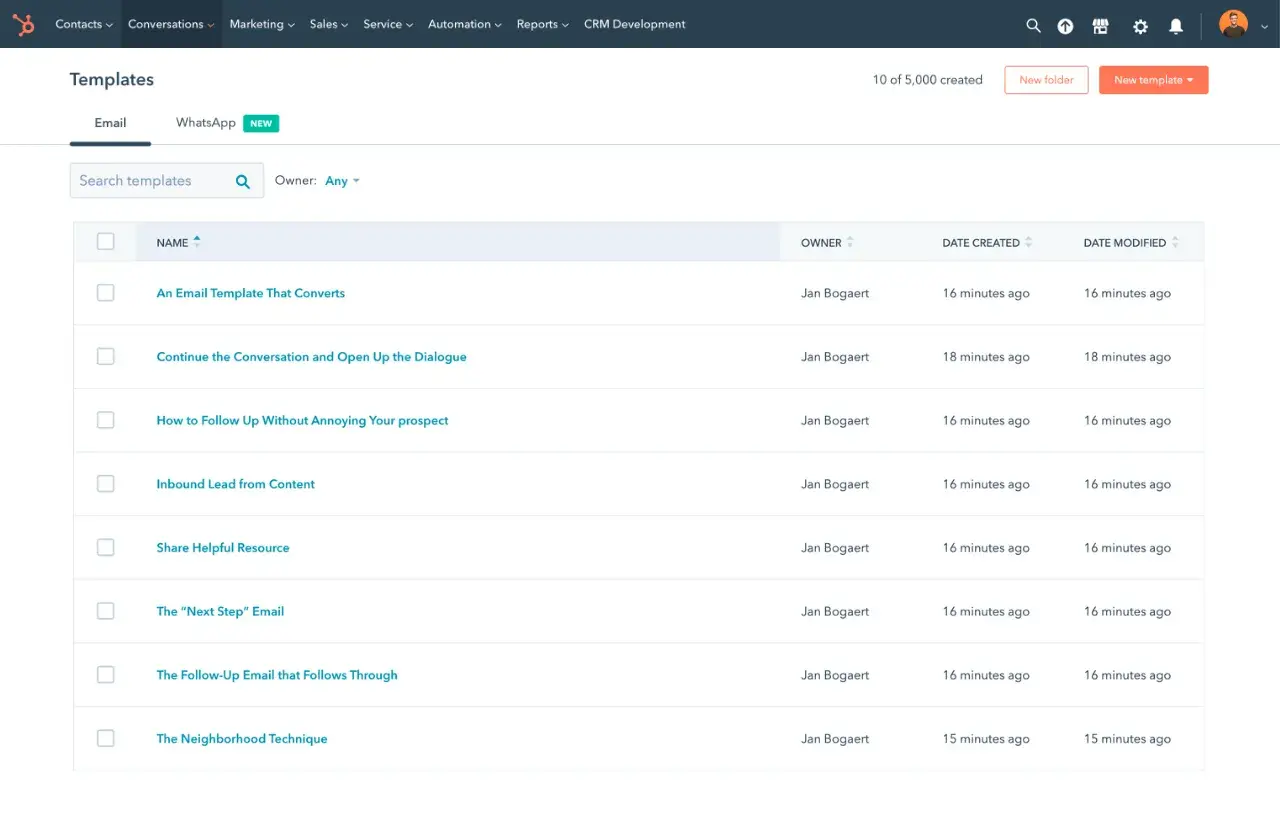
The more emails you send through your HubSpot account, the more data and actionable recommendations you’ll be given:
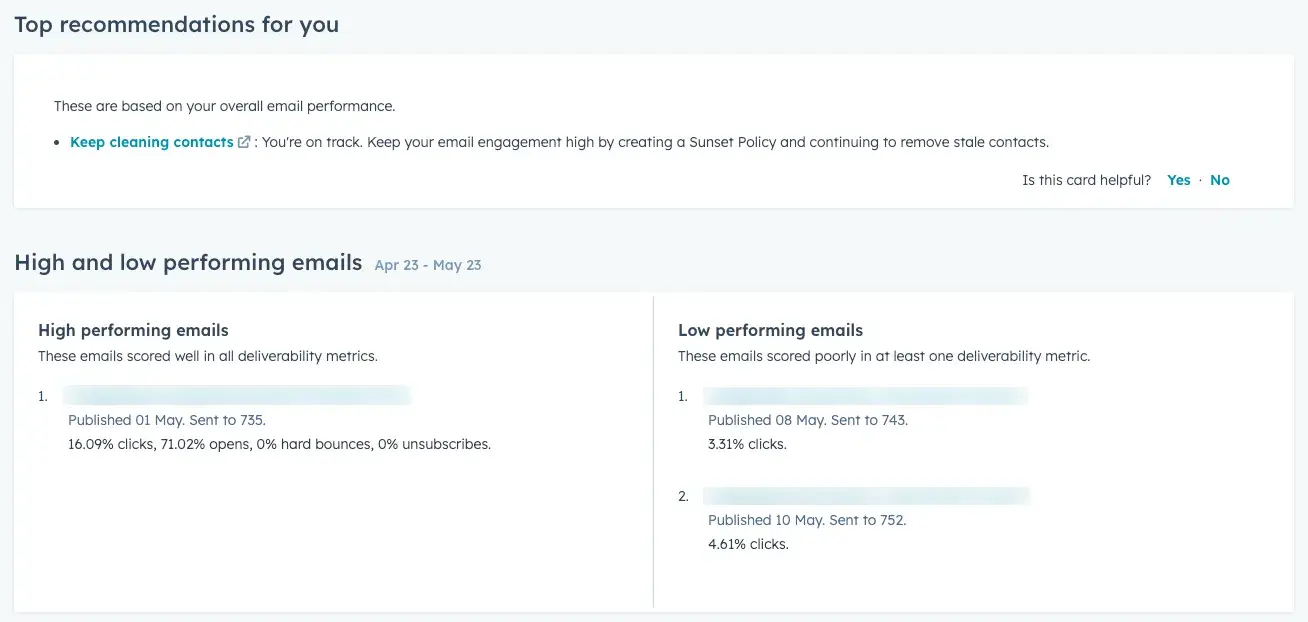
A data-first approach to your urgent email template will fuel more growth than being guided by guesswork.
Urgency example: You notice that the fourth message in your email campaign is where readers lose interest and stop opening emails, so you add a time-sensitive offer to incentivize opens.
Urgent Reminder Emails — My Final Thoughts
I know that sending an urgent request in a sales email can be difficult — asking for urgent attention is a delicate act in sales. With these free email templates up your sleeve, kindling urgency becomes as simple as pressing “Send.” Customize them to fit your prospects and monitor performance.
![]()
How to use buyer journey keyword research to unlock SEO-generated revenue
I know the impact of ignoring buyer’s journey keywords all too well. Early in my SEO career, I generated two million clicks for an ecommerce store. The client and I were thrilled. The graph on Google Search Console was trending strongly up. The problem? I […]
MarketingI know the impact of ignoring buyer’s journey keywords all too well. Early in my SEO career, I generated two million clicks for an ecommerce store. The client and I were thrilled. The graph on Google Search Console was trending strongly up.
The problem? I couldn’t quantify a single sale from two million visitors. I had no idea how to generate a keyword strategy for buyers.
I learned my lesson the hard way. Now, everything I do in SEO is centered around the buyer and the end goal: a sale. Using buyer journey keywords, I can better quantify the value of my work. I know which landing page converts and which keywords influence sales, and I can quantify the monetary contribution articles had on sales. Keep reading to learn how.
Table of Contents
- The Role of the Buyer’s Journey in Keyword Research
- Keyword Intents for Each Buyer’s Journey Stage
- How to Do Keyword Research for Each Stage of the Buyer’s Journey
- Tips for Doing Keyword Research Aligned With the Buyer’s Journey
The Role of the Buyer’s Journey in Keyword Research
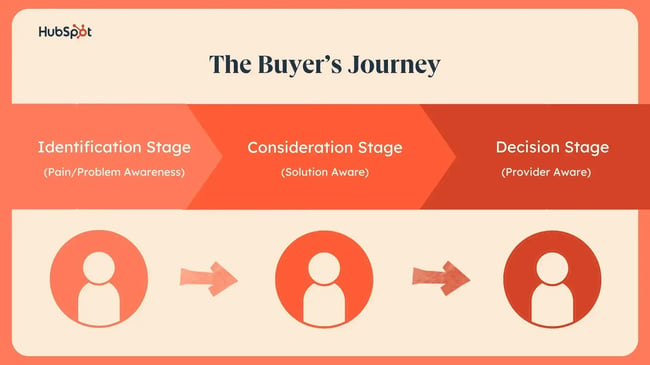
The buyer’s journey includes the steps a potential buyer will take before they purchase. SEOs who want to serve buyers and sell products or services need to understand the buyer journey to effectively strategize content.
Generally, the buyer journey will have three stages:
- Identification = pain and problem awareness
- Consideration = solution awareness
- Decision = provider aware
Sometimes, it’s represented in a funnel, known as the marketing or conversion funnel. I’ve placed an image of one below. You may also know these stages as:
- Awareness = Top of Funnel (ToFu)
- Consideration = Middle of Funnel (MoFu)
- Conversion = Bottom of Funnel (BoFu)
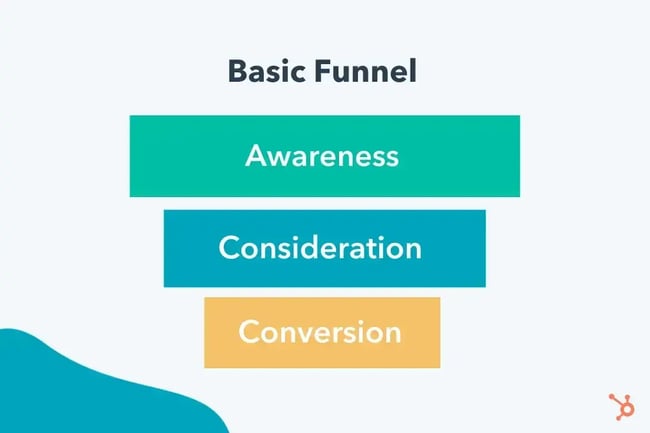
Understanding buyer’s journey keywords will pivot your SEO strategy from clicks to revenue, which matters for every business. Google is serving more of your potential buyers with AI overviews, which appear in 47% of results. Now, people can just read the AIO without clicking a link. So, SEOs must be tactical to win clicks and conversions.
Keyword Intents for Each Buyer’s Journey Stage
Each buyer journey stage has a separate need that you need to meet by matching the right keywords to the right stage. Meeting the buyer at different stages on their journey isn’t always about sealing the deal but building relationships.
In the State of Marketing survey, HubSpot found that marketers believe that building connections across the buyer’s journey and developing relationships at scale introduces new operational needs.
Awareness
The buyer has identified a problem but doesn’t fully understand it or doesn’t know a solution exists. They are seeking general information or education to clarify the issue. This stage is about discovery and research.
This stage of the buyer journey needs helpful, educational content to better understand the problem or opportunity.
Keywords for this buyer journey will be problem-based and question-driven, such as “how to,” “why does,” or “what is.” These terms align with the buyer’s intent to learn and explore their situation without feeling sold to.
Here’s an example of a buyer in the awareness stage and the keywords to support them.
Consider that a buyer in the awareness stage is using keywords about a problem. For example, a sales manager might research:
- Why doesn’t my team follow up with leads?
- How to motivate a sales team.
- Processes to manage leads.
During this stage, content wants to educate the buyer. While this top-of-funnel content might not seem the most impactful for sales, according to Hubspot’s State of Marketing survey, the website and blog are some of the most effective channels for ROI.
Consideration
The buyer understands the problem and is exploring different approaches or solutions. They are actively researching options and comparing them.
This stage of the buyer journey needs solutions and guidance on which route might be best for them.
Keywords for this buyer journey will be comparison and solution-oriented keywords like “best tools for,” “top strategies,” “[solution] versus [solution]” or “solution to [problem].” These help your content show up when the buyer is evaluating ways to solve their issue.
Here’s an example of a buyer in the consideration stage and the keywords to support them.
Let’s stick with the example of a buyer looking for a CRM. In the consideration stage, they will know what their options are, and they might be overwhelmed. They are looking for support and want help weighing up solutions.
Conversion
The buyer is ready to make a decision and take action. They’ve narrowed down their options and are looking for reassurance, offers, or reasons to choose your product or service.
This stage of the buyer journey needs to reassure the buyer’s confidence in your solution and make conversion easy and tempting.
Keywords for this buyer journey will be targeted, intent-driven keywords like “buy,” “get a quote,” “pricing,” or “[product/service] near me.” These align with transactional searches and indicate the buyer is close to making a purchase.
Here’s an example of a buyer in the conversion stage.
If looking for a CRM, the buyer is ready to click “Start Free Trial.”
The key things to understand are:
- Every buyer goes through a series of stages before they buy.
- Not every buyer starts at the awareness phase.
- The three stages above could be considered broad stages, and each has its own nuance, varying by industry, business, customer, and more. You need to understand your buyer’s journey before you can serve them.
- At each stage, buyers have different needs.
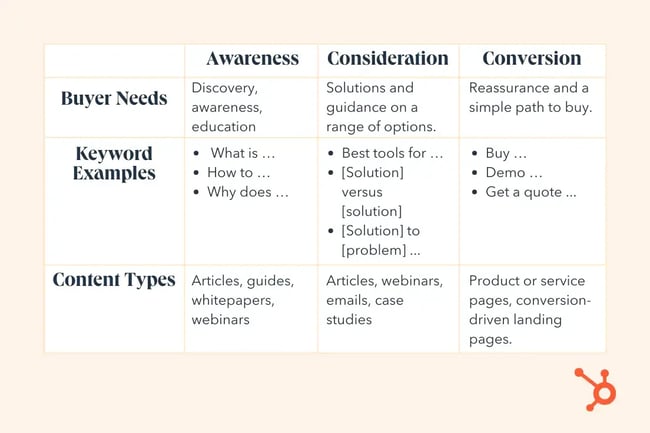
How to Do Keyword Research for Each Stage of the Buyer’s Journey
Now you understand the context of the buyer journey, each phase, and some ideas of keywords, I’ll walk you through a step-by-step process of how I do keyword research for each stage of the buyer’s journey.
When doing keyword research, it’s tempting to start from the top with the awareness stage, but I reverse this process and start at the bottom buyer journey stage, conversion. I start with conversion for two main reasons:
- Conversion-driven keywords are the most important.
- Starting with conversion keywords keeps me focused. You can quickly become overwhelmed by the content opportunities starting ToFu.
Stick with me as I share the complete guide.
Step 1: Prepare a Google document.
I love to record my buyer journey keyword strategy on Google Sheets. For now, you don’t need to do anything fancy.
Simply set up a document and save it somewhere safe. You will use this document to import all your keyword research.
Step 2: Identify your bottom-funnel keyword.
There are many ways to gather bottom-funnel keywords. If you have a strong and well-managed ads account, start there.
Use Google Ads to identify buyer journey keywords for bottom-funnel keywords.
To find keywords that convert, follow these steps:
- Sign in to Google Ads.
- Click “Insights and Reports,” then “Search Terms.”
- Filter the table by the highest conversions.
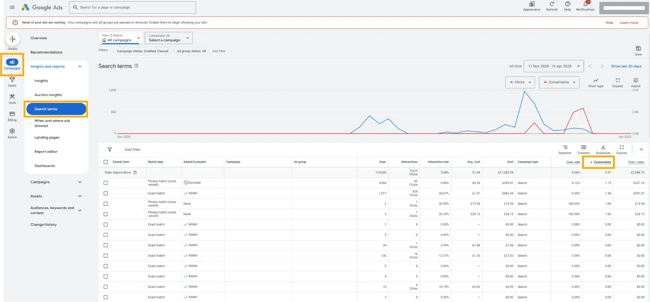
The screenshot above shows a redacted Ads account for one of my clients. It shows the steps you take to find the keywords.
I want to note that not all keywords in the ads account work. The highest-converting keyword is excluded because although it received conversions, it didn’t get sales. The ads manager excluded this keyword, so SEO should likely exclude it, too.
Top tip: Many of the highest-converting keywords will include your brand name. You will be ranking for these anyway, so don’t focus on them. Choose keywords that you need to work on to increase rankings.
Research buyer journey keywords using SEO tools.
SEO tools such as Semrush offer insights into keywords, volumes, and intent. There are many on the market, but my favorite is Semrush, so I’ll demonstrate this stage using Semrush’s Keyword Magic Tool.
On your chosen keyword research tool, add your head keyword. Your head keyword will be the product or service you are selling.
For this example, I’ve chosen “CRM.” Many keyword research tools allow you to filter results, including “transactional” keywords, which are likely to convert.
You need to:
- Identify your head keyword.
- Search it in your keyword tool.
- Filter results by “transactional” intent keywords.
- Manually review keywords, choosing the keywords that work for your business.
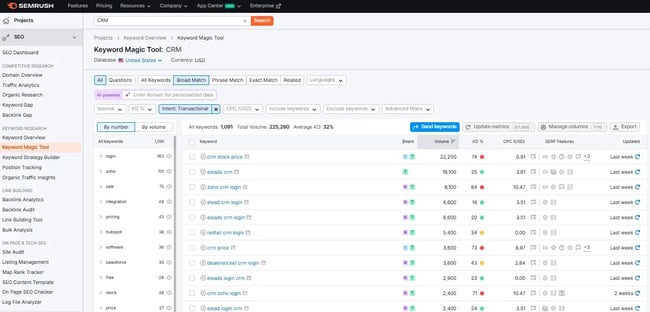
Top tip: Don’t worry too much about search volume and keyword difficulty. Generally, conversion keywords are the most difficult to rank for and often have lower search volumes. Remember the funnel from earlier? The smallest section is at the bottom, as users at this point in the buyer journey reduce.
Research buyer journey keywords using Google Search Console and G4.
Google Search Console is not the easiest way of identifying buyer journey keywords, but it is free, so I’ve included it.
To determine whether a keyword is helping you make sales, you need to understand how users engage with the pages the keyword drives traffic to.
First, let’s find pages that convert.
- Log in to G4.
- Navigate to Reports
- Navigate to Life Cycle > Engagement> Landing Page Report
- Filter by revenue
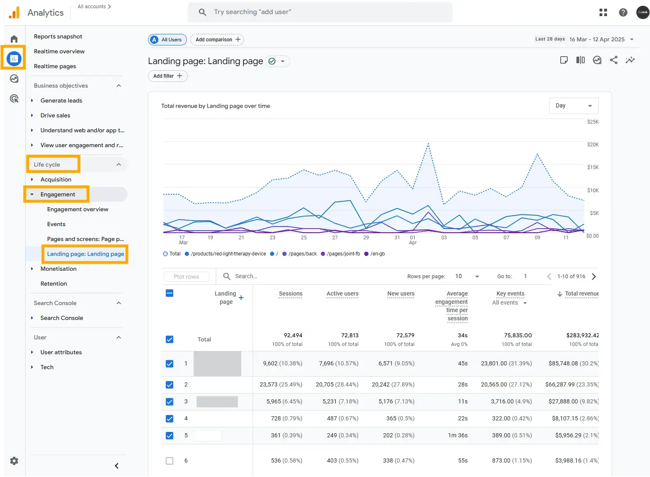
Take your highest-performing pages and analyze the URL in Google Search Console (GSC).
- Log in to Google Search Console.
- Go to Search Results.
- Click “Add Filter.”
- Add a page.
- Add the URL.
GSC will filter all keywords generating clicks for the page input. Review the keywords and identify if keywords are likely to result in a sale.
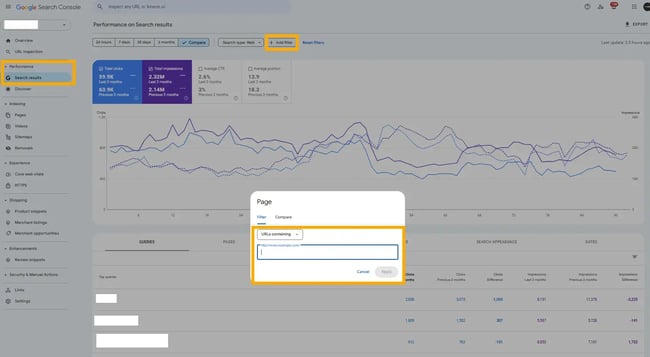
Top tip: Google Search Console won’t tell you which keywords are converting, so you’ll need to use some common sense.
Step 3: Conduct keyword research for middle funnel (consideration) buyer journey keywords.
From the stage above, you should have a list of keywords that you’d love to rank for. These are your bottom-funnel or conversion keywords.
Generally, these keywords are used on:
- Product pages
- Service pages
- Conversion-driven landing pages
Later, I’ll discuss keyword mapping so you know exactly where to place your keywords.
Before creating more content, though, I like to ensure I have the content available to support bottom-funnel pages in a way that builds E-E-A-T. I like to start with the next most important item, which is content that fits the middle-funnel buyer’s journey: Consideration.
The type of content we can use for keyword research includes:
- Case studies.
- Reviews.
- Some articles.
You likely already have these pages on your website. I might take these pages and put them into Google Search Console to see if I can find any relevant keywords. To do this, use the steps above for keyword research and filter by page.
Important note: Your review keywords are really important and often missed by brands. I see too many websites that lack a review page and therefore give clicks away to review sites or even social media. You want a page on your website that showcases your reviews and manages your brand narrative.
Top tip: If you don’t find much in terms of keywords and search volume, don’t worry too much. Not every piece of content for the buyer journey has to be for SEO. Some content can be shared with other marketing departments via email, for example.
Step 4: Conduct keyword research for top funnel (awareness) buyer journey keywords.
Finally, I identify keywords for the awareness buyer journey stage.
Visualize the funnel from earlier. The funnel shape provides a visual for the traffic volumes at each stage of the buyer journey. Awareness is at the largest point of the funnel because it has the most searches, keywords, and users. As you get further down the funnel, it narrows because the audience gets smaller.
To do keyword research for this phase, I go back to Semrush, following the steps above, and navigate to the Keyword Magic Tool. I remove filters for the intent and look at Questions as well as keywords to see which keywords inspire content.
Important note: The tools do a fantastic job of providing keyword inspiration, but there is no replacement for talking to customers and your peers. Ask sales what types of questions people ask. Find out exactly who your target audience is and what they need from you. It’s very easy to get distracted at this stage. You must create content that your audience needs.
Creating the right content and targeting the keywords your audience needs has never been more important. With the rise of AI, top-funnel keywords get far fewer clicks as AI overviews serve the buyer. You need every click to count.
Step 5: Understand search intent and SERP analysis.
These next two steps are my favorites.
You might already have an idea of where you’re going to use your keywords. Bottom-funnel keywords are generally pretty self-explanatory. “Demo CRM,” for example, clearly needs to go to a page where a CRM can be demoed.
Many keywords won’t be as self-explanatory, though.
I like to use Google in private browsing, so the search engine results pages (SERPs) are not tailored to my usual search history.
Let’s Google “best CRM for sales and marketing teams,” and I’ll show you how I analyze the SERPs.

Here’s what I’m thinking when I look at these SERPs:
- Which pages are ranking? Looking at the organic listings, all pages, bar the top result, are product pages with “demo” or “free” in the URL and or title tag.
- Which SERP features are available? I can see People Also Ask, videos, and review snippets.
- Priority is given to the Zapier round-up article and videos.
From this information, you can gather:
- The type of page you need to rank (a product page).
- Components to include on the page (video, questions, aggregateRatings schema).
- Videos are a high priority and should be added.
What you’re doing here is using Google’s “understanding” of the searcher’s needs to determine what they want and what you’ll create to meet it.
Google has a complex algorithm dedicated to providing helpful content to its users. Google’s success in being helpful and providing quality information is paramount to its success as a search engine. It’s fairly safe to assume Google has search intent right.
Mimic the content Google is prioritizing (but do it in your own way), and you’ll likely meet user needs.
Step 6: Map keywords to pages.
As an extension of the step above, correctly map buyer journey keywords to the right content. This is called keyword mapping. You assign keywords to the page that have the highest possible chance of ranking.
Once you’ve done the first step, you need to correctly identify your supporting keywords.
A good example to illustrate this point is People Also Ask. I often see websites that see each FAQ as its own page or article, but this isn’t always the most efficient way to map keywords.
For the search “road bike for women,” People Also Ask provides the following questions:
- What is the best road bike for ladies?
- What size road bike do I need for a woman?
- Which bike is best for females?
- Are road bikes good for weight loss?
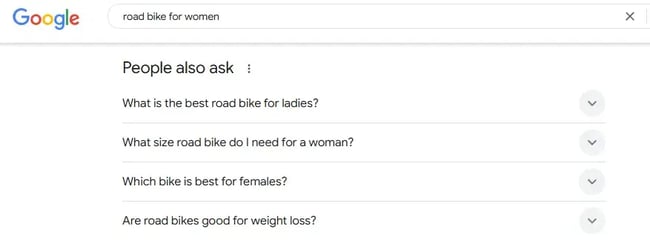
It would be a mistake to use the keywords “What is the best road bike for ladies?” and “Which bike is best for females?” as keywords for the same article.
You can see this in your SERP analysis. When Googled, you can see the ranking articles.
There is one commonality, but the rest of the articles are different. The keyword “What is the best road bike for ladies?” is more nuanced, bringing up results that mention “road,” whereas the other keyword is more general.
Important note: Although this search is an excellent guide, sometimes you need to use common sense and do what is right by your values and business. For example, if you only sell road bikes, you might choose to cluster those keywords together.
I like to record my buyer journey keyword map in Google Sheets. Here’s what my sheet looks like:
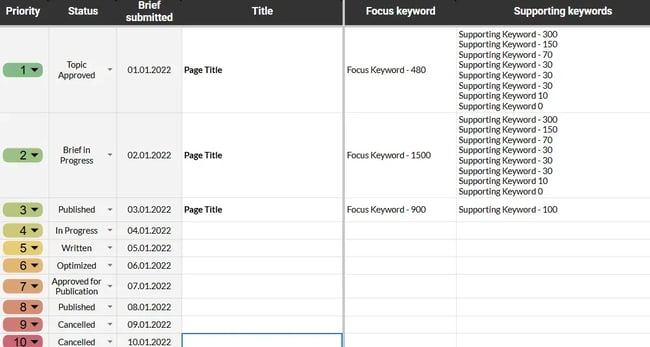
I record a draft title, the page’s focus keyword, and supporting keywords. This way, when I write the content, I know where the keywords are mapped.
If you want more support with SEO content writing, HubSpot’s SEO Marketing Software allows you to optimize your content within one easy-to-use-tool.
Tips for Doing Keyword Research Aligned With the Buyer’s Journey
Finally, here are some final tips to help you feel confident about keyword research aligned with the buyer journey.
Ask customers what they searched to find you.
This tip is easy to implement, especially in B2B, because the person on the other end of the phone likely understands. If you work in marketing, there’s a good chance the buyer will also respect your diligence.
Once you’ve built a good rapport with the prospect, ask them what they searched for to find you.
This information will give you exactly the type of keyword your buyers are searching for.
Start with buyer needs.
If you follow my process for buyer journey keyword research detailed above, you’ll do this, but I can’t stress enough the importance of starting with buyer needs. It’s very tempting to go to the tools and start finding keywords, but you really want to hone in on conversions and scale back from there, discovering impactful keywords that actually help your buyer.
Talk to sales and customer service representatives.
No one knows your customers like sales and customer service. Ask them which questions buyers ask frequently and what you can do in content to address common apprehensions and build trust.
Remember to repurpose content.
Although keywords and SEO are incredibly important, it takes time to rank in the top spots of Google. In the meantime, get content out to your users through other means: ads, emails, social media, etc.
Refer to Google Search Console regularly.
Google Search Console (GSC) data updates frequently. Keep a close eye on keywords you search, clicks, and impressions. Look for new opportunities to add more keywords to your content.
I like to look at high impressions and low clicks to spot keywords people are searching for.
Feeling conflicted about SERPs? Do the integral thing.
Sometimes, you’ll encounter a keyword map or SERP analysis that doesn’t quite feel right. You should always do what’s right for your buyer and business.
I always say that you should do the integral thing first. You might be surprised at what you can rank, even if the SERPs aren’t quite in line with what you want to create. You can always come back and compromise later.
Buyer Journey Keyword Strategy Helps You Qualify Content’s Role
SEO is notorious for being tricky in tracking its contribution to sales. It’s not like ads where you have keywords with sales assigned. Instead, you can only really assign click quantities.
However, there is a major benefit to buyer journey keywords: you know that not everything is created to convert. Some keywords are used on pages that convert, and others are there to build awareness. This means you can alter your tracking accordingly.
- For ToFu pieces, track clicks, impressions, newsletter signups, and return visitors.
- Use segment gap analysis to establish content (and therefore keywords) that contribute to the buyer journey and sales. You can create two segments: purchasers and users who viewed an article and bought it after X time. This helps show the role of content and keywords on the buyer journey..
- Track sales from bottom-funnel pages gaining clicks from bottom-funnel keywords.
- Monitor pages that are generating revenue and ranking only for non-brand keywords.
- Use ad data to determine SEO’s impact. If something converts in ads, then it likely converts organically, too.
Turn Your SEO Strategy Into a Revenue-Generating Machine With Buyer Journey Keywords
Since using buyer journey keywords and building a strategy from the bottom-funnel keyword, I’ve felt much happier with my SEO.
Upward trending graphs are still deeply fulfilling and exciting, but the benefit of generating revenue (and being able to prove it) is far superior.
![]()
How to create an effective Facebook ads strategy in 2025
Facebook ads can be incredibly powerful — when they’re done right. Most marketers say it consistently delivers a better ROI than any other social media platform. There’s just one catch — you need a solid Facebook ad strategy in place before you dive in. Otherwise, […]
MarketingFacebook ads can be incredibly powerful — when they’re done right. Most marketers say it consistently delivers a better ROI than any other social media platform.
There’s just one catch — you need a solid Facebook ad strategy in place before you dive in. Otherwise, Meta’s evolving algorithms, changing audience expectations, and the nuance of different ad types can make things expensive fast.
I work with clients every day who use Facebook ads and rely heavily on ad experts who stay current on best practices. To help you develop a smarter, more effective Facebook ad strategy, I’ve connected with several pros and am sharing their insights in this article.
Table of Contents
- Are Facebook ads worth pursuing in 2025?
- What to Know Before Setting Up Your Facebook Ads
- 11 Facebook Ads Strategy Tips
Are Facebook ads worth pursuing in 2025?
Short answer — yes. Over 10 million businesses are actively using Facebook advertising to reach billions of active users.
Clearly, something is working:
- 43% of marketers we surveyed plan to maintain the same investment in Facebook in 2025 as last year.
- 25% plan to increase their investment in 2025.
- More marketers plan to invest the most in Facebook in 2025 than in any other social media channel.
“Facebook is still the most efficient, scalable ad network for businesses of all sizes. The real question isn’t whether it works — it’s whether you’re committed to doing what it takes to make it work,” says Zachary Murray, founder of Foreplay.co, a creative collaboration and ad inspiration platform for marketers and creative teams.
Which brings me to the longer answer — Facebook ads may or may not be the perfect fit for every business. Before you invest time, money, and energy into them, I always recommend asking three questions:
- Why are you running Facebook ads?
- What results are you hoping to achieve?
- What else needs to be in place for your ads to be effective?
Some background here: I first started playing with Facebook ads in 2012 when it was still the Wild West. You could throw $20 behind a post and see real traction — without knowing much about targeting or creativity.
Today, the platform is considerably more sophisticated, so you’ve got to have your ducks in a row and a Facebook ad strategy designed for your goals.
I share that not to scare you off but to ensure you’re thinking things through. After all, according to Nicole Morton, marketing operations manager at Keystone Click, a digital marketing agency, “Facebook remains one of the largest social platforms and provides diverse ad formats, robust targeting options, and the potential to reach a wide audience.”
So the real question isn’t should you advertise on Facebook — it should be, “How do I make sure it’s worth my time and money?”
And if you want to make sure you’re picking the best Meta channel for your social media strategy, we’ve compared them here to help you make an informed decision.
What to Know Before Setting Up Your Facebook Ads
Based on the questions I shared above, you’ve probably guessed that you need to take a step back before you even think about opening Ads Manager, creating a Meta ad account, or developing creative assets.
Here are four things you need to know to create your first Facebook ad strategy.
1. Know your audience better than they know themselves.
If you want to reach the right people, you need to know who they are and what makes them want to click. Not all marketers subscribe to buyer personas or customer avatars, but in my experience, having them is invaluable before you do any kind of marketing — not just ads. (HubSpot has a handy tool you can use to get started.)
Demographics (age, career, income, location, etc.) are a good place to start — and absolutely necessary for targeting.
As Catherine Wilson, founder of Eviva Media, explains, “The platform allows precise targeting based on location, interests, and demographics, making it ideal for reaching your ideal customers even on a small budget.”
But to ensure your ads can really perform and drive conversions, you’ve got to dig deeper:
- What do they care about most right now?
- What’s going on in their lives that they need your solution?
- What motivates their decisions?
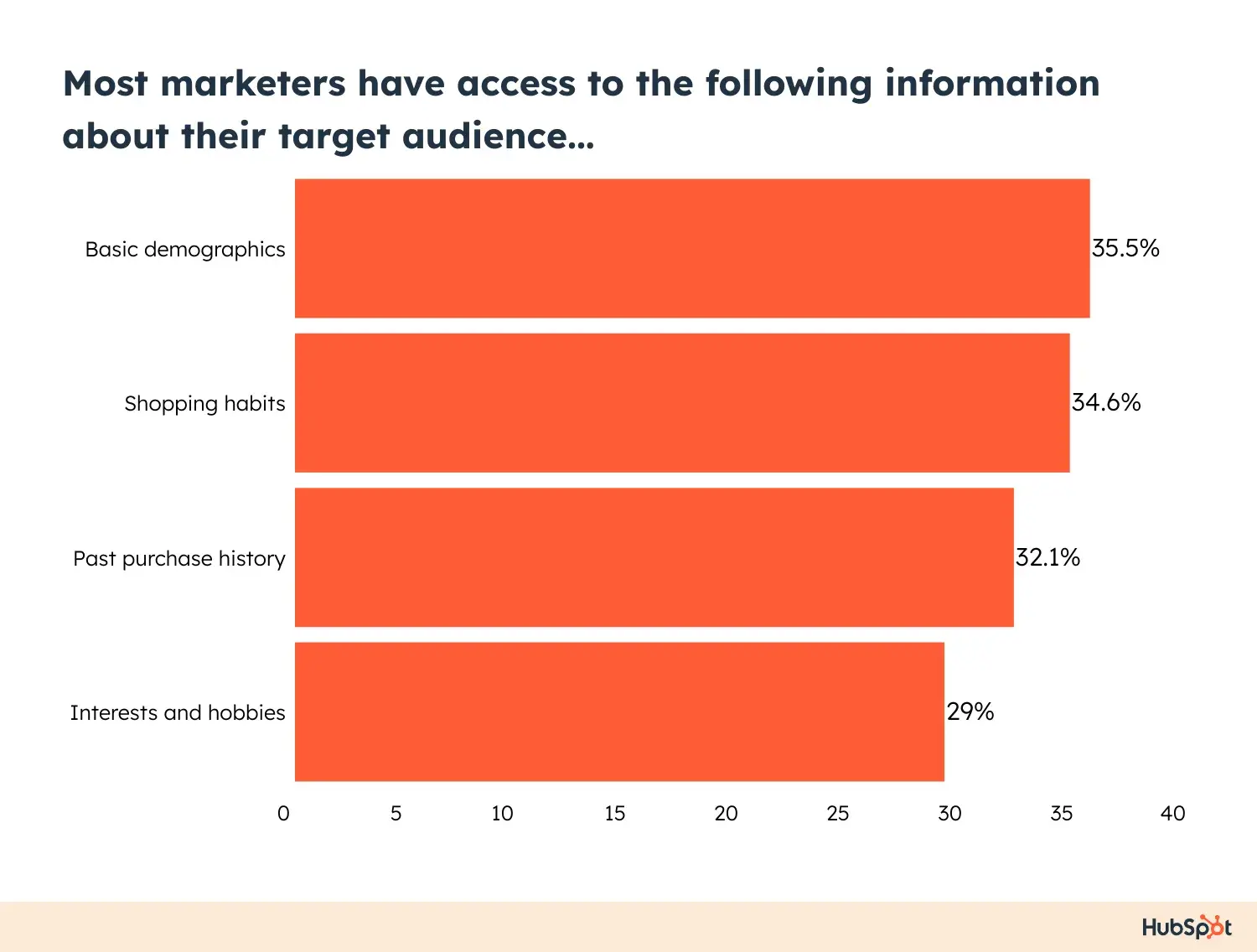
According to our 2025 survey, most marketers have access to the following information about their target audience:
- Basic demographics (35.46%).
- Shopping habits (34.57%).
- Past purchase history (32.08%).
- Interests and hobbies (29.04%).
Only 19.71% of marketers have access to audience pain points, so this is your opportunity to shine for the best possible ad targeting.
Better yet, by speaking directly to their mindset, you can ensure your ads feel less salesy and more like a solution. That’s what makes people stop scrolling.
2. Map your average customer journey.
Facebook ads are part of a bigger conversation that starts with what’s happening in their mind and continues based on what your customers’ next move is likely to be — both in their lives and within the context of your business.
That means understanding the steps they take as they:
- Recognize they have a problem.
- Identify what that problem is.
- Discover potential solutions.
- Become aware of me as an option.
- Choose to purchase my product.
While I often find this journey to be slightly different for each customer, most buyers generally fall into three categories, each of which needs slightly different messaging, offers, and CTAs.
- Awareness Phase (top of the funnel). Focus your ad content on the problem your audience is facing.
- Consideration Phase (middle of the funnel). Try out ads that show your solution in action.
- Decision Phase (bottom of the funnel). Offer urgency like limited-time offers, bonuses, or even something showing the benefit of getting your solution in place now.
By tailoring your ads to each stage of your customer journey, you meet your audience where they are, which makes it easier for them to say yes.
As Morton explains, “Don’t rely on a single ad to carry the success of your Facebook campaign. It should be part of a larger strategy that guides your prospects from awareness to consideration to conversion.”
Want to see this in action?
Let’s say I want to run ads for a fitness tracker. In the awareness phase, I’ll create a short, engaging video of the everyday challenges of maintaining fitness, like busy work schedules and lack of motivation.
For the consideration phase, I can create carousel ads showcasing the tracker’s features and benefits. These may include heart rate monitoring, step tracking, and sleep analysis. I can also include customer testimonials and quick illustrations of how the product integrates seamlessly into daily life.
In the decision phase, I’ll run a series of ads offering a limited-time discount on the fitness tracker and highlight the ease of purchase. I will also include a clear CTA to drive urgency and encourage immediate action.
After nailing down the customer journey, I begin segmenting my audience.
3. Segment your audience.
Grouping customers based on where they are in the customer journey helps me target people with the right offers at the appropriate time.
Here are a few examples of my potential audience segments:
- New customers. They enter my funnel as warm leads because they’re interested in my product.
- Lukewarm leads. Those who visited my website but didn’t engage. I can use retargeting ads to remind them that I have the solution to their problems.
- Engaged blog readers. Those who like my content and keep coming back for more. They’re more likely to share my posts on Facebook or make a purchase.
- Landing page visitors. They typically come to a specific landing page and are probably interested in a particular product.
- Shopping cart abandoners. They were close to buying an item, but something stopped them. So, I may need to gently push them to finish their purchase.
- Return customers. They love my brand. They’ve already purchased from me in the past and come back for more. They’re brand advocates who praise and recommend my product to their friends.
Jeremy Bogdanowicz, founder and CEO of JTB Studios, segments his audience based on their interests, which he says is always effective on Facebook because “The algorithm allows Facebook users to find content according to their interests. If they like a post or page, they will see similar posts or pages on their Facebook timelines. Thus, I find people whose interests align with our brand’s services. Afterward, I leave the rest to Facebook.”
I agree with Jeremy. Audience targeting based on their interests is a smart strategy. It ensures my ads reach people who are more likely to engage with my content, increasing their chances of opening the ads.
4. Install your Meta pixel.
Meta Pixel (formerly Facebook Pixel) is a piece of code you embed into your website to track visitors’ actions. It’s a must — no exceptions.
Pixel data delivers insights that allow you to:
- See which ads are driving results beyond clicks (whether or not your audience converts).
- Retarget people who didn’t convert.
- Optimize your campaigns.
- Create lookalike audiences and expand your reach.
I recommend checking out Meta’s step-by-step instructions to help you install Meta Pixel on your website.
Pro tip: Download our free Facebook Advertising Checklist. It will guide you through every step of setting up and optimizing your Facebook ads.
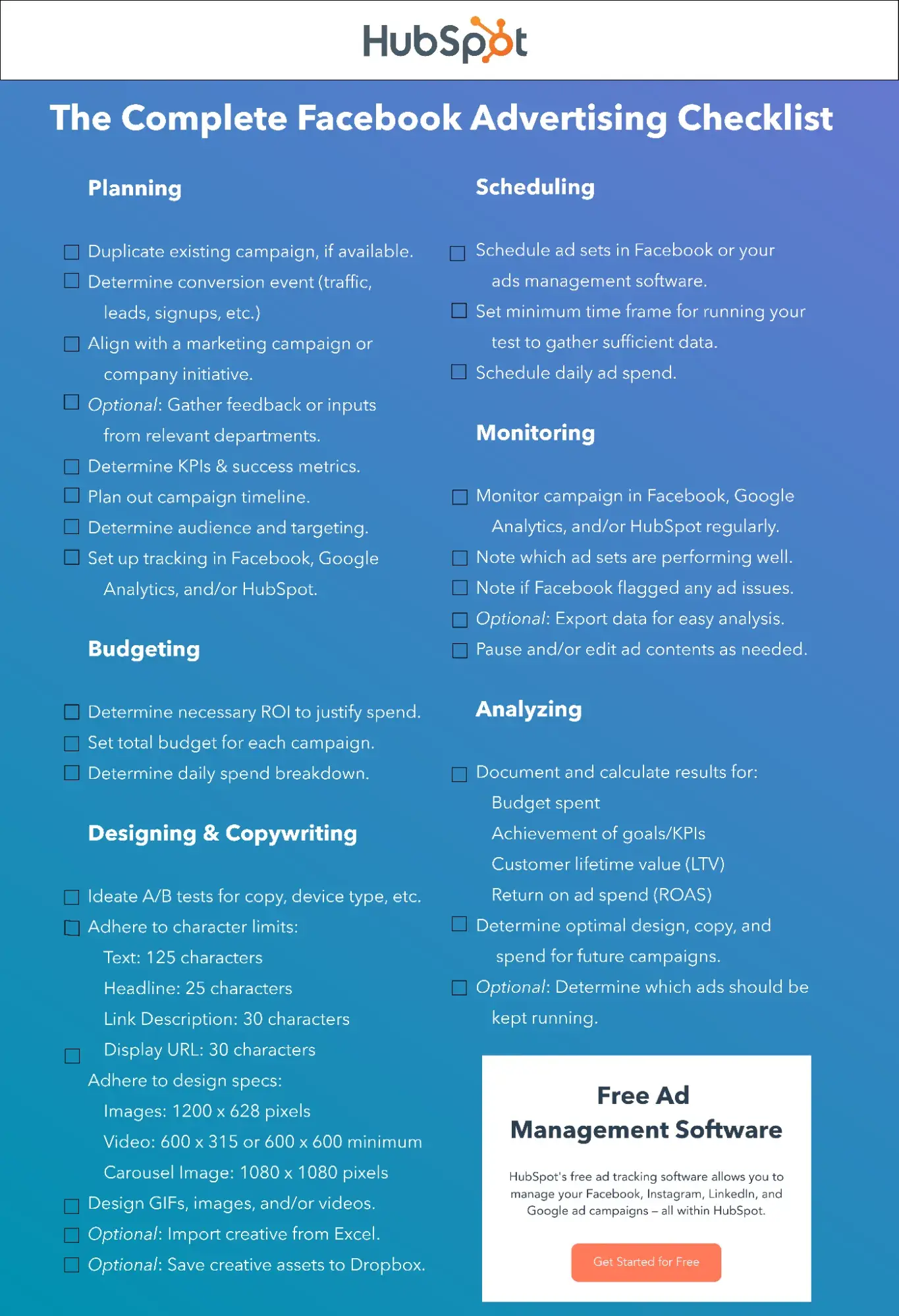
11 Facebook Ads Strategy Tips
Once you know your audience, map the journey, segment your list, and install your Pixel, it’s time to put that knowledge into action.
Now that we’ve gone over the basics, I’ll share some of my top tips for creating effective Facebook ad campaigns that can help you maximize your return on investment (ROI).
1. Combine Facebook ads with content marketing.
Running Facebook ads doesn’t mean you should stop creating helpful, relevant content — in fact, the two work better together.
One mistake I go out of my way to avoid is targeting my warm leads with ads designed to turn them into paying customers. Since warm leads aren’t ready to buy from me yet, instead of turning them off with straight sales offers, I offer them helpful content that answers their questions and solves their pain points.
Kurt Uhlir, chief marketing officer at EZ Home Search, follows the same pattern with a two-fold strategy: “First, we provide information that addresses both the emotional and logical queries pertinent to their [audience] customer journey. Secondly, we share success stories where our clients are the superheroes, not just beneficiaries, of their success.”
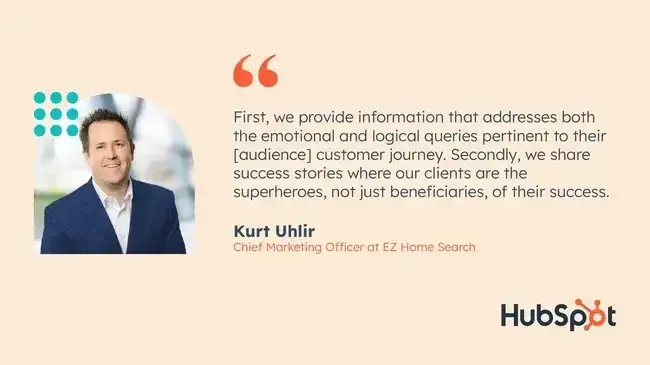
This approach positions his company as a valuable resource and showcases the tangible impact of their solutions through relatable narratives.
Here’s how I typically see Facebook ads work alongside content marketing:
- Create a valuable blog post, guide, or video tailored to a specific stage in the journey.
- Share it organically on Facebook.
- Boost it to reach more of your ideal audience.
- Retarget engaged viewers later with a more focused offer.
2. Collaborate with influencers who align with your brand values.
One thing I’ve realized in my experience with Facebook ads is that influencers can add a layer of authenticity you can’t get from traditional ads.
In fact, 63% of consumers are more likely to buy if an influencer they trust shares your product.
Here’s where it gets even more interesting. According to our 2025 survey of marketers:
- Only 14% report using influencers in their overall marketing strategy.
- 88% plan to invest the same or more with influencers in 2025.
- 24% see influencers as one of the biggest changes to the marketing industry.
- And 10% are trying out influencer marketing for the first time.
Momentum is clearly building here, which means influencer marketing could be a huge opportunity for you. Especially when you consider that today’s consumers want authentic content.
However, that doesn’t mean just any influencer can have this effect on your business. In fact, 28% of marketers are focusing more energy on creating content that reflects their brand values, and this likely extends to their channel partners.
With that in mind, I recommend choosing influencers who align with your brand values to ensure the partnership feels natural.
3. Use lead ads to build up your marketing list.
Having a huge Facebook following is awesome. However, you and I know that Meta “owns” our contacts. If they decide to change their algorithm or shut down, we’d lose access to those people. Not to mention what happens if people decide to leave Facebook.
To protect yourself here, I always recommend building your own marketing list. When I do this, I create a lead magnet, such as a free ebook or course, and run a lead ad. This way, my followers can give me their email addresses directly on Facebook.
That said, I’m generally cautious with this approach. I never add any steps that may cause friction for users trying to access my gift. Otherwise, I may end up losing them.
Once I have their email, I add it to my marketing list and include them in my email marketing campaigns.
A few tips here to make this effective and seamless:
- Keep the form short.
- Remove unnecessary steps.
- Follow up right away via email.
- Make sure the handoff between ad and experience feels consistent.
4. Incorporate video ads.
Videos are a powerful tool for boosting conversions and sales. Our 2024 Marketing Statistics show that 96% of people watch explainer videos to learn more about a product. Even better, 89% say these videos have convinced them to purchase.
Marketers concur. Our 2025 survey shows that product demonstrations and tutorials perform better on social media than any other type of content.
These stats clearly prove my point. That’s a huge opportunity.
Morton agrees. “We’re anticipating a greater emphasis on video and interactive content. Features like Stories, Reels, and interactive ads will become more impactful.”
And, in my experience, clients who lean into short, engaging videos see higher engagement and lower cost-per-click. Here’s what I’ve noticed tends to work best — for clients and content I’m likely to engage with:
- Keep it under 30 seconds.
- Get your hook in early — the first three seconds are best.
- Use captions so you connect with people whose sound is off.
- Focus on one simple idea per video.
And since 28% of marketers we surveyed in 2025 are already using short-form video, why not start using the videos you’ve already developed in your ads?
Or, if you’re like the 17% using long-form video, consider repurposing longer content into short clips for Facebook.
Lastly, your video doesn’t need to be super polished. In fact, behind-the-scenes-style content often performs better because it feels more authentic. Whatever you do, aim to tell a story.
Wilson shared that this approach is working really well for her clients. “When we shifted a concrete coating company’s strategy from sharing before and afters to focus on storytelling, we saw a measurable increase in both the quantity and quality of leads. People connected emotionally with the story, saw the possibilities for themselves, and were more motivated to reach out. It’s about connection, not just promotion.”
5. Create Facebook and Google ads.
While many marketers see Facebook and Google as picking one or the other, I see them as platforms that can complement each other quite nicely.
As I said earlier, my strategy always depends on my campaign objectives and the audience segment I’d like to target. So, I often choose different ad types that align with my customers’ current stage in the buyer’s journey.
For example, if I’m promoting my new fitness tracker to warm leads, Facebook ads might be the better option. I can target them with helpful content to create brand awareness, as they may not yet be ready to buy my product.
Conversely, Google ads would be more effective if I’m marketing a new computer to a returning customer. Such a person is often ready to purchase and research their options. By using the right keywords and creating targeted Google ads, I can reach them at the exact moment they’re considering buying, making it more likely they’ll choose my product.
6. Use giveaways and contests.
Something I’ve noticed when creating my social media campaigns is that Facebook contests don’t always need to focus on sales. Instead, I offer high-value prizes to increase brand awareness, which will pay off in the long run by bringing new leads into my conversion funnel.
Kelly Sullivan, the owner of Kokomo Botanical Resort, shares the impressive results he got when he offered customers a chance to win an all-expenses-paid trip to Hawaii for sharing a Facebook ad about their travel company.
According to Sullivan, “The contest spread like wildfire, increasing our Facebook page likes by over 50% and reducing our CPC (cost-per-click) by 40% within a month.”
Besides high-value prizes, I also find that partnering with brands that have similar audience personas to mine can be effective.
Amelia Munday, social media marketing specialist at Custom Neon, agrees and notes that “By partnering with other brands and posting in a ‘collaboration style’ post with other accounts, the giveaway is mutually beneficial to both brands because it allows you to garner exposure to each other’s audience and therefore increase your following and impressions!”
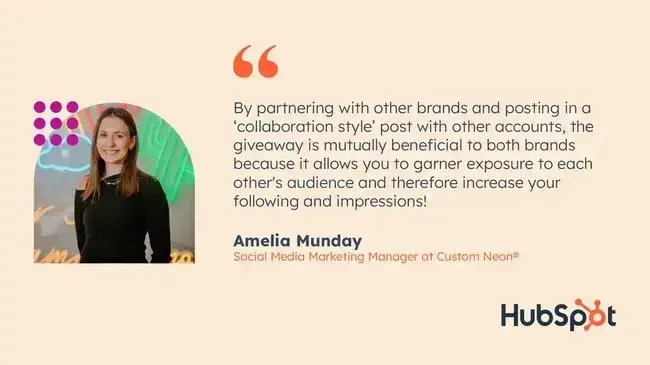
Note: Before creating any contests or giveaways on Facebook, review Meta’s policies to make sure you aren’t violating any of their rules.
7. Use Facebook mobile ads.
When I think about Facebook ads, one of the first things that comes to mind is the immense potential of mobile ads. Most people on social media prefer using their smartphones to desktops.
Our statistics show that 62% of Millennials and 80% of Gen Z primarily use their phones to search for what they want.
That means your ads, landing pages, and checkout flows need to load quickly, look great on a small screen, and be thumb-friendly from top to bottom.
Here’s what I recommend:
- Use vertical or square video and images — they take up more screen real estate.
- Keep headlines and copy tight and scannable.
- Test your landing pages on mobile before you run any traffic.
An otherwise “perfect” ad can flop if the mobile experience on the other side is clunky or slow. When every second counts, you’ve got to make sure everything is working right.
8. Use AI strategically to create your Facebook ads.
AI is here to stay, so this is your chance to use it to your advantage for your Facebook ad strategy.
Our Social Media Trends report shows that 48% of social media marketers use AI tools to generate text for their copy, while another 41% use AI assistants like Microsoft Copilot to automate repetitive tasks and improve productivity.
Chris Stones, strategic and operations director at Mitchell & Stones, says AI helps him serve ads in multiple languages and gives him a more accurate translation than Google Translate.
As a content curator, AI helps me save at least three hours on every piece of ad copy I create. Personally, I use HubSpot’s AI-powered content tools to:
- Turn a single blog post into multiple content formats.
- Write engaging copy for my social media posts.
- Create consistent on-brand content.
That said, AI is still far from perfect. Use it to complement your creative efforts rather than relying on it entirely.
9. Keep optimizing your ads.
Morton offers a word of caution. “Facebook ads are rarely a ‘set-and-forget’ tactic. They require ongoing monitoring, budget adjustments, fresh creative, and audience updates.”
To keep your campaigns effective, you need to keep testing, learning, and refining.
“Everything is testable,” says Murray.
Our 2025 survey of marketers shows that this is one of the biggest ways the marketing industry is changing —18% agree that actively testing new marketing channels and formats became more important over the last year.
That means it’s important to play around with new ideas and pay attention to content trends. In doing so, you’re not just reacting when something underperforms; you’re proactively looking for ways to stay ahead.
Wilson sees this in action, too. Instead of turning on an ad and hoping for the best, she advises clients to “Test different versions and scale up what performs best.”
10. Build a system that works.
Your system isn’t limited to building out an ecosystem that moves your audience smoothly through the customer journey, although this is extremely important.
Wilson explains, “Follow up with leads quickly. The businesses that respond within minutes are the ones that close the most deals.”
When I asked Murray something he wished every business knew about creating a Facebook ads strategy, he was quick to respond. “I wish more people understood just how much effort goes into making Facebook ads work. The real question shouldn’t be ‘Do we have the budget to spend on Facebook?’ — it should be ‘Do we have the capacity to create, iterate, and test consistently?’ Winning on Facebook isn’t about a single perfect ad. It’s about building a system that helps you find that ad through experimentation.”
With that in mind, you also need processes that help you:
- Test creative regularly.
- Track and compare results.
- Adjust targeting based on behavior.
- Iterate without starting from scratch every time.
11. Obsess over your creative.
At the end of the day, targeting only gets you so far. It’s your creative — the message, the hook, the visual, the vibe — that grabs attention and moves people to act.
“As ad platforms mature — just like TV and radio before them — the only lever that continues to matter is the creative itself,” Murray says. “Your job is to make something that’s worth watching, and ideally, worth sharing.”
That’s why creative fatigue is real. Even great ads lose steam over time. You need a steady stream of fresh, scroll-stopping content that aligns with your audience’s mindset and the moment they’re in.
Morton echoes this as well. “We start with a data-driven approach. Experiment with different ad creatives, messaging, and audience segments to dial in your campaign. Then use that data to iterate and refine your strategy.”
If you’re not putting as much energy into your ad creative as your budget, you’re missing the lever that matters most.
Create Effective Facebook Ads Today
If you take one thing away from this article, I hope it’s that Facebook ads can still work incredibly well as long as you don’t expect them to work on autopilot or in a vacuum.
My experience creating Facebook ad strategies has taught me that nothing will work if I don’t know who my message is meant for.
With that in mind, you need a Facebook ads strategy that factors in how you meet your audience’s needs and your systems for creating, testing, and refining those ads, as well as following up with them.
If you’re ready to dive in, be sure to consider the questions and strategies I’ve shared here to drive higher engagement and boost your conversion rates.
Editor’s note: This post was originally published in January 2022 and has been updated for comprehensiveness.
![]()
28 free advertising tips for your small, large, or local business
When I first started my small business, advertising seemed daunting. With a limited budget, I couldn’t fathom spending thousands on TV commercials or ad campaigns. But over the years, I‘ve discovered that free advertising can be just as effective as paid. In fact, some of […]
MarketingWhen I first started my small business, advertising seemed daunting. With a limited budget, I couldn’t fathom spending thousands on TV commercials or ad campaigns.
But over the years, I‘ve discovered that free advertising can be just as effective as paid. In fact, some of the most impactful strategies I’ve used were completely free.
It can be frustrating when your budget dictates how many potential customers you can reach. But with the right approach, you can create an effective free advertising plan.
Table of Contents
- How to Advertise Your Business for Free
- Free Local Business Advertising Ideas
- How to Advertise on Google for Free
1. Write guest posts for other blogs.
Guest-writing for a well-established blog is one of my favorite free advertising methods. It can connect you to that blog’s audience and establish you as an industry thought leader.
You’ll get access to an established audience and high domain authority, which can sometimes be more beneficial than posting to your own blog.
Plus, you can link back to your website from your article, giving you an inbound link that boosts your domain authority and can increase your own website’s ranking in search engines.
I’ve found that guest posting not only drives traffic to my site but also helps build valuable relationships within my industry. One guest post I wrote led to a partnership that doubled my client base in just six months.
Pro tip: Before you reach out, think about the perspective or data that differentiates you from the crowd. When you pitch other blogs, position your expertise as something their audiences can’t get anywhere else.
2. Answer Quora questions.
Writing content for Quora can expose your business to a large audience: in 2024, Quora reported a worldwide audience of 400 million monthly visitors.
Besides the large built-in audience, your business can answer direct questions from prospective customers. This lets you interact with high-quality potential leads and establish yourself as an expert in the subjects that matter most in your industry.
Here’s an example:
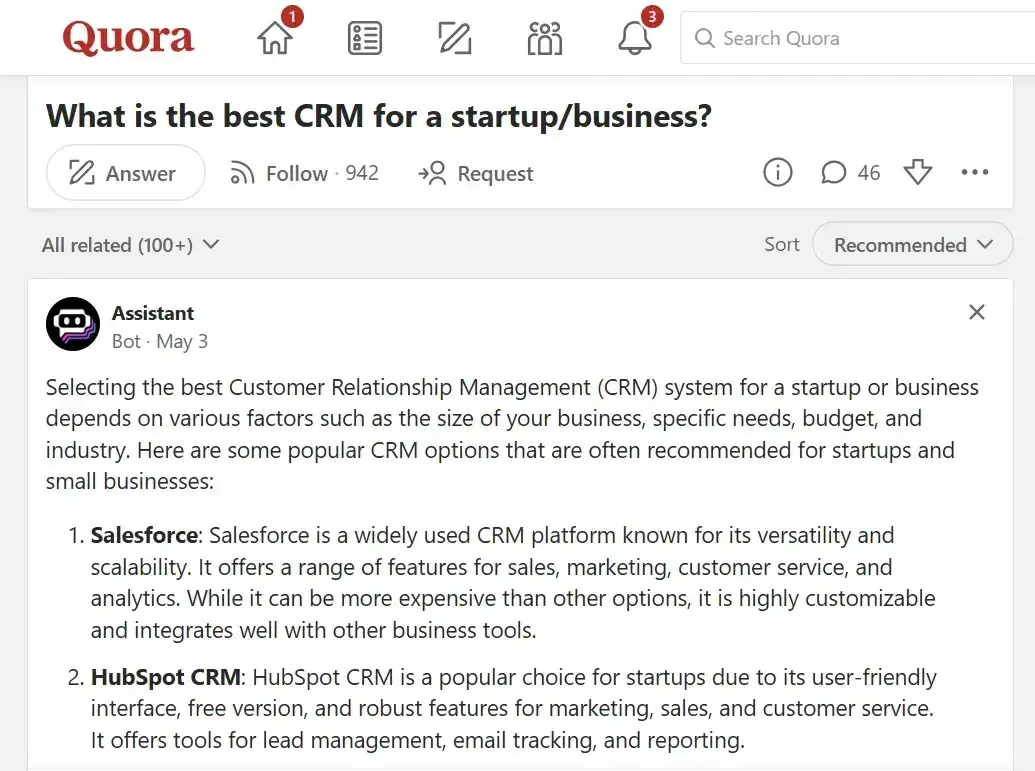
3. Stay active in industry-specific discussions and forums.
Want to get free advertising and position yourself as an expert in the field? If so, industry-specific forums and threads could be for you.
Many industry organizations will have online forums or blogs that allow you to answer questions or offer advice.
One example is real estate investing organization Bigger Pockets, which has its own forum where industry professionals and newbies can share ideas.
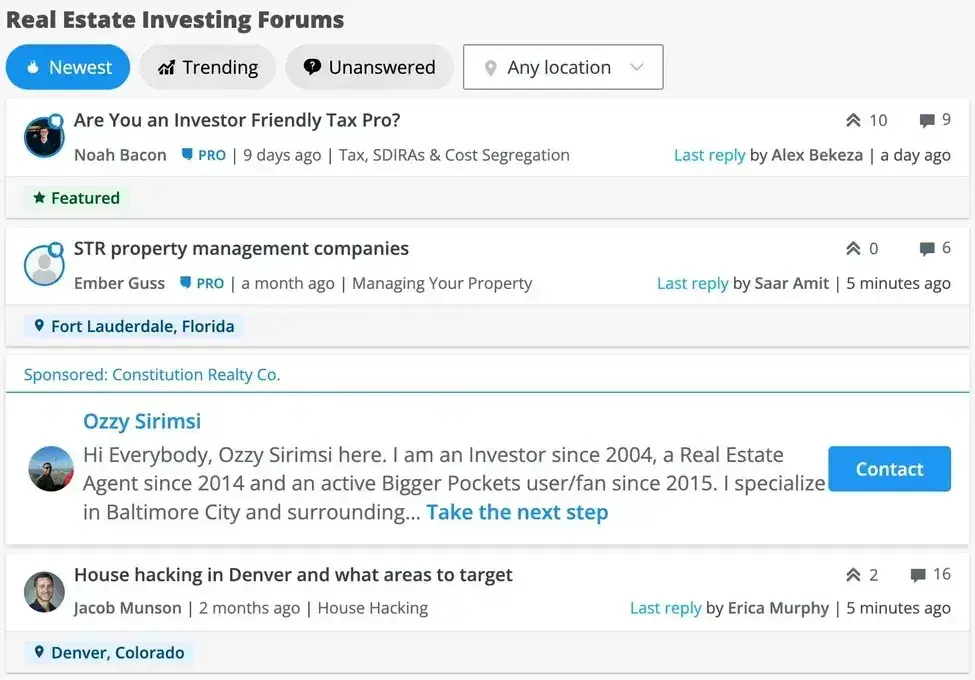
If you‘re not sure where to start, try browsing topics on Reddit to see if there’s an existing discussion or topic related to your area of expertise. Just be sure to offer genuine, valuable feedback so you don’t come off as too salesy.
4. Publish content on LinkedIn.
According to Statista, 44% of B2B marketers said that LinkedIn was the most important social platform. The next most important one was Facebook, lagging behind at 33%.
In other words, if you’re a B2B marketer, don’t sleep on LinkedIn!
LinkedIn’s blogging platform lets you demonstrate your expertise within your industry. Every time connections and other LinkedIn members engage with and share your posts, you’re getting free promotion.
You can even use LinkedIn’s native newsletter tool, like Andrew McCaskill has done. He publishes the monthly LinkedIn newsletter “The Black Guy in Marketing” and has over 15k subscribers:
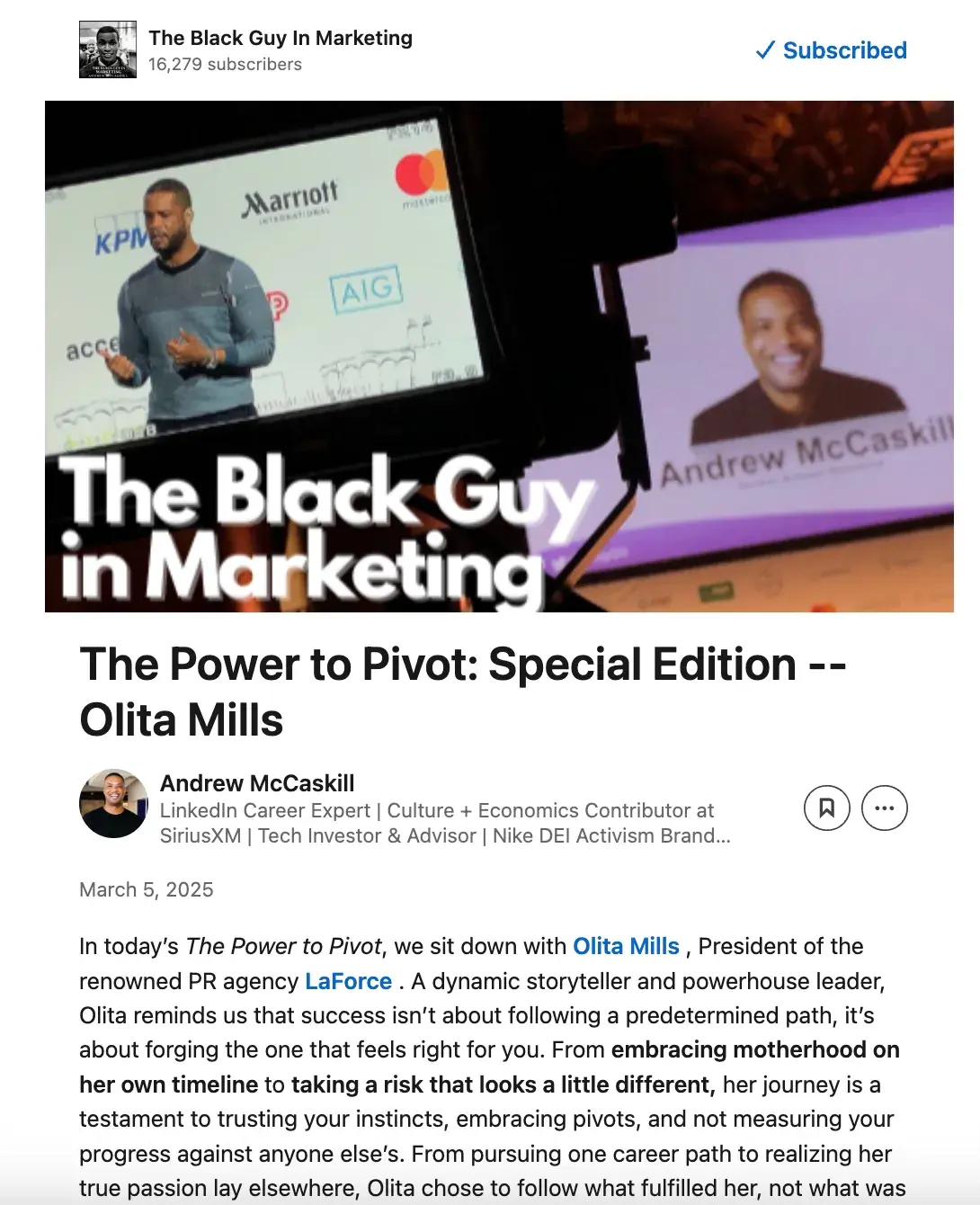
5. Offer to do interviews on business podcasts.
To figure out which platforms your team should prioritize, it’s important to diversify your promotion platforms to discover where your audience is already consuming content.
Some of your audience might prefer listening to podcasts over reading articles. To reach those people, contact a few businesses with podcasts and pitch interview ideas.
6. Promote your website in your email signature.
With all the emails you send every day, it’s a shame if you aren’t taking advantage of the promotional potential of your email signature. Here’s one I made for a fictional pet-sitting business using our free email signature generator:

Your email signature can also be an unexpected property to promote a sale, contest, event, or even a new blog post.
You should also add a link to your business’ website on your Facebook, X, and Instagram profiles.
7. Send email newsletters.
An email newsletter can be a useful vehicle for promoting content, sharing business-related news, and building deeper relationships with potential and existing customers. There are plenty of free tools out there — like our very own free newsletter builder — that assist you in designing, sending, and optimizing your newsletter.
With the right time investment, an email newsletter can be the perfect place to share quality content with leads and potential consumers, establishing your brand as helpful and informative.
If you’re new to newsletters, give our data-backed guide to newsletter strategy a read.
8. Create YouTube videos.
According to a Wyzowl study, 87% of people have been persuaded to buy a product or service after watching a video. And 83% want to see more videos from brands in 2025. So what are you waiting for?
Creating engaging, informative, and shareable YouTube videos is one of the most efficient ways to sell your brand. If done right, your YouTube videos will entertain viewers enough to share your content and seek out your website.
Pro tip: Optimize your YouTube video titles, descriptions, and tags with relevant keywords to improve discoverability in both YouTube and Google searches.
9. Encourage happy customers to give online reviews.
Word-of-mouth is still one of the best ways to market your product. Consumers trust the opinions of other consumers, especially when there are many great testimonials.
If you have happy customers, encourage them to write a review about their experience on popular review platforms like Google, Facebook, and Yelp.
Kate Harding, who owns Jarvis Square Books in Chicago, suggests a frictionless approach: She keeps a QR code by the register that sends customers straight to her Google reviews page, where she’s racking up the five-star reviews. If you don’t have a brick-and-mortar store, you can still place a QR code or link near the end of your buyers’ journey to take advantage of happy customers.
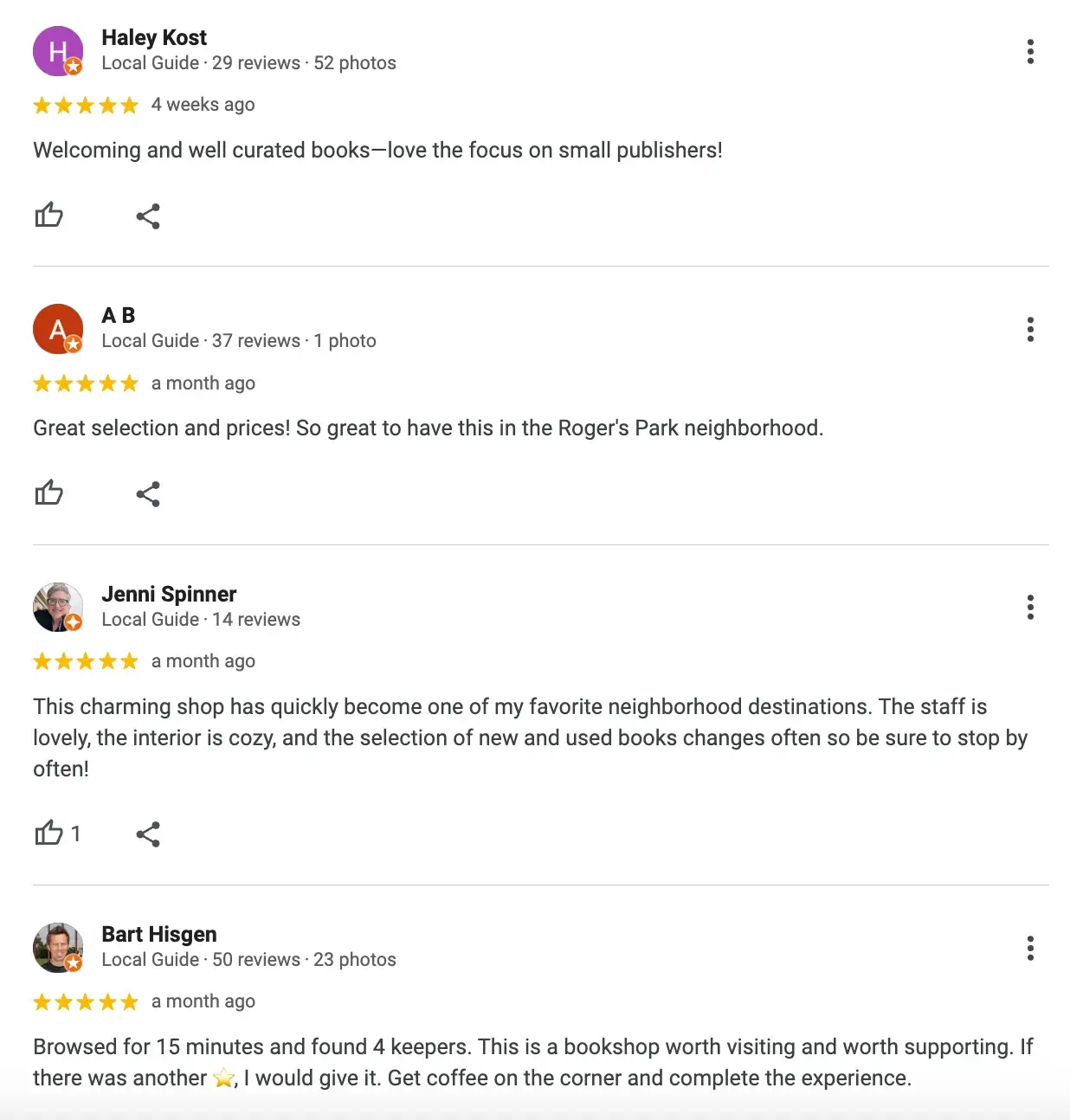
If you want great reviews on Facebook, be sure to create a Facebook Business page.
10. Leverage existing customers for referrals.
As mentioned above, word-of-mouth is a powerful marketing tool. Tap into the value of your existing customers by asking them for referrals.
As an incentive, you can offer a discount or other reward to encourage them to get the word out.
11. Take advantage of your partnerships.
Partnerships are an opportunity to offer supplementary services that you don’t provide.
For example, a web design company and a copywriting agency might partner, so when a client requires written content for her web pages, the web design company can offer copywriting services from its partner.
This increases consumer satisfaction and provides exceptional advertising opportunities. When your partner’s consumers need your services, your partner will point them in your direction.
12. Post on social media.
Nowadays, social media is crucial to most marketing strategies. Luckily, most types of social media platforms and posts are free — even to businesses.
Pick the platforms that best suit your audience. Then, post links, photos, videos, or text posts about your company, product launches, or any other occurrence that you’d like to promote.
Facebook, X, and LinkedIn are suitable places to start for most businesses.
They all offer a way to share video, text, photos, and link-based posts and have large user bases. To learn more about other forms of social media, check out this post.
Pro tip: Use a social media management tool to schedule posts in advance. This allows you to maintain a consistent presence without spending hours each day on social platforms.
13. Engage with followers on social platforms.
It‘s not enough to post. For your social media efforts to be successful, you’ll want two-way communication.
When customers comment on your posts, respond to and Like their comments. Not only does it keep the banter and engagement up on your content, but it also humanizes your brand.
14. Leverage user-generated content.
Since we’re talking about engaging with followers, using user-generated content (UGC) for your advertising can get the word out even on a tight budget.
Encourage your customers to create and share content related to your brand. This can be in the form of testimonials, reviews, or even user-created videos. It helps build social proof and can reach a wider audience.
Pro tip: Create a branded hashtag for your business and encourage customers to use it when sharing content related to your products or services. Using a branded hashtag makes it easier to find and share user-generated content.
15. Create highly shareable content.
Additionally, you’ll want to create enticing content that your audience will be motivated to share. Start by building a strong online presence.
Optimize your website and social media profiles to ensure they are user-friendly, visually appealing, and provide relevant information. Update your platforms with fresh content regularly and continue to engage with your audience through comments and messages.
If you don’t know where to start, check out HubSpot’s free Campaign Assistant, which can help you build every aspect of a great marketing campaign.
16. Make sure you’re listed in online directories.
Google My Business isn’t the only game in town. List your business in the local Yellow Pages, Yelp, TripAdvisor, Angi, local professional organizations, or another relevant directory.
This increases your chances of being discovered by potential customers who search for businesses like yours.
If your industry has a directory, you should be on it. Your local chamber of commerce is also a great place to start.
17. Offer valuable content like an ebook or tool.
One of the simplest ways to attract new customers and retain new ones is to provide value. This could be in the form of solving a common issue in your field or making a mundane or difficult task easier by providing a tool.
In the real estate industry, housing search sites often provide free mortgage calculators. Similarly, Smart Asset offers an array of handy tax and paycheck calculators that help visitors figure out roughly how much their income would change moving from one state to another.
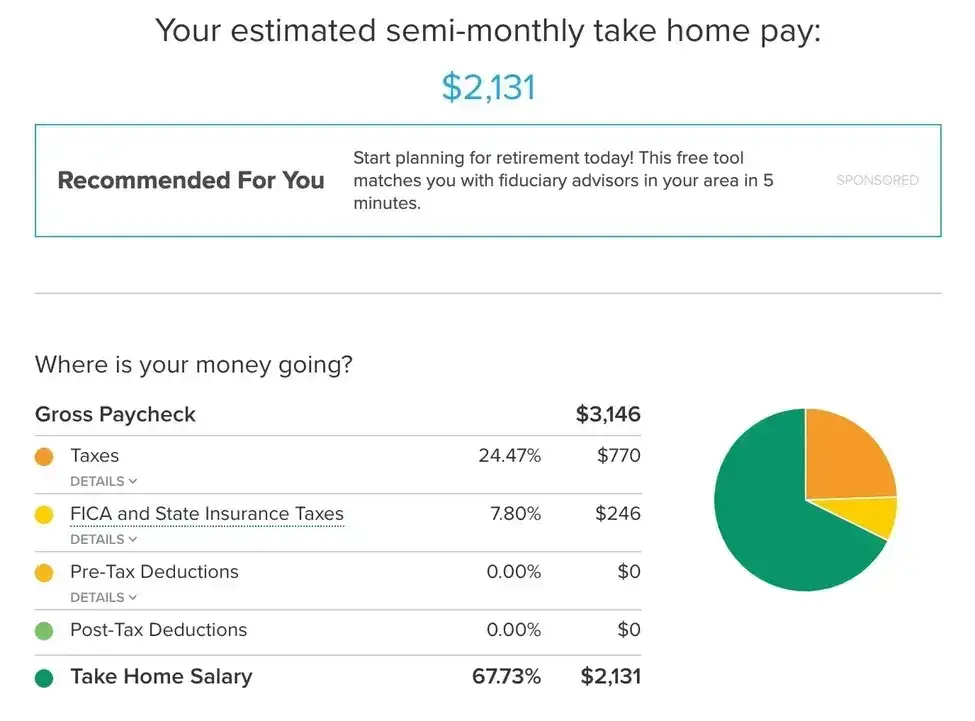
If there are common obstacles or pain points in your industry that can be remedied by offering a tool, ebook, or helpful video content, offer those resources on your site. It will help establish your brand as a trusted industry export.
18. Don’t forget about SEO.
One of the key factors in free advertising is to make sure potential customers can actually find your business.
You can have the greatest products or services, but your growth will be stunted if you don’t show up in search engines.
Along with Google My Business, taking advantage of free SEO strategies can also help your website rise higher in search results. These tactics can be simple and easy to work into blogging, web design, or other processes.
19. Offer a free trial or consultation.
One obstacle that can prevent potential customers from making a purchase is trust. Offering a free trial of your product or service or a free consultation can help break the ice and eliminate that barrier.
It‘s also a good way to get the word out. If a visitor uses your product with a free trial and enjoys the experience, they’re likely to tell others. As we’ve mentioned previously, word of mouth is a powerful advertising method.
20. Experiment with photo and video platforms.
While Facebook, X, and LinkedIn could be great platforms to start on, expanding to platforms like Instagram or Pinterest will give you more opportunities to show product shots or embrace the heavily visual strategy of influencer marketing.
Aside from spreading awareness with free images of your product or service, most social platforms, including Facebook, offer live video and story features that allow you to create video promotions related to your products.
For example, you might use Instagram Stories or TikTok as an outlet to publish tutorials on how to use your products.
Because these videos and photos are on social, you can boost their shareability by hashtagging them, creating interesting captions, and encouraging fans to react with Likes or comments.
21. Write useful press releases.
A press release is not advertising just by itself. To garner interest from media outlets and journalists, what you’re announcing needs to be newsworthy.
Making a press release that sounds too promotional can get it rejected by media outlets. Like your customers, you‘ll need to offer media outlets something of value. Did you run a survey or study that yielded some interesting insights that would be of interest to your industry?
That’s what you should include in a press release, and it increases the odds of the information being picked up by outlets. This could be about emerging industry trends or interesting statistics you found.
Once you have newsworthy information to share, submit your press release to industry publications, media outlets, and online press release distribution sites.
This will help build a buzz around your brand.
1. Use Google My Business to optimize for local search.
One of the most powerful free local business advertising methods is Google My Business, which enables companies to manage their presence on Google Search and Google Maps. The tool can bolster your rankings in local search results.
Plus, if you rank high in local search, more consumers will choose your business over a competitor’s. In today’s fast-paced world, convenience is key.
Google is the most popular site used to evaluate local businesses, according to consumers who participated in a 2023 Statista survey — 87% of respondents used Google, compared to just 48% who preferred Yelp.
Pro tip: Regularly update your Google My Business profile with fresh content, such as new photos or posts about special offers. This activity signals to Google that your business is active and relevant, potentially boosting your local search rankings.
To truly leverage the power of local search and track your performance, consider using a robust marketing analytics tool like HubSpot’s Marketing Analytics.
It can help you measure the impact of your Google My Business efforts and other local SEO strategies on your overall marketing performance.
2. Attend networking events and mixers.
Connecting with fellow professionals at industry networking events is a great opportunity to meet potential consumers in a place where they are eager to discuss your business.
The niche topics of networking events ensure you’re meeting high-qualified leads.
For example, an event for best tech startups will primarily attract participants who are interested in — you guessed it — technology and startups.
Particularly for small businesses looking to make their first connections, networking is a chance to get your name out there, meet potential partners, and find growth opportunities. Plus, it’ll keep you up-to-date on trends in your industry.
3. Speak at an association or industry event.
Speaking at an event about a topic related to your industry is another way to exhibit your expertise.
Giving a thought-provoking and powerful speech will draw attention to you and, by association, your business, which can increase brand awareness and prove your business is qualified to tackle consumer challenges.
To start, brainstorm different topics and volunteer at various upcoming networking events and trade association conventions.
If you’re afraid of public speaking (don’t worry, many of us are), you could enroll in a local Toastmasters chapter to improve your game.
4. Offer locals-only promotions.
One way to build loyalty and camaraderie among your audience is to offer a discount to locals only. Exclusive offers create the impression that your audience is getting something tailor-made for them.
For example, my local coffee shop offers a small discount for customers who live in the neighborhood. It doesn’t have to be much, just a token of your appreciation for their continued support of your business.
This kind gesture will encourage them to return and bring you even more business.
5. Be active in your community.
Similar to the networking suggestion, stay on top of local events in your area, even non-industry-related ones.
From fundraisers and charity events to local sports and community meetings — it’s an opportunity to make real connections with those in your community and build rapport.
You never know where those connections will take you. Choose something that suits your interests to make it more fun. Being active in your community will make it easier for potential customers to put a face to your business.
6. Partner with complementary local businesses.
This strategy will require a bit of research and legwork, but familiarizing yourself with other local business owners and their specialties can be very valuable if you leverage your connections.
Let’s say you own a local yoga or fitness studio. You could partner with an athletic brand in your area — running a contest where completing a certain number of classes gets them free merch. In return, you could allow the brand space to sell its clothing in your studio.
Harding, the Chicago bookstore owner, joined forces with dozens of other local bookstore owners for the Chicagoland Bookstore Crawl, which promoted her own business and introduced her to peers across the city.
7. Put up brochures or flyers.
Putting up brochures or flyer templates in local libraries, coffee shops, and businesses is a unique way to market to offline locations where people spend a good deal of their time.
You can create free brochures and flyers on PowerPoint or Canva.
Depending on your industry, it might even help you reach an ideal clientele. If you’re a physical therapist, for example, perhaps you could hand out brochures to local gyms or nearby hospitals.
How to Advertise on Google for Free
As mentioned above, you can create a free page on Google My Business, which can help you rank higher or first in search results. Here’s how it works.
1. Create your Google My Business account.
First, you‘ll want to create a Gmail account for your business. Then, you’ll want to register for Google My Business with that account.
Google will first ask you to enter the name of your business. Then, you’ll be asked to select a “Delivery Area.” In this form, note the mileage and area where your target audience lives.
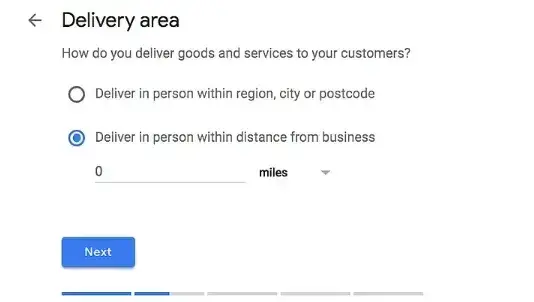
2. Optimize your business page.
After your setup process is complete, you can fill out your profile. As you do this, you ideally want to include all the requested info for the best search optimization.
A few key things you’ll want to include will be:
- Your address.
- A phone number, email address, and other contact information.
- Your website.
- Hours of operation.
- Photos of your business and products.
- A detailed description of what your business offers.
- Pricing or menu information.
- The year your company opened.
- Other business attributes, such as “free Wi-Fi.”
The above items are things locals might search specifically for.
For example, if someone searches for a “cheap Mexican restaurant open after 8 p.m.,” Google will examine the details in a business profile and prioritize your restaurant if it seems like a great match.
Here’s an example of what it looks like when a Google business fills out all its information:
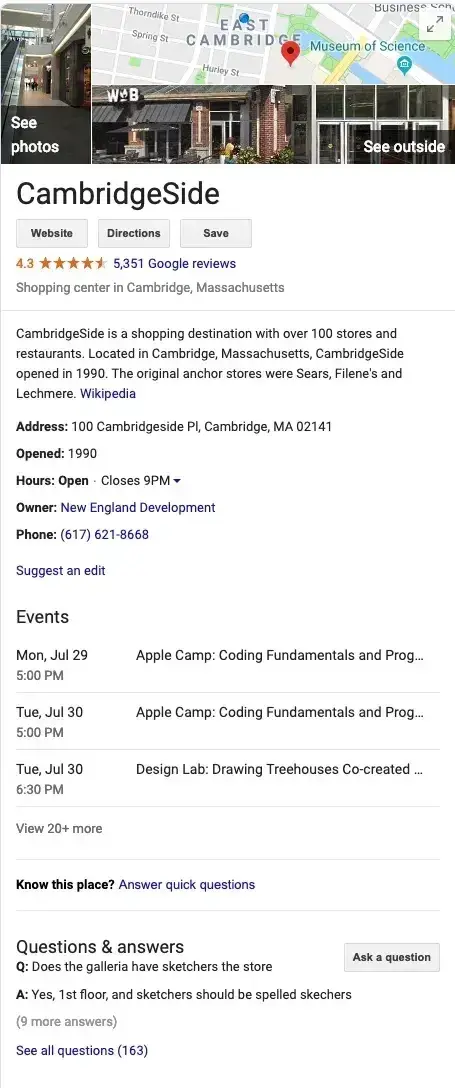
3. Verify and monitor your business page.
Once you‘ve created your Google My Business profile, verify your listing so Google knows it’s a real, legitimate business. There are a few ways to do this, including email, postcard, and phone verification.
You can also download the GMB app to monitor how your business is doing from your phone.
You Don’t Have to Blow Your Budget to Get Results
My favorite free advertising method? It’s a tie between content marketing through guest posting and leveraging Google My Business. Both have provided consistent returns in terms of increased visibility and customer acquisition.
What started as a necessity due to budget constraints has become a core part of my marketing strategy. I’ve found that combining these free methods with strategic paid advertising yields the best results.
Effective advertising is about creativity and persistence more than it is about budget. With the right approach, even a small business can make a big impact.
Editor’s note: This post was originally published in March 2018 and has been updated for comprehensiveness.
![]()
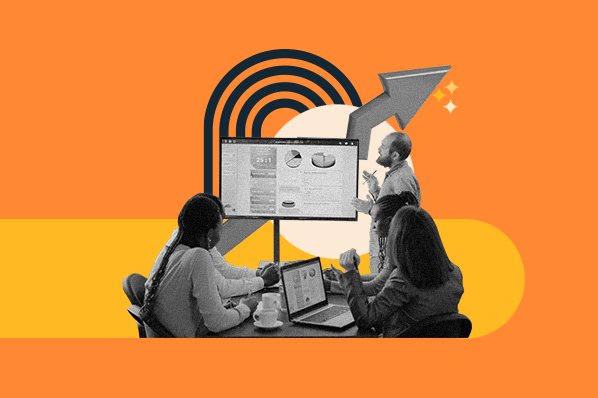
How Data in Sales Can Transform Your Sales Team and Performance
Most teams today are in touch with their sales data in some way, shape, or form. Some industries and companies are better at it than others. In tech, for example, where I spend a lot of my time as a marketing consultant, sales and marketing […]
SalesMost teams today are in touch with their sales data in some way, shape, or form. Some industries and companies are better at it than others.
In tech, for example, where I spend a lot of my time as a marketing consultant, sales and marketing are pretty tight. They share systems and strategies to the point where most of the time I’m sitting in the revenue team’s reporting calls with sales, marketing, and customer success analyzing metrics together.
I’ve seen sales data management done well, and I’ve also been in the position of having to whip it into shape. Now, organizations are in a position where responding quickly to market changes can make or break, and the ability to effectively use sales data for strategic decision-making is mission-critical.
I know this is easier said than done. How you gather, access, interpret, and use your sales data is highly dependent on your organization, industry, and the technology you have in place. But regardless of where you sit in that mix, let’s take a look at some solid strategies for making your sales data a performance enabler.
Table of Contents
- Types of Data a Sales Team Should Track
- Sales Data
- How to Analyze Sales Data
- Data-Driven Sales
- How to Develop a Data-Driven Sales Strategy
- Building a Data-Driven Sales Team
- Sales Data Helps You Grow Better
Sales Data
Data is an indispensable component of successful sales teams. Sales data can help representatives avoid pursuing bad-fit customers, and it can inform new opportunities that sales teams wouldn’t detect otherwise.
However, data on its own can be intimidating, especially for teams that are getting used to such an analytical culture. I’ve also seen sales teams that avoid their own data like the plague, afraid that if they look too closely, they might not like what they find.
That being said, sales teams don’t need to make use of every single metric. Some data just exists without providing insights, and that’s fine. Before I dive into the types of sales data your team should track, let’s start with how to approach sales data so it benefits your team and company goals.
How to Approach Sales Data
When I’m working with a sales and marketing team on performance tracking, I always start with business objective(s). This step isn’t about what data can do for you; it’s about the goals within your business. So, I recommend focusing on what you want for your sales team.
Example: We want to shorten our sales cycle in Q2.
Next, I make a note of what questions arise from the objective.
Example: How long is our current sales cycle? What’s causing it to be at this length? How long would we like it to be? How much money would this save us? What do we need to shorten the current sales cycle?
Finally, I identify which sales metrics are needed to answer these questions. (I’ll cover the types of sales data below.)
Now, the sales team should know which specific sales metrics to leverage as we work to meet the objective. Over time, as the objectives change, I may need to add or remove various data points based on need.
The following section will cover the types of data your team should know.
In this section, I cover the most common sales key performance indicators (KPIs). These are important for covering company-wide performance as well as tracking how your sales team is impacting your broader company goals. Let’s look at them in more detail in the following chart. I’ll talk about how to actually collect this data later.
For a list of over 50 sales metrics, as well as a breakdown of sales KPIs per team type, check out our Ultimate Guide to Sales Metrics.
|
Sales KPI |
What It Tells You |
|
Total Revenue |
How much revenue your sales team is generating |
|
Total Sales by Time Period |
How your sales team is performing (i.e., improving or worsening) over time |
|
Sales by Lead Source |
Where your sales are coming from and what lead generation sources are or are not working |
|
Revenue per Sale |
How much revenue is generated by each sale you make |
|
Revenue by Product |
How much revenue is generated by each product, product line, or service that you sell |
|
Market Penetration |
How much your product or service is being used by customers as compared to the total estimated market |
|
Sales per Prior Activity |
How many sales were made for each prior activity (e.g., phone calls, email outreach, in-person meetings, etc.) |
|
Percentage of Revenue from New Business |
How much revenue is generated from brand-new customers |
|
Percentage of Revenue from Existing Customers |
How much revenue is generated from existing customers (i.e., cross-selling, upselling, repeat orders, expanded contracts, etc.) |
|
Year-over-Year (YOY) Growth |
How your sales team performance is growing as compared to the previous year |
|
How much revenue you can expect one customer to generate throughout your business relationship |
|
|
Net Promoter Score® (NPS) |
The degree to which people (i.e., your customers) would recommend your company to others |
|
Number of Sales Lost to Competition |
How many sales in a given time period are lost to competition |
|
Percentage of Reps Attaining 100% Quota |
How many representatives on your team are attaining 100% of their quota |
|
Revenue by Territory |
How much revenue your sales team is generating by territory |
|
Revenue by Market |
How much revenue your sales team is generating by market |
|
Cost of Selling as a Percentage of Revenue Generated |
How much your company is paying to generate sales |
How to Analyze Sales Data
So, I’ve identified an objective and tracked several KPIs to measure progress — now it’s time to analyze the data.
Once I have sales data in order, it’s good practice to present the findings visually. Charts, graphs, and dashboards make it easier to understand the information, enabling the team to spot trends, patterns, and correlations within the data. It also provides an opportunity to detect any outliers that require further investigation.
For example, HubSpot’s sales dashboard gives users a birds-eye view of their sales performance, allowing them to track key metrics like revenue, sales by lead source, and year-over-year growth.

HubSpot’s Sales Reporting & Performance Dashboard
Armed with these insights, you can take actionable steps to optimize your sales performance and make informed business decisions.
Next, I’ll discuss how to build a data-driven strategy and sales team.
Data-Driven Sales
Data-driven sales is a sales approach that involves collecting and using specific metrics to inform all sales decisions, from lead prospecting to people management to churn reduction and pricing.
Using data in sales can help your representatives improve productivity. It can also save them precious time and energy pursuing customers who aren’t a good fit or are uninterested. Implementing a data-driven sales approach can also make your business more profitable.
This approach sounds easy enough, right? Well, it’s one thing to say you embrace a data-driven sales strategy … and it’s quite another to use that data to influence, develop, and empower your sales organization.
Let’s talk about what a data-driven sales approach looks like in action.
How to Develop a Data-Driven Sales Strategy
I’m a pretty operations-focused person when I work on projects with a revenue team. So I know it can be tempting to just hit “go” and start building processes and dashboards. It’s certainly an important part of building a data-driven strategy for sales. But there are a few other components that need to be put in place, too. Let’s take it step by step.
1. Get buy-in at all levels on your sales data management.
I’ve seen situations where a huge amount of work is put into data and workflows in CRMs and business intelligence tools, only for reports to fall flat when presented to executives. To be data-driven in a meaningful way, you first need to decide as a team and an organization what that data should be driving you toward.
So, first things first, you need to make sure everyone is on board. That includes entry-level or junior team members who manage a lot of the day-to-day data, all the way up to senior managers who are going to be reviewing reports and making strategic decisions. The former is because they may have input on the practicalities or challenges of collecting and maintaining certain data points (always a win to get ahead of that issue early), and the latter is because you might be surprised by what they want to know when it comes to strategic decision making.
I could also have named this section “Set Your Sales Goals and Objectives” because it almost amounts to the same thing. You need to figure out what everyone cares about, align on the metrics and KPIs that are going to inform strategies, and work backwards from there to get the data you need.
2. Perform a deep-dive audit on your existing data.
If I’m working on a project that involves a reporting overhaul and we’ve got a messy CRM situation on our hands, I sometimes have to brace myself because, inevitably, it’s a pretty painful process.
I recently worked with a tech company who hadn’t touched their CRM in well over a year. Outreach and sales processes were handled elsewhere and a ton of valuable leads and data had been left to rot. It was a mess but, to put new outreach sequences and automation in place, I had to dig into everything and spend weeks on a huge clean-up process.
This is where you really need to roll up your sleeves and get into it. Here are a few questions I always keep in mind during a sales data audit:
- What needs to stay, and what needs to go? Sure, you can use enrichment tools to try and update that contact info, but there are some leads and accounts that are probably not worth keeping. Think of all the people who have likely moved to a new role or company within a year or two after the record was first created. Draw a line in the sand and retire old records, at least to keep them out of rotation for outreach or marketing.
- Are we still using the same terminology and processes? Lots of data messes get created when processes change. If not planned properly, it gets tricky to link the “before” and “after” sides of old and new processes in your reports. Let’s say you change the definition of your Ideal Customer Profile (ICP). It might be a great strategic decision, but it’s about to cause havoc in your reporting. If things have changed, make sure they are clearly documented and accounted for in your databases.
- Do we have the dreaded duplicate records issue? This is another common one. Sales teams can process a huge amount of data, and when multiple tools are linked together, or manual lead entry is performed, it’s really easy to create duplicate records. The scale of this depends on the reason it’s happening, but you may need to put aside a few weeks just to tackle this one data cleanliness issue.
Unfortunately, this may not be a one-off task. A 2024 sales performance report found that 98% of sales professionals admit their CRM data is inaccurate. Data cleanliness is an ongoing challenge, and you might need to revisit this audit process regularly to keep on top of it.
3. Identify your knowledge and tech gaps.
Old data is one thing, but an audit of your existing data and processes is also useful for identifying glaring holes in your reporting. Remember that first all-important buy-in step? By documenting objectives and working backward, I can see what’s already available to the team and which data points are slipping through our fingers.
Sometimes, you might need to simply adjust your existing CRM, like adding new custom fields. However, there may be times when a new piece of technology is needed to close the gap.
One area I’ve regularly encountered big gaps is between sales and marketing. Sales rely so heavily on lead and account-based data. But, there are plenty of marketing metrics and KPIs that are extremely useful to sales. Marketing data can help inform outreach strategies, pain points to focus on, and lots more.
For example, sales statistics show that 72% of company revenue is generated from existing customers. Imagine how much more effective your upsell strategy would be if you were keeping track of marketing reports on email open rates and customer engagement at the account level.
Building a more integrated report between marketing and sales data can be as simple as adding an integration between systems without the need for new technology at all.
4. Nail down the practicalities of actioning the data.
It’s so easy to spend time on beautiful dashboards only to forget that the point is to become data-driven. In other words, data ultimately needs to create insights that are actionable. I’m sure we’ve all sat through calls on a revenue team where metrics are listed out and talked about, but there’s a certain “so what?” hanging in the air.
I have found breakpoints and “if/then” statements helpful for this in the past. First, you need to identify trends to track. Let’s say it’s something as simple as monthly lead volume. If that lead volume is trending down, at what point do you take action and change tactics? And what should those tactics be?
Similarly, if it’s trending up month over month, at what point is it right to invest more in order to maximize results? The breakpoint leads to a decision branch, which then leads to action. It’s not always as clear cut as this example, but it’s a useful mechanism for making sure data and reporting don’t gather dust.
Building a Data-Driven Sales Team
A sales team that relies on data observes a handful of distinct practices. Here are some of my criteria you can use to assess whether your team is truly data-driven or at least part of the way there.
1. They align on goals and mission statements.
I’ve always found that a data-driven sales team is aligned on everything — not just big objectives but day-to-day goals, processes, and best practices. This alignment is the responsibility of sales managers to communicate and execute.
I believe it’s also good practice to develop those objectives and goals with your entire sales team, so loop them in on any planning or goal-setting meetings.
This process mirrors the questions I discussed above about figuring out what sales data to use. They help determine what goals your sales teams are pursuing, what data can help you achieve those goals, and what each team member needs to do to stay aligned in your pursuit.
2. They build and follow a sales process.
A data-driven sales team follows a distinct sales process — a repeatable set of actions your team does to close a new customer. A sales process allows you to see which parts of your sales approach are working and which parts aren’t. By repeating the same actions across your team, you can make a note of where you can incorporate and track new KPIs and sales data.
When making changes or updates to your sales process, I highly recommend doing so slowly and with one change at a time. Sales teams are busy, target-driven people at all levels so changing management can be tricky. I find this lets your team get used to the change and allows you to clearly see if that change is benefitting or hurting your overall sales process.
3. They use existing data to inform strategy.
A data-driven sales team doesn’t only use new data; they also use any data they’ve already been collecting (even if it’s never been put to use). I typically find that existing data can be a goldmine of insights and untapped ideas — just take a look at how LinkedIn’s AI-driven account prioritizer leveraged data to focus the sales team’s attention on valuable leads and increase renewal bookings by 8.08%, having previously relied on “intuition and fragmented data signals.”
Before diving into a new data tool, I also recommend doing some analysis on any existing sales data, such as information about past buyers and prospects. Gather your sales team and chat about what existing data you have and how you can use it to inform new decisions or strategies.
4. They work with a CRM — and they make data accessible.
A data-driven sales team works closely with a customer relationship management (CRM) tool, such as HubSpot’s free CRM. A CRM database is highly valuable. It effectively replaces cluttered spreadsheets and disjointed tools — and it generates helpful sales reports (which you can also find in HubSpot’s Sales Hub).
A CRM can track all prospect and customer activity and automate even the most menial tasks, such as email follow-ups and contact updates. I find it also keeps your sales team aligned by making all of your sales data equally accessible.
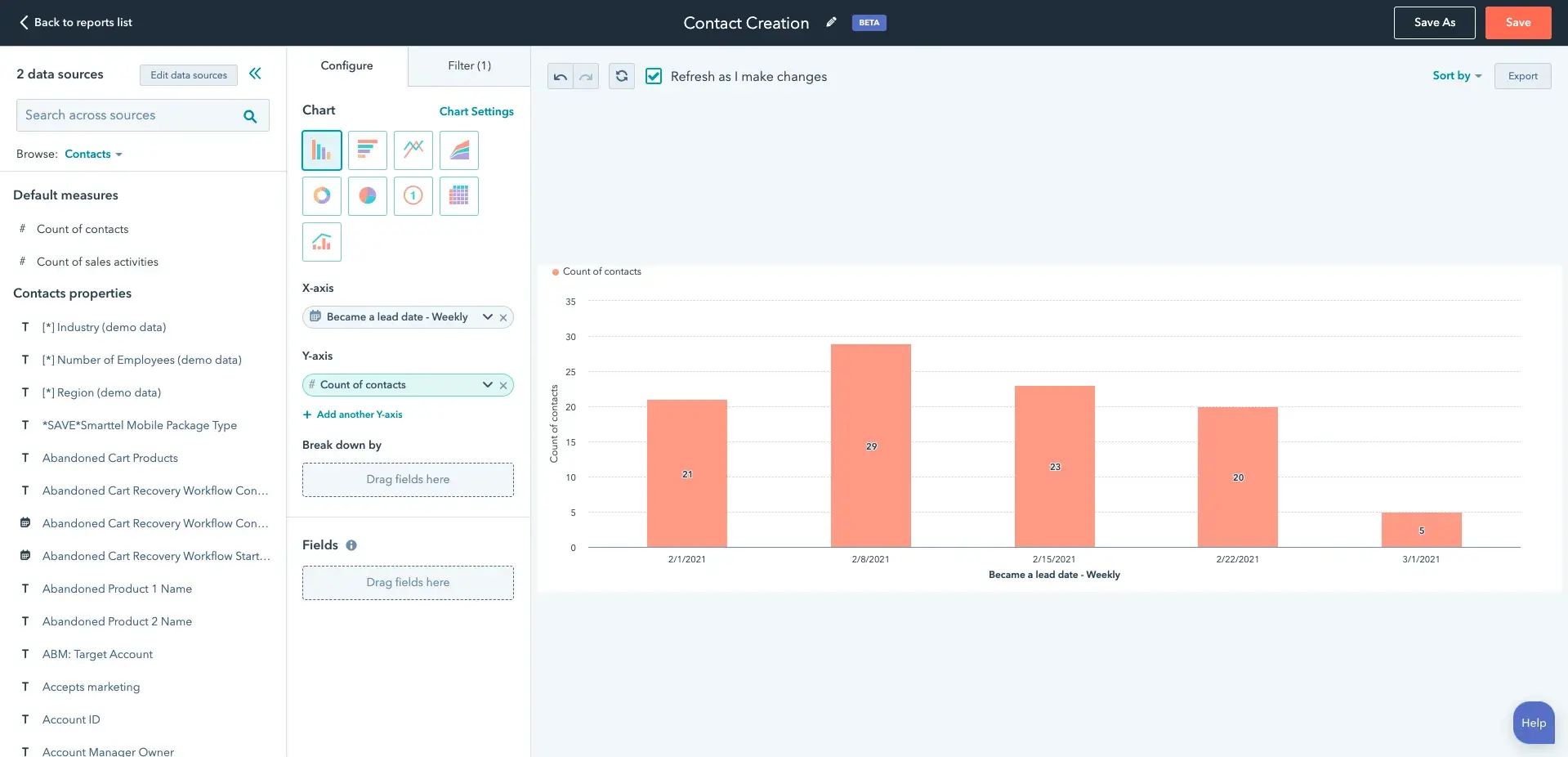
Get full visibility into your sales process with HubSpot’s free sales reporting.
5. They track all prospect interactions to learn what works and what doesn’t.
I’ve sometimes noticed that we’re typically very focused on what a lead or prospect does, but they’re not always the most important data points. Or, at least, I have found a wider look can paint a more complete picture. A data-driven sales team treats every prospect interaction with equal importance. Whether a prospect never responds or becomes a customer, every interaction can give your sales team valuable data and insight into what’s working.
Prospect interactions can tell you a few important things:
- Where that prospect came from.
- Why your sales rep reached out in the first place.
- How your sales rep made contact and what form of communication they used.
From initial contact, you can also track either 1) the sales cycle for the specific prospect or 2) which competitor you lost the prospect to. You can also gather demographic and psychographic information from each prospect who becomes a customer to further build out your buyer personas.
6. They only engage with leads and prospects that fit certain criteria.
A data-driven sales team only pursues leads and prospects that prove to be good-fit customers — something that proper data can tell them. As I said above, sales data has the potential to save your sales team precious time and energy, as well as make your company more profitable.
To do this, your team must make use of the data it collects. Once you qualify good-fit leads, your team should know what data to look at to understand whether they should engage a new prospect. Perhaps you’ve defined a good-fit lead as a customer with a certain monthly revenue as well as a certain minimum of marketing team members. Encourage your team to focus their energy on prospects that fall into this category.
7. They communicate about best practices and approaches that don’t work.
A data-driven sales team is constantly sharing best practices with one another. Perhaps one of your sales reps has learned a new way to use their sales data. Perhaps another has found a new approach that almost always guarantees a prospect response.
Regardless, your sales team should always be chatting about their best practices and approaches that don’t quite work. I recommend sharing this information through team-wide meetings or via one-on-ones between managers and reps.
Not only will this strengthen morale and act as a means of sales coaching and training, but I find it helps you continually keep your data — and how you use it — up-to-date. Sales data is an iterative process, and your sales team can help you constantly improve on how you use and apply it.
Sales Data Helps You Grow Better
From teams who are so overwhelmed with data they can’t see the woods from the trees to those who are intimidated by even the thought of looking at detailed reports, I’ve seen every variation of a team that wants to be data-driven but doesn’t know how.
What I’ve learned is that business objectives and working backward are both key. There’s also no harm in starting with what you have and letting the next questions that come up naturally guide the way.
At all times, keep focused on insights over data. If the data is telling you a story as opposed to gathering dust, you’ll be much better equipped to make decisions and showcase your performance.
Editor’s note: This post was originally published in July 2020 and has been updated for comprehensiveness.
![]()
Onboarding New Sales Res — See the Sales Manuals and Templates That Can Help You Get It Right
Picture hiring a promising sales rep. But three months in, they quit. Sound familiar? You’re not alone — 52% of top sales hires quit because of poor sales training or onboarding. On top of this, Ann Clifford, founder and president of Safari Solutions, notes that […]
SalesPicture hiring a promising sales rep. But three months in, they quit. Sound familiar? You’re not alone — 52% of top sales hires quit because of poor sales training or onboarding. On top of this, Ann Clifford, founder and president of Safari Solutions, notes that it takes three to nine months for new sales hires to hit their quotas.
Both situations put hiring resources and future company revenue at stake. The solution? A structured sales onboarding plan. Having the right training process that avoids turnover and grows revenue can allow you to keep great talent longer.
That may seem easier said than done. But, don’t worry. I spoke to several sales leaders to get their tips and tricks. Below, I’ll also share some of my favorite training materials and onboarding templates that can help you get a new team member started. Let’s dive in.
Table of Contents
- Why Invest in Salesperson Training?
- Stages of the Sales Onboarding Process
- Making the Most of a Sales Manual
- Sales Manual Examples
- Best Practices for Training Salespeople
- Make Your Sales Training Worthwhile
Why Invest in Salesperson Training?
HubSpot research found that the average sales rep tenure at a company is 18 months. With such a short window, developing efficient onboarding and training resources is crucial for hiring managers. Beyond that, orientation and sufficient product knowledge are keys to having successful sales representatives who stay far beyond the year-and-a-half mark. Other benefits you get from training your reps include:
- Improved productivity. Every day counts in sales. The earlier you train your new reps, the faster they ramp up and start hitting their quotas.
- Better sales conversations. Instead of using generic pitches, trained sales reps learn how to ask the right questions, actively listen, and tailor their messaging to each prospect’s unique needs, leading to more meaningful and productive discussions.
- Higher conversion rates. Sales training helps reps master key techniques like objection handling, value selling, and closing strategies, enabling them to turn more prospects into customers with confidence.
- Consistent and scalable performance. A well-trained sales team follows proven frameworks and best practices, ensuring consistency across the organization and making it easier to scale and onboard new reps successfully.
Featured Resource: Sales Training Manual
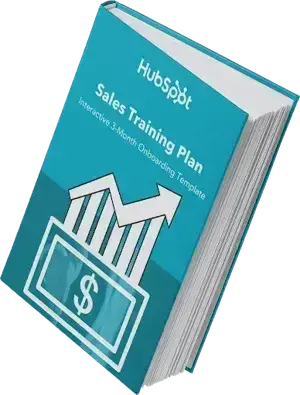
Stages of the Sales Onboarding Process
Sales onboarding involves new salespeople and giving them all the tools they need to interact with buyers. A strong sales onboarding process should boost your salesperson’s confidence and help them get results quickly.
I’ve found that teams, including ours at HubSpot, look at a few different time frames when creating their onboarding plan. We’ll cover the following below:
- Pre-week onboarding.
- First 30 days.
- First 60 days.
- First 90 days.
Stage 1: Pre-Week Onboarding and Day One
You might think training starts on a new employee’s first day. However, successful sales teams start even earlier. If you want your new hires to come confident, consider pre-week onboarding. This can be an email, course, or quick video that gives your sales representatives more information on their roles and what they’ll learn during training.
Pre-week onboarding can help set expectations, that way your new hire isn’t left in the dark. Here’s what we do at HubSpot.
Before their official first day, new HubSpot sales hires experience “a day in the life” of a sales representative. In just 20 minutes, a new hire can see what their work will look like as a member of the sales team. From technical setup to call observation and activity shadowing, new representatives get an up-close look at the end goal of their training period.
Here are a few other items that we send along to new hires before their first day.
Email and Administrative Preparation
Whether your team works remotely or in the office, you need to get new hires’ tech set up so they can open up their laptop and get started. HubSpot’s people team makes sure that our new reps have email and relevant app access before the first day of work.
With a rep’s email, we can send new hire HR information ahead of time, as well as an agenda for training sessions. Having all of the relevant meetings already on their calendar helps our new team members know where to go and who to meet.
Pro tip: Be sure to remind your new hire to select a picture for their email and create an email signature.
Day One: Orientation
The first day at a new job is like starting at a new school. You need to set aside time for new-hire orientation. At HubSpot, that includes one week of Foundations, a week-long set of sessions that help new hires learn about the company. After, there’s up to a week of department-specific training, allowing our reps to learn about the sales team specifically.
Your organization may not be able to dedicate a week and a half to foundational training. However, I highly recommend allowing one day for orientation. That allows your new reps to find and resolve any tech issues, learn about the company’s mission, and take an initial dive into the offering you sell.
Pro tip: Use the first day to take care of HR documentation, set them up with a computer, and introduce them to the company at a high level.
From there, you can set up one-on-one time with direct managers. That should include a coffee chat on day one, something I found helpful when I started at HubSpot. Later in the week, I met with my manager again to discuss my 30-60-90-day plan.
Another helpful program at HubSpot? We encourage new hires to have lunch with a veteran HubSpotter to learn more about the company. New hires also get a chance to ask a senior sales leader questions so they can get a better sense of what to expect.
Pro tip: Before day one, assign each new rep a “Welcome Buddy” who informally checks in with the new hire. They could answer questions and ensure the rep feels supported. This small step can reduce first-week anxiety and foster a sense of belonging right away.
Stage 2: First 30 Days
The first month (30 days) for your new hire circles around learning about the company, available solutions, the internal organization, and their role. Here are a few topics you should cover in the first 30 days.
1. Company Culture and Mission
In the early stages of the sales training, you want to introduce your new sales member to the company and its values. The goal here is to make sure they fully grasp why your company exists and how you serve your customers.
Culture is a big part of getting the message across. If openness and collaboration matter to your sales team, new hires should see it in action during onboarding. Your new team members should feel comfortable asking any questions that come to mind. Reps who have been along for longer should guide the way.
“The social aspect of onboarding often doesn’t receive the attention it deserves,” says David Rubie-Todd, co-founder and marketing head at Sticker It. Social connections and company culture can differentiate your company, showing that you have an environment where the employee can thrive.
“For instance, organizing meet-and-greet sessions with colleagues or assigning a mentor can greatly facilitate the transition for new employees, helping them to feel a sense of belonging and camaraderie quickly,” Rubie-Todd says.
Rubie-Todd also notes that these cultural components create an atmosphere where employees can grow personally and professionally.
2. Understanding the “Why” Behind the Sales Process
One of the most important parts of training and onboarding new sales hires is helping them understand the “why” behind their new role.
Scott Williamson, vice president of sales engineering at R. Williamson & Associates, warns, “It’s easy to teach someone the steps of the sales process, but helping them understand the reasoning behind it is crucial for their long-term success.”
Like Rubie-Todd, Williamson focuses on company values and the mission. Williamson says, “I want the new hire to understand why we exist and who we serve. This provides context for everything else they will learn.”
From there, Williamson’s team dives into the details of their sales methodology.
“As we review things like prospecting techniques, objection handling, and closing — I share stories and examples that illustrate why we do things this way. The reps who truly grasp the why end up internalizing it and selling with more passion and effectiveness,” Williamson says.
3. Product or Service Training
What will your rep be selling? Whether it’s pool supplies or software, it’s important to train them on how to administer, use, and see the value of your product or service. Proper product or service training lets new sales hires articulate the benefits of your products to address buyers’ unique needs.
At HubSpot, our new hires undergo extensive product and Inbound Marketing training. They learn how to use HubSpot products, like our CRM, Marketing, and Sales tools. The hands-on training involves building landing pages, setting up contacts, and presenting “final projects” at the end of their training cycle.
I love the time spent actually using our product. The projects built throughout training allow reps to show off their understanding of HubSpot tools. Managers can also gauge new hire progress.
Josh Ladick, president at GSA Focus, emphasizes product training in sales training. Ladick says, “Product knowledge and customer-engagement strategies are the fundamentals that empower new hires, giving them confidence and clarity when interacting with clients.”
Pro tip: Encourage new reps to use your product or service themselves as much as possible. First-hand experience builds confidence and allows them to speak authentically about how your solution solves customer pain points.
4. Gaining an Understanding of the Market
A successful sale often comes down to BANT: Budget, Authority, Need, and Timing. While determining budget and handling general price objections can be pretty straightforward for an experienced representative, the other three components require familiarity (and perhaps intimacy) with both the buyer and the market. Here’s why:
- Authority. To establish authority with the prospect, the representative must understand your position in the market: your strengths and weaknesses, as well as those of your competitors.
- Need. The representative must also develop competency in mapping those strengths and weaknesses to prospect pain points to qualify for (and prove) fit.
- Timing. Gauging the prospect’s timing, knowing customer and sales lifecycles, and developing a nurturing and follow-up process that works with those life cycles are crucial for getting the timing just right.
Getting the last three elements of BANT takes experience and training. Once a new hire understands who you’re selling to and what their needs are, you can more easily adapt your selling methods to these areas.
Stage 3: First 60 Days
Once the sales representative completes their “information gathering” period, it’s time to give them hands-on experience. During this time, managers should empower new reps to improve their comfort level with the selling process. Reps should also work on developing sales processes and routines. Here are some helpful tactics to get you there.
Job Shadowing
An effective way to onboard a new sales rep is to pair them with one of your seasoned team members. This gives insights in real-time and lets them learn by watching. Have the new employee listen to calls, ask questions about workflow, and get a sense of the team’s strategy.
One-on-One Feedback
This training method pairs a new hire with a senior team member for individualized coaching. The personalized approach allows the new salesperson to receive direct feedback, tailored guidance, and mentorship that aligns with their strengths and areas for development.
Peer Training
Peer training involves a new hire learning directly from a colleague at their level rather than a senior leader. This method fosters collaboration, helps the new employee build relationships within their team, and creates a comfortable learning environment with less pressure. It also ensures that new hires quickly adapt to the team’s daily workflows.
Roleplaying
Conducting roleplays during sales training helps new reps practice conversations. A team member acts as a prospective client, and the new rep can test different approaches to see what works for them.
This interactive method sharpens key skills such as objection handling, negotiation, and active listening. It also promotes teamwork and prepares the new sales representative for real-world scenarios.
Prospecting and Introductions
Your new hire is likely going to work with some accounts already on the books. In some cases, they may be replacing an employee who has left, inheriting multiple clients. The representative should introduce themselves to points of contact for accounts that already exist. Beyond that, it’s time for your new rep to do some initial prospecting and outreach to begin filling their pipeline.
Performance Reviews
Conduct regular reviews with sales representatives to give constructive feedback, recognize achievements, and identify areas for improvement. Assess rep individual and team performance by focusing on key metrics, such as conversion rates, quota attainment, and sales cycle length.
This doesn’t have to be as formal as your team’s annual performance review. The goal here is to update the rep on their onboarding progress.
Stage 4: First 90 Days
After 60 days, the representative should be comfortable and autonomous enough to apply their training and start making an impact as their pipeline opens up. Managers should ensure that new reps have everything they need to:
- Establish a schedule that’s aggressive but works for the rep.
- Meet with prospects and develop relationships.
- Navigate the process, hit KPIs, and crush goals.
Once you’re sure your representatives are ready to hit the ground, here are some of the last things I suggest you do.
Set clear expectations & goals.
Set 30-, 60-, and 90-day goals. Calculate ramp rate based on the average number of months it takes a new salesperson to hit 100% (or close to) of quota. To make this more accurate, segment an average ramp period by experience. For example, it might take the typical veteran salesperson four months to ramp, while a freshly minted college grad requires nine months.
Establish a new-hire mentor.
Sales onboarding can be challenging. You can lessen the challenges by assigning a mentor to help beyond your initial training period. At some organizations, a mentor is a more senior rep who can inspire new hires. At other companies, mentors are at the same level but have spent more time in the role, offering peer-to-peer advice.
Mentees can bounce questions, comments, and growing pains off their mentors. Mentorship provides new hires with perspective, guidance, and advice from someone outside their management team.
At HubSpot, new hires get paired with a mentor. Beyond the first few weeks, mentors can offer career advice, make important networking connections, and save salespeople from burnout. In my experience, pairing new hires with mentors sets them up for a longer, happier career with your company.
Making the Most of a Sales Manual
A sales manual is a guide that contains the background information of your company, the goals you want to achieve, and the selling process. These documents are a great way to standardize your sales agents’ orientation program.
You want to create a sales manual that becomes the go-to guide for new sales personnel. Naturally, the manual will guide them through their entire onboarding process. The manual should provide details about their job and technology access. A good sales manual also describes your target client and how to talk to them, as well as the do’s and don’ts of your selling process.
Pro tip: Sometimes, a sales manual will include technical guides, like how to log in to certain software or how to access a sales dialer. You can create these parts quickly and painlessly using HubSpot’s free Guide Creator, which captures step-by-step instructions with images.
Regularly update your sales manual based on feedback from new hires. If reps frequently ask the same questions or struggle with a particular process, refine the manual to address those gaps proactively.
Sales Manual Examples
Every sales training manual is different based on what the company sells, as well as its goals and objectives. Here are four examples of sales manuals you can use as a guide to write yours.
1. HubSpot Sales Training Manual [PDF]
HubSpot has an elaborate onboarding process for its sales agents. The entire process takes 90 days. In the first 30 days, sales agents learn about HubSpot, our selling systems, solutions, customers, and everything else about what we offer.
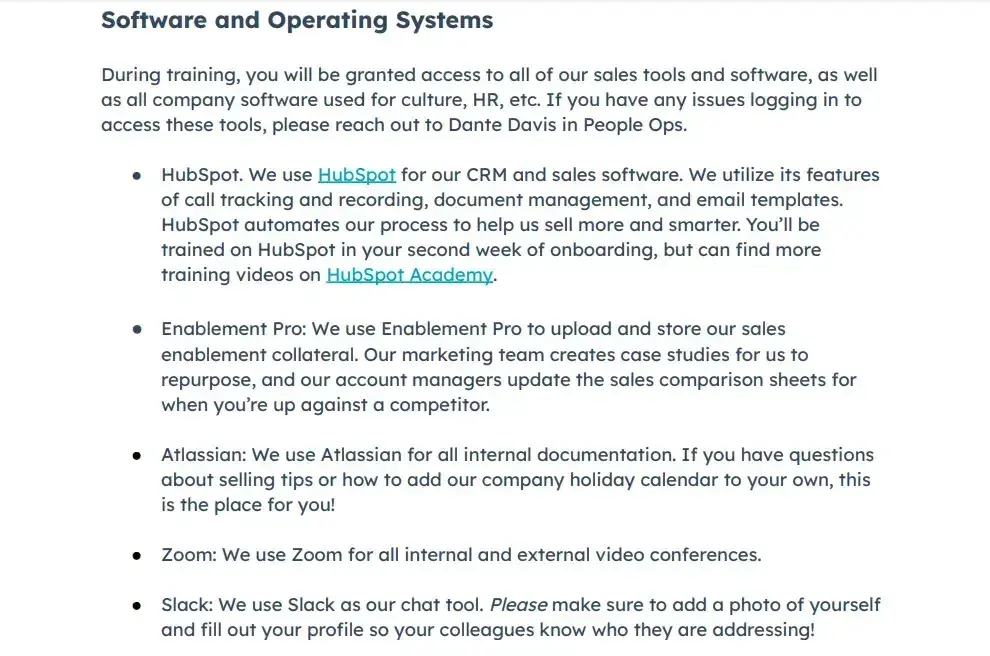
For the next 30 days, the sales agent gets what I’d describe as a “trial process.” They start their sales journey by applying the concepts, principles, and lessons that they’ve learned. This is when an agent fashions their style through experimentation.
After 60 days, the sales agents are ready to work officially. The sales manager sets key performance indicators (KPIs) for the agent and provides what they need to achieve them. On the 90th day, the agent can monitor their progress and see what they can change for better results.
For more details on the 30/60/90 method, download the HubSpot Free Sales Training Manual.
What I like: HubSpot’s sales manual makes expectations clear for each milestone. Reps can easily benchmark where they are in the process and if they’re falling behind.
2. Jibu Sales Training and Development Guide [PDF]
Jibu is a drinking water company with over 160 franchises in eight African countries. It has sold over 490 million liters, so it’s doing something right. One element of its success? Jibu’s sales agent training guide.
The sales manual template is split into two sections. The first part contains the company’s background information. This allows the sales agents to connect with the company and understand how things run across the organization. It includes:
- What sets Jibu apart from its competitors.
- Who Jibu’s customers are and why they love Jibu.
- Jibu’s production technology.
- How Jibu settled on their price range.
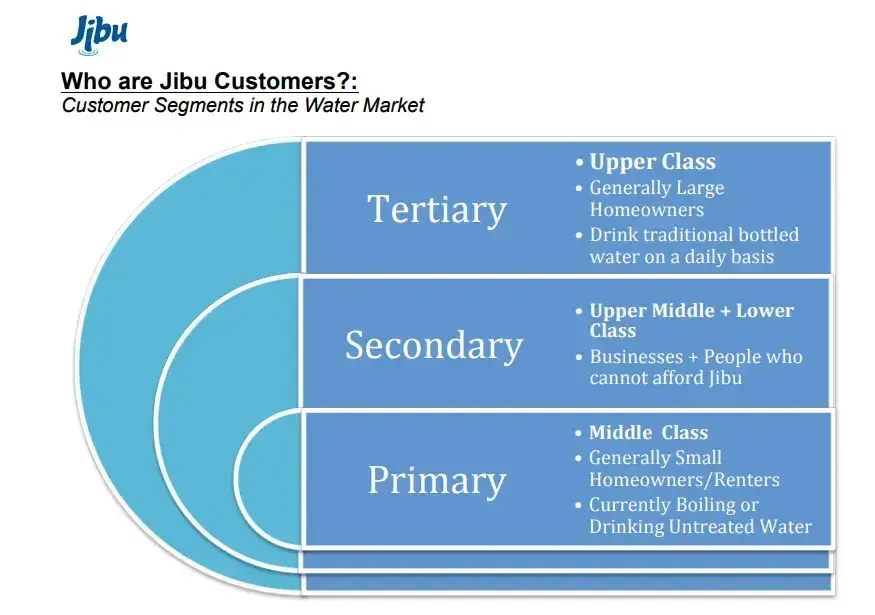
The second part of the sales agent guide covers the selling process. Some things that the sales agent learns in this part include:
- The difference between marketing and sales.
- The different types of Jibu customers.
- How to engage with customers.
- What to avoid in sales.
This part is crucial in ensuring that sales agents understand the company’s expectations on how they should carry themselves.
Check out the Jibu Sales Training and Development Guide PDF to see all the details.
What I like: This manual includes information about the company’s mission. This information can inspire reps, getting them fired up to sell. They’ll also know more about what sets Jibu apart so they can close deals more successfully.
3. Badger Sales Training Manual [PDF]
This guide is ideal for a newbie in the sales department. Badge Sales Training Manual provides a comprehensive guide on all the basics of sales training. It defines sales and teaches you how to go about it.
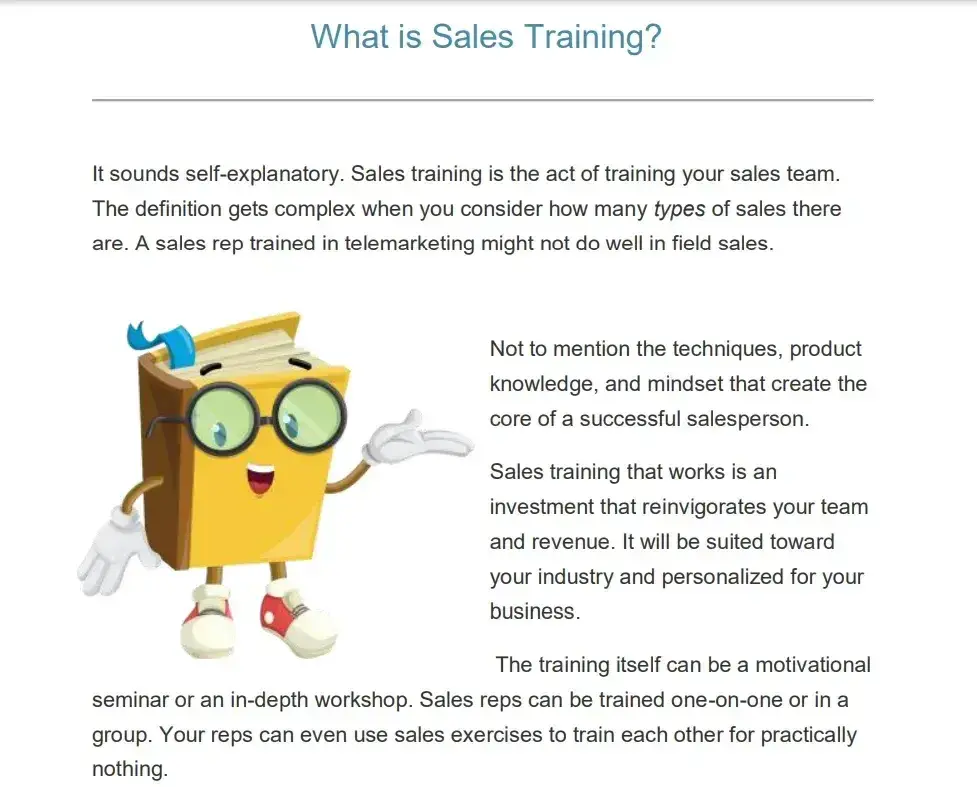
In this guide, you’ll learn hacks like how to cut the sales training program time by 50%. This will ensure your sales agents are effective and you don’t spend months in the training session without getting results.
The Badger sales manual also teaches selling methods to ensure you choose those aligned with your products or services. Check out the Badger Sales Training PDF to learn the rudiments of sales.
What I like: This guide describes which sales tasks can be automated and by what tools. This manual can help you save time from the get-go so reps can close deals faster.
4. Trojan Labor Sales Training Manual [PDF]
Trojan is a subsidiary of Hire Quest Direct that has been in the industry since 2002. They help companies look for workers in any field — most of whom are temp employees. Trojan has an intensive sales manual training guide that teaches its sales agents everything they need to sell its staffing services.
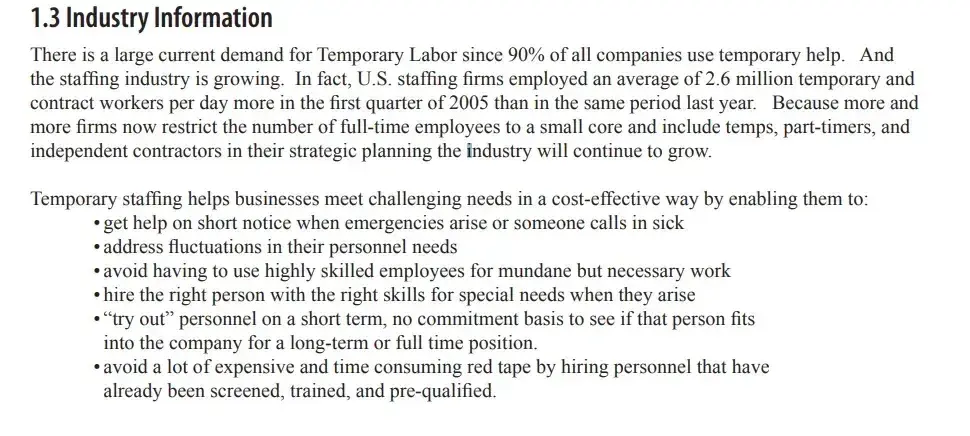
The manual also teaches the agents the importance of not over-glamorizing their services to manage the customers’ expectations. It also guides agents on what to do once a customer makes an order and the correct follow-up messages.
What I like: Trojan’s sales manual shares email and call templates their agents can use in different scenarios, making work easier for new recruits.
Best Practices for Training Salespeople
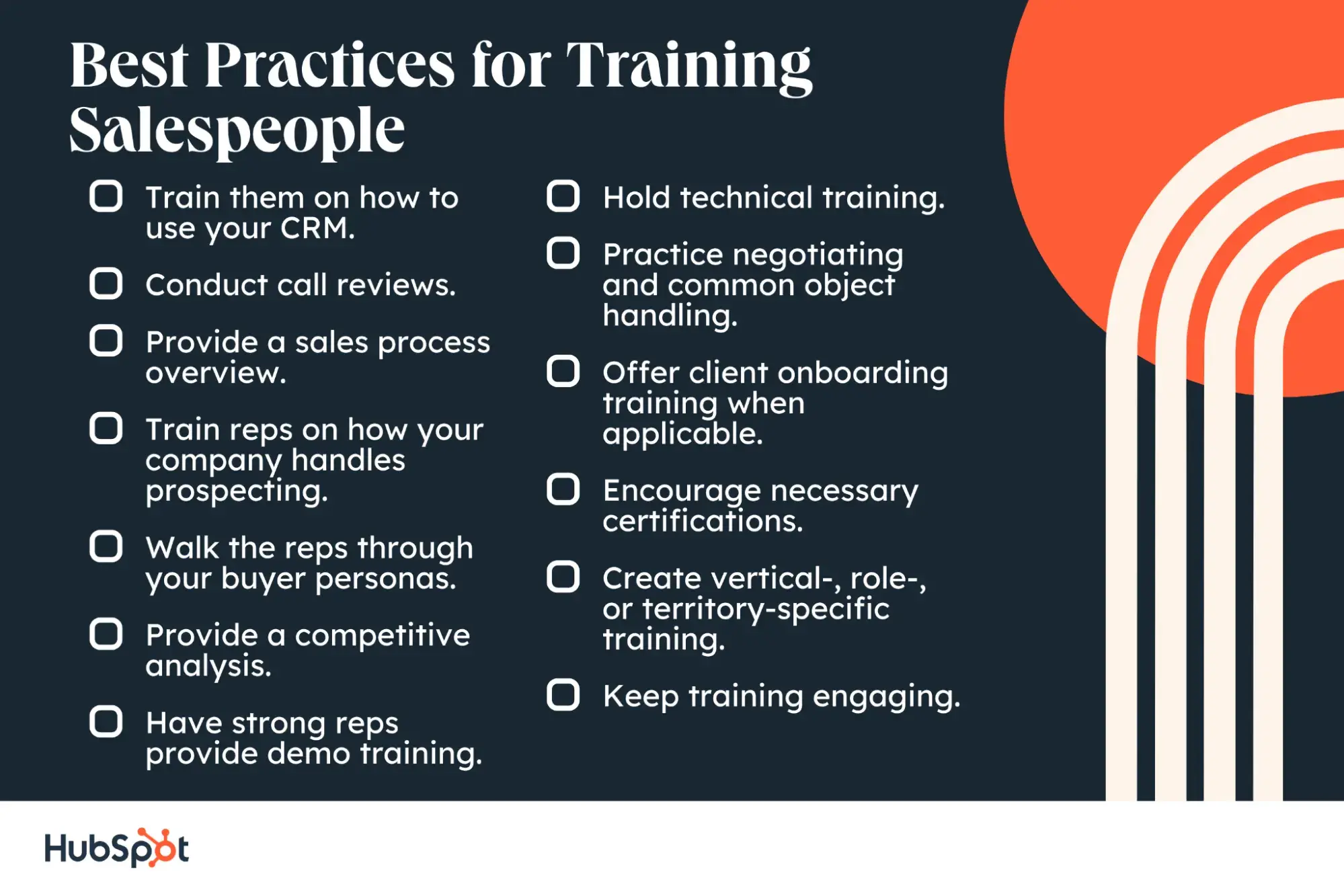
1. Train them on how to use your CRM.
Your CRM is where you log calls, deals, and account information. Your reps use it every day, so you should spend real time getting new hires comfortable with the platform.
Include hands-on, project-based training such as entering new contacts, setting reminders, and logging communication. When appropriate, have them take a CRM certification exam. Most CRMs offer them, and it’s a great way to ensure new reps understand how to use the software.
You can find HubSpot’s free certification courses here.
2. Conduct call reviews.
Before your reps fly solo put multiple call reviews on the calendar. This can either be synchronous, with a manager sitting in the room with the rep listening in, or asynchronous by using a call recording platform. Managers can see how the call went and give helpful tips on how to improve.
You can also have new reps check out calls from your top performers. In my experience, this experience can be aspirational and expose new reps to tactics they may not have considered before. New hires can also learn from a variety of experience levels and a wider range of critiques.
3. Provide a sales process overview.
Cover the main stages of the sales process and conversion rate benchmarks (on average, 10% of emails convert to connect calls, 20% of connect calls convert to discover calls, etc.). This will tell your new representatives where to prioritize efforts and what numbers they’ll be held to.
Playing the numbers game varies from business to business. This is a good time to share how your company performs in the market and the challenges of selling your specific offering.
4. Train reps on how your company handles prospecting.
How does your company prospect? Share common channels, number of touchpoints, and best practices. Outline how much research representatives should conduct and which details they should look for.
If you have any helpful templates or tools to automate some of the research process, be sure to share them. This can give your new rep a leg up.
5. Walk the reps through your buyer personas.
Describe your ideal customer. If you’re a B2B company, teach your salespeople what a best-fit company looks like and which contacts they should try to get. If you’re B2C, describe the consumers that reps should target. I also recommend you lay out the foundation for how your organization assesses and communicates with decision-makers.
6. Provide a competitive analysis.
During the training process, make the time to orient new hires to your industry. That includes describing your competitors and what makes your offering a standout. You can either share a competitive analysis or turn the process into an exercise, having reps research your company and discussing at the end.
Be honest about where your product/service falls short of the competition and where it outperforms the rest of the market.
7. Have strong reps provide demo training.
Incorporate good and bad examples into demo training and have everyone participate in role-play. Conduct reviews of new hire demos, connect calls, and close conversations. Include common objections that arise during your sales process, and let new hires respond to those objections before supplying them with ready-made scripts.
My rule of thumb is to provide positive feedback first, then move to areas for improvement. Foster this rule in your sales organization to create a team that embraces constructive criticism instead of being afraid or resentful.
8. Hold technical training.
Learning to use team or company technology (i.e., phones, video platforms, etc.) can be a tough and undocumented process. Train new hires on using your technological resources, and have them showcase their skills during a demo with you.
When they can troubleshoot basic issues — like asking prospects to mute their microphones if an echo arises during a presentation — they’re one step closer to being ready for a live call.
9. Practice negotiating and common object handling.
Even experienced representatives need to know how a company approaches the negotiation phase. What are your parameters for discounts and sales? What kind of judgment calls can your representatives make in terms of discounts? And, what is the etiquette for discussing these topics with prospects?
When buying a new car, I was paired with a new sales rep. I kept saying no to maintenance plans until the final offer — a deal so good that it didn’t even cover the cost of oil for regular changes. When the rep’s manager came in, he was genuinely surprised (if not a little annoyed) by the low cost of my plan.
The lesson here? Make it very clear what salespeople can and cannot offer to prospects. You don’t want to severely undercut your offering.
10. Offer client onboarding training when applicable.
Will your representatives be in charge of onboarding new clients? In some cases, this responsibility falls to the customer success team. At smaller organizations, salespeople may work with clients on implementation.
Your new hire should know exactly where their role ends. If their job includes onboarding, share a checklist of what they need to guide clients through. If there’s a hand-off to a renewal manager or customer experience representative, ensure both parties should understand that process.
11. Encourage necessary certifications.
While this is not required in every role, I believe that certifications can be a helpful part of the new hire journey. Here at HubSpot, representatives are certified in inbound sales and inbound marketing. These reps also become certified in giving HubSpot demos. I’ve seen that really successful reps understand how these ideas work, customizing the inbound methodology to their personal sales processes.
So my recommendation? At the end of sales training, hold a certification exam for new reps. Certain passing scores must be met and managers are notified if further training is necessary.
12. Create vertical-, role-, or territory-specific training.
Everyone should move through basic sales training to understand the goals, values, and customers that your sales organization prioritizes. From there, you need to provide relevant supplementary training for role-specific duties.
Your manual for an account executive should be different from a business development representative. If you’re bringing in a manager or executive, further training may be required to set them up for success. Any manuals or training materials should be tailored to each specific role.
Beyond that, you’ll want to localize training. HubSpot is a global company. I’ve heard from sales leaders across the organization that winning tactics vary by market. You need to train your reps on specific verticals or territories they’ll be targeting (i.e., when prospecting in the Pacific Northwest, phone calls convert at a higher rate than emails).
13. Keep training engaging.
I’ve found that a good training process accounts for different learning styles and preferences. Use a range of sales training games and activities to keep your training engaging for all. Create a questionnaire to get feedback after training sessions to understand what the team liked and disliked about each session so you can develop your onboarding as you go.
Make Your Sales Training Worthwhile
Ramping up in sales is tough. But if you do it right, you’ll see big benefits. I’ve seen it right here at HubSpot. Reps who know how to sell drive revenue. Beyond that, the reps I’ve spoken to note that they’re more likely to stick around at companies where they feel supported by their managers.
Reps here have told me that they appreciate the company’s Foundations orientation program. They’ve learned from mentors and call reviews. These structures help them learn more about our product and processes, making their initial ramp smoother.
So, don’t skimp on new rep onboarding. Get it right, and you’ll enjoy the benefits of talent retention, high morale, and a high-quality sales strategy.
Editor’s note: This post was originally published in August 2019 and has been updated for comprehensiveness.
![]()




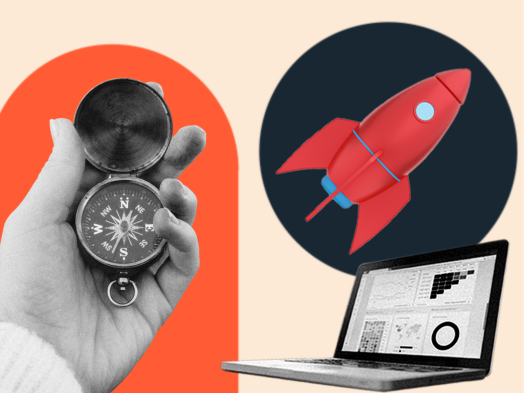








![Download Now: The Annual State of Artificial Intelligence in 2024 [Free Report]](https://no-cache.hubspot.com/cta/default/53/b72f2b25-8cc9-4642-9a1b-1e675d3d273b.png)

![Download Now: 50 Sales Email Templates [Free Access]](https://no-cache.hubspot.com/cta/default/53/be67aa79-8dbe-4938-8256-fdf195247a9c.png)
![Download Now: Keyword Research Template [Free Resource]](https://no-cache.hubspot.com/cta/default/53/447dd5f8-1426-4fb6-af75-b6e55bb759a2.png)


![Download Now: 2024 Sales Trends Report [New Data]](https://no-cache.hubspot.com/cta/default/53/9cdc68ed-d735-4161-8fea-0de2bab95cef.png)
